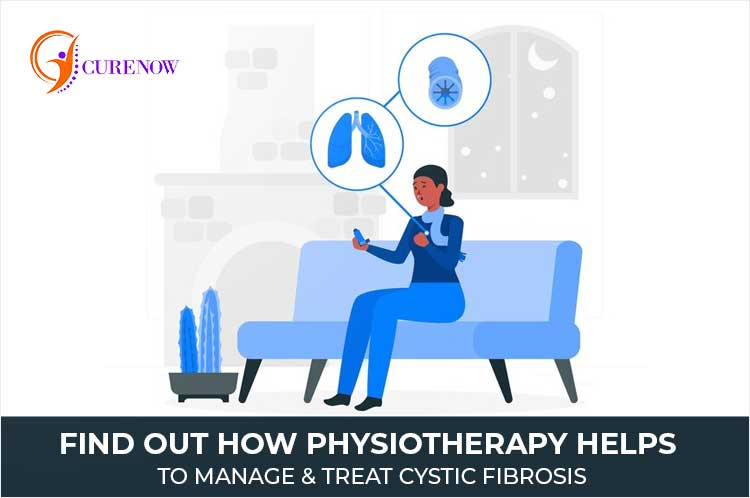
- 21 Dec 2023
- |
- By Admin
Find Out How Physiotherapy Helps To Manage & Treat Cystic Fibrosis
Cystic Fibrosis (CF) is a genetic disorder that primarily affects the respiratory and digestive systems.
Characterized by the production of thick, sticky mucus, CF can lead to various complications, impacting the lungs, digestive tract, and other vital organs.
In this blog, we'll delve into what cystic fibrosis is, its symptoms, and how physiotherapy emerges as a key player in managing and treating this complex condition.
Understanding Cystic Fibrosis
Cystic Fibrosis is a genetic condition caused by mutations in the CFTR gene, leading to the production of thick and sticky mucus.
This mucus can clog airways, trap bacteria, and cause chronic lung infections. Common symptoms include persistent cough, difficulty breathing, recurrent lung infections, and digestive issues such as difficulty gaining weight and absorbing nutrients.
Physiotherapy for Cystic Fibrosis
Physiotherapy plays a vital role in the multidisciplinary approach to managing and treating cystic fibrosis. Here's how physiotherapy benefits individuals with CF:
Airway Clearance Techniques
Physiotherapists employ specialized techniques to help loosen and remove the thick mucus that accumulates in the lungs. This aids in preventing respiratory infections, improving lung function, and reducing the risk of complications.
Physical Activity for Overall Health
Regular physical activity, under the guidance of a physiotherapist, can significantly improve lung function, heart health, bone density, muscle strength, blood sugar control, and overall well-being in individuals with CF. Tailored exercise programs are designed to address specific needs, promoting a healthier lifestyle.
Managing Sinus Disease
Physiotherapy interventions include techniques to manage sinus disease, a common complication of CF. These may involve sinus drainage exercises and therapeutic interventions to alleviate symptoms and improve sinus health.
Assisting with Inhaled Treatments
Physiotherapists work closely with individuals using inhaled treatments to ensure proper technique and effectiveness. This collaboration maximizes the benefits of medications, promoting optimal lung health.
Oxygen Therapy Support
In cases where oxygen therapy is required, physiotherapists provide support and education on its proper use. They help individuals adapt to oxygen therapy, ensuring comfort and efficiency in their daily lives.
Treatment of Joint, Bone, and Muscle Issues
Cystic fibrosis can affect the musculoskeletal system, leading to joint and muscle problems. Physiotherapy addresses these issues through targeted exercises and interventions, improving mobility, reducing pain, and enhancing overall physical function.
Improving Posture
Physiotherapists focus on improving posture, which can be compromised in individuals with CF due to various factors. Correcting posture not only enhances breathing mechanics but also contributes to overall comfort and well-being.
Bladder Function
Physiotherapy includes techniques and exercises to address issues related to bladder function, helping individuals manage and improve symptoms of bladder leakage.
Physiotherapy stands as an invaluable component in the comprehensive care of individuals with cystic fibrosis. By addressing specific symptoms and complications associated with CF, physiotherapists play a crucial role in enhancing the quality of life for those affected.
If you or a loved one is navigating the challenges of cystic fibrosis, consider incorporating physiotherapy into your healthcare plan for a holistic and personalized approach to managing and treating this genetic disorder.
Schedule an appointment with our UK-trained and certified Physiotherapists at CureNow, and find out more about the benefits of Physiotherapy for treating and managing Cystic Fibrosis.
Visit us at CureNow.in now.
CureNow Wellness Pvt. Ltd.
F-Residences, Shop # 25, First Floor, Wadgaon Sheri, Kalyani Nagar Annexe, Pune - 411014, Maharashtra
Mobile No : 9545345300
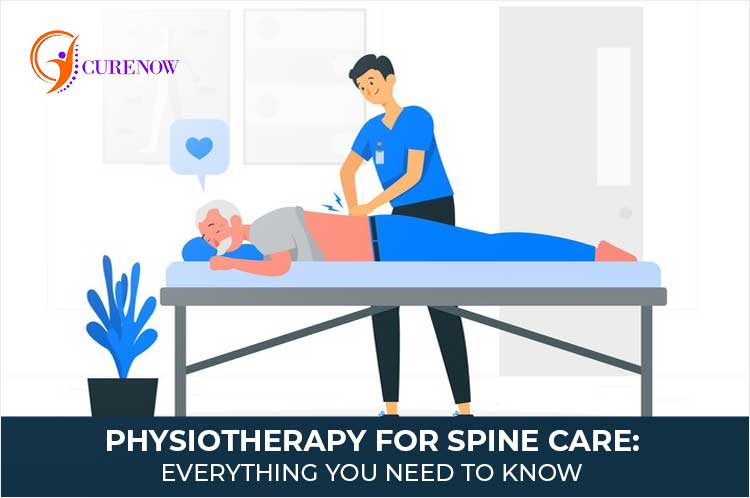
- 07 Dec 2023
- |
- By Admin
Physiotherapy For Spine Care: Everything You Need To Know
The spine is a remarkable structure that plays a crucial role in supporting our body and facilitating movement.
However, various factors such as poor posture, sedentary lifestyles, and injuries can lead to spinal issues, causing discomfort and hindering our daily activities. In this blog, we'll explore common spinal conditions, their symptoms, and the role of physiotherapy in spine care.
Common Spinal Issues and Symptoms
Herniated Discs
Symptoms: Sharp pain, numbness, or tingling in the affected area, radiating pain down the limbs.
Sciatica
Symptoms: Shooting pain along the sciatic nerve, numbness or weakness in the leg.
Scoliosis
Symptoms: Visible curvature of the spine, uneven shoulders or hips, back pain.
Degenerative Disc Disease
Symptoms: Chronic pain, stiffness, reduced flexibility.
Physiotherapy for Spine Care
Physiotherapy is a non-invasive and effective approach to managing various spinal issues.
Here's how it can help..
Pain Management:
Physiotherapists use targeted exercises, manual therapy, and modalities like heat and ice to alleviate pain associated with spinal conditions. These exercises promote muscle relaxation and reduce pressure on affected areas, offering relief and improving overall comfort.
Improving Mobility:
Tailored exercises and stretches are designed to enhance the flexibility and range of motion of the spine. By incorporating these exercises into a regular routine, patients can experience increased mobility, making daily activities more comfortable and enjoyable.
Posture Correction:
Poor posture contributes significantly to spinal problems. Physiotherapists work with patients to correct posture issues through specific exercises and education. These exercises strengthen the muscles that support proper posture, reducing strain on the spine and preventing future issues.
Strengthening Core Muscles:
A strong core provides essential support to the spine. Physiotherapy programs often include exercises to strengthen the core muscles, promoting better stability and reducing the risk of injuries. Strong core muscles also contribute to improved balance and coordination.
Patient Education:
Physiotherapists educate patients on lifestyle modifications, ergonomics, and proper body mechanics to prevent the recurrence of spinal issues. This knowledge empowers individuals to actively participate in their spine care, fostering long-term health and well-being.
Physiotherapy Exercises for Spine Health
Pelvic Tilts:
Benefits: Pelvic tilts are effective for strengthening the muscles in the lower back and abdomen. They help improve the flexibility of the spine and can alleviate discomfort associated with conditions such as herniated discs by promoting proper alignment of the pelvis.
Cat-Cow Stretch:
Benefits: The cat-cow stretch is a dynamic movement that enhances the flexibility of the spine. It helps to alleviate stiffness, particularly in the mid to lower back. This stretch also engages and strengthens the muscles surrounding the spine, promoting better posture and reducing the risk of strain.
Child's Pose:
Benefits: Child's pose is a restorative stretch that elongates the spine, providing relief for conditions like sciatica and promoting relaxation of the back muscles. It helps stretch the entire back and shoulders while also encouraging deep breathing, which can contribute to stress reduction and overall well-being.
Physiotherapy plays a pivotal role in managing spinal issues by addressing pain, improving mobility, and promoting overall spine health. If you're experiencing symptoms related to spinal conditions, taking proactive steps through physiotherapy can make a significant difference in your quality of life.
Take the first step towards a healthier spine by booking an appointment at CureNow Wellness!
Our experienced physiotherapists are dedicated to providing personalized care to help you achieve optimal spine health. Visit CureNow.in to schedule your appointment and embark on the journey to a pain-free and active lifestyle.
Visit us at CureNow.in now.
CureNow Wellness Pvt. Ltd.
F-Residences, Shop # 25, First Floor, Wadgaon Sheri, Kalyani Nagar Annexe, Pune - 411014, Maharashtra
Mobile No : 9545345300
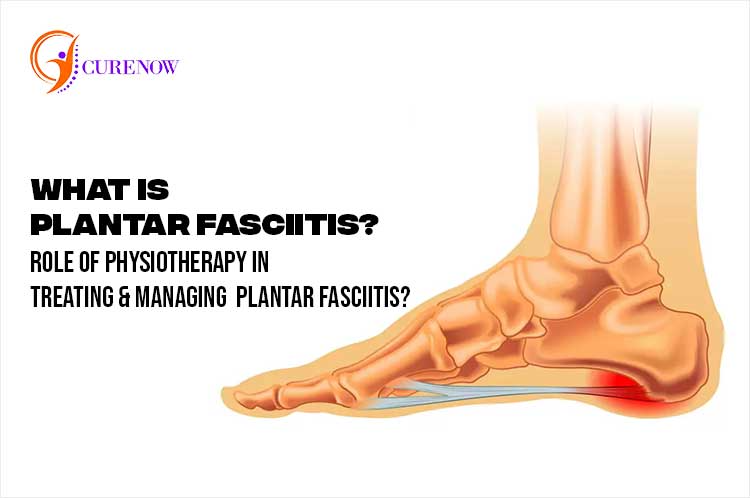
- 27 Nov 2023
- |
- By Admin
What Is Plantar Fasciitis? Role Of Physiotherapy In Treating & Managing Plantar Fasciitis?
Plantar fasciitis is a common cause of heel pain that affects the plantar fascia ligament in the foot. This thick band of fibrous tissue runs across the bottom of the foot and connects the heel bone to the toes. Plantar fasciitis causes stabbing pain in the heel, especially with the first steps in the morning or after long periods of rest. While the pain may resolve on its own, physiotherapy can play an instrumental role in treating and managing this uncomfortable condition.
What Causes Plantar Fasciitis?
Plantar fasciitis arises from small tears or inflammation of the plantar fascia. Factors that can contribute to this include:
- Tight calf muscles that put extra strain on the plantar fascia
- Excess weight/obesity which places added pressure on the feet
- High arches or flat feet that cause mechanical imbalances
- Sudden increases in physical activity like running or hiking
- Worn out shoes with inadequate arch support
- Heel spurs that irritate the plantar fascia
Symptoms
The typical symptoms of plantar fasciitis are:
- Sharp stabbing pain in the heel, especially when taking the first steps after resting
- Pain that is worse in the morning and slowly improves once the foot limbers up
- Lingering mild ache in the heel throughout the day
- Tightness or stiffness in the bottom of the foot
- Heel, arch, or foot pain that worsens with climbing stairs or long periods of standing
The Role of Physiotherapy
Physiotherapy employs various conservative treatment techniques to relieve pain, promote healing, and correct underlying imbalances causing plantar fasciitis. Common approaches include:
- Plantar fascia stretching exercises like flexing the toes or rolling the arch over a tennis ball
- Calf muscle stretches to reduce tightness and strain on the plantar fascia
- Massage and trigger point therapy to loosen tight bands and relax muscles
- Taping the foot to support the arch and take tension off the plantar fascia
- Orthotics or arch supports to improve foot biomechanics
- Strapping or night splints to passively stretch the plantar fascia overnight
- Extracorporeal shockwave therapy to stimulate tissue regeneration
- Ultrasound or cold laser therapy to reduce inflammation
- Gait analysis and activity modification to avoid re-injury
- Physiotherapy also focuses on building lower limb and core strength through exercises. This provides stability and takes pressure off the irritated plantar fascia. Simple home exercises may be prescribed along with clinic-based treatments.
Conclusion
In most cases, plantar fasciitis can be successfully treated with physiotherapy without surgery or injections.
However, it is important to get an accurate diagnosis and customized treatment plan. To assess your heel pain and start effective physiotherapy for plantar fasciitis, schedule an appointment with the certified physiotherapists at CureNow.
Visit us at CureNow.in to schedule an appointment with our UK-trained and certified Physiotherapists, and take the first step towards healing.
Visit us at CureNow.in now.
CureNow Wellness Pvt. Ltd.
F-Residences, Shop # 25, First Floor, Wadgaon Sheri, Kalyani Nagar Annexe, Pune - 411014, Maharashtra
Mobile No : 9545345300
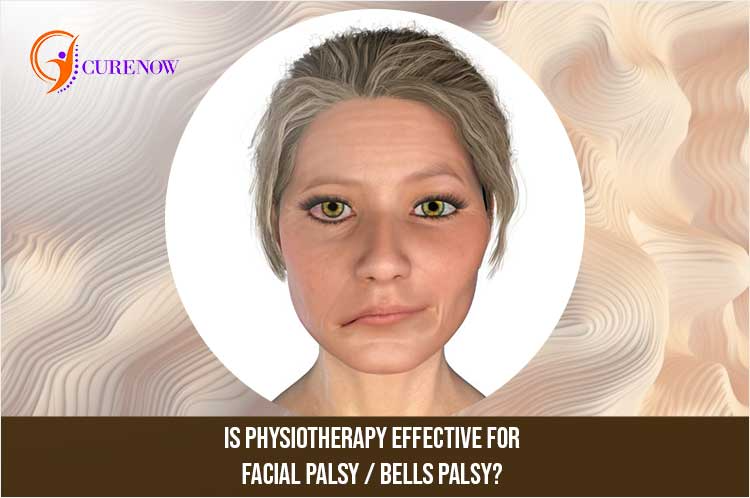
- 10 Nov 2023
- |
- By Admin
Is Physiotherapy Effective For Facial Palsy / Bells Palsy?
Facial palsy, also known as Bell's palsy, is a condition that causes temporary weakness or paralysis of the muscles on one side of the face. It results from damage to the facial nerve, which controls facial expression and movements. The onset of symptoms is generally sudden, with facial drooping, twitching, or numbness on the affected side. Bell's palsy is believed to be caused by inflammation or compression of the facial nerve. Viruses like herpes simplex are thought to be potential triggers. Other predisposing factors include diabetes, pregnancy, and autoimmune disorders. While facial palsy usually resolves on its own within a few weeks, or upto 6 months, physiotherapy can help manage symptoms and speed up recovery.
Symptoms
The main symptoms of facial palsy include:
- Facial drooping on one side, causing an asymmetrical appearance
- Inability to close the eye on the affected side
- Drooling due to an inability to keep food or liquid in the mouth
- Numbness or pain around the ear, cheek, or mouth
- Twitching of facial muscles
- Impaired sense of taste
- Excessive tearing in one eye
- Causes
The underlying causes of facial palsy are not always known, but possible reasons include:
- Swelling or damage of the facial nerve, often due to viral infections like herpes simplex or Lyme disease
- Inflammation of the nerve, possibly from an autoimmune reaction
- Pressure on the facial nerve from a tumor or swollen gland
- Head trauma that injures the facial nerve
- Complications from neurosurgery or ear infections
The Role of Physiotherapy
Physiotherapy involves using massage, exercises, and electrical stimulation to help restore strength and mobility to the facial muscles affected by palsy. Key physiotherapy treatments include:
- Massaging the face to stimulate blood flow and prevent muscle stiffness
- Exercises like puffing out cheeks, closing the eye, frowning, and smiling to maintain muscle tone
- Electrical stimulation of muscles using TENS to contract weak facial muscles
- Stretching and strength training exercises
- Advice on proper eye care like taping the eye shut at night
- Applying heat or cold packs to relieve pain and swelling
- Teaching facial exercises and massage techniques for home use
Research shows that starting physiotherapy early after onset can improve facial symmetry and function. It helps prevent permanent paralysis and synkinesis, which is involuntary movement like eye twitching while smiling.
Physiotherapy is most effective when customized to each patient’s symptoms and administered under the supervision of a trained therapist. It may be combined with medications or other treatments recommended by a doctor. To determine if physiotherapy is suitable for facial palsy, it is advisable to consult a physiotherapist. They can assess nerve damage, and movement impairment, and develop a tailored therapy plan.
Conclusion
Facial palsy and Bell's palsy often resolve without treatment, but physiotherapy can hasten recovery and prevent long-term complications. It helps regain facial muscle strength, coordination, and control. By combining exercises, electrical stimulation, and massage, physiotherapy aims to restore normal facial expressions and functioning.
While physician guidance is still recommended, physiotherapy is considered an effective supportive treatment approach for most cases of temporary facial paralysis.
Visit us at CureNow.in to schedule an appointment with our UK-trained and certified Physiotherapists, and take the first step towards healing.
Visit us at CureNow.in now.
CureNow Wellness Pvt. Ltd.
F-Residences, Shop # 25, First Floor, Wadgaon Sheri, Kalyani Nagar Annexe, Pune - 411014, Maharashtra
Mobile No : 9545345300
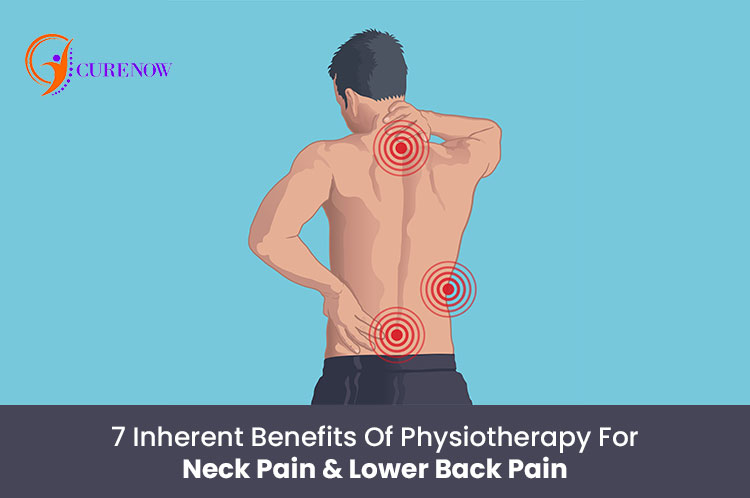
- 26 Oct 2023
- |
- By Admin
7 Inherent Benefits Of Physiotherapy For Neck Pain & Lower Back Pain
Neck pain and lower back pain are pervasive issues that can disrupt daily life, leading to discomfort and reduced mobility.
These conditions often stem from various causes, including poor posture, muscle strain, or underlying medical conditions. Physiotherapy emerges as a highly effective and non-invasive solution for managing and alleviating neck and lower back pain.
In this blog post, we'll delve into the causes and symptoms of these conditions, the role of physiotherapy, and the seven inherent benefits it offers for individuals dealing with neck pain and lower back pain.
Causes and Common Symptoms
Neck Pain
Poor Posture: Continuous slouching or hunching over screens can strain neck muscles.
Muscle Tension: Stress or muscle tension can lead to neck discomfort and stiffness.
Herniated Disc: A herniated cervical disc can exert pressure on nerves, causing neck pain that sometimes radiates to the arms.
Lower Back Pain
Muscle Strain: Lifting heavy objects improperly or sudden movements can strain lower back muscles.
Degenerative Disc Disease: As we age, the spinal discs can deteriorate, causing lower back pain.
Sciatica: Compression of the sciatic nerve can result in lower back pain radiating down the leg.
The Role of Physiotherapy
Physiotherapy plays a pivotal role in the management and treatment of neck and lower back pain. Here are seven inherent benefits it offers:
Pain Relief: Physiotherapists employ various techniques such as manual therapy, heat therapy, and electrical stimulation to alleviate pain effectively.
Enhanced Mobility: Tailored exercises and stretches target the affected area, improving range of motion and reducing stiffness.
Posture Correction: Physiotherapists identify and address poor posture habits that contribute to pain, helping patients establish healthier alignment.
Muscle Strengthening: Targeted exercises strengthen muscles supporting the neck and lower back, improving stability and reducing the risk of future pain.
Customized Treatment Plans: Physiotherapy is patient-centric, with professionals devising individualized treatment plans tailored to specific needs and goals.
Education and Prevention: Patients receive valuable education on how to prevent future occurrences of neck and lower back pain, including ergonomic adjustments and proper lifting techniques.
Non-Invasive Approach: Physiotherapy is non-invasive, avoiding the need for surgery or reliance on medication, which can have side effects.
Benefits of Physiotherapy for Neck Pain and Lower Back Pain
Long-term Pain Management: Physiotherapy addresses the root causes of neck and lower back pain, providing long-term relief rather than masking symptoms with medications.
Improved Quality of Life: As pain diminishes and mobility increases, individuals can enjoy an improved overall quality of life, engaging in activities they love without discomfort.
Reduced Reliance on Medication: Physiotherapy can often reduce or eliminate the need for pain-relieving medications, helping patients avoid potential side effects and dependency.
Quick Recovery: With tailored treatment plans and exercises, physiotherapy accelerates the healing process, enabling individuals to return to their daily routines faster.
Enhanced Functional Abilities: Patients regain the ability to perform everyday tasks, improving their independence and reducing reliance on others for assistance.
Personalized Care: Each patient's condition is unique, and physiotherapists provide personalized care, adjusting treatment plans as needed to ensure optimal progress.
Prevention of Recurrence: By addressing the underlying causes of neck and lower back pain, physiotherapy helps prevent future flare-ups and injuries.
Consult with our UK-trained and certified Physiotherapists at CureNow Wellness, and find the solution that you are looking for neck and lower back pain, right away!
Visit us at CureNow.in now.
CureNow Wellness Pvt. Ltd.
F-Residences, Shop # 25, First Floor, Wadgaon Sheri, Kalyani Nagar Annexe, Pune - 411014, Maharashtra
Mobile No : 9545345300
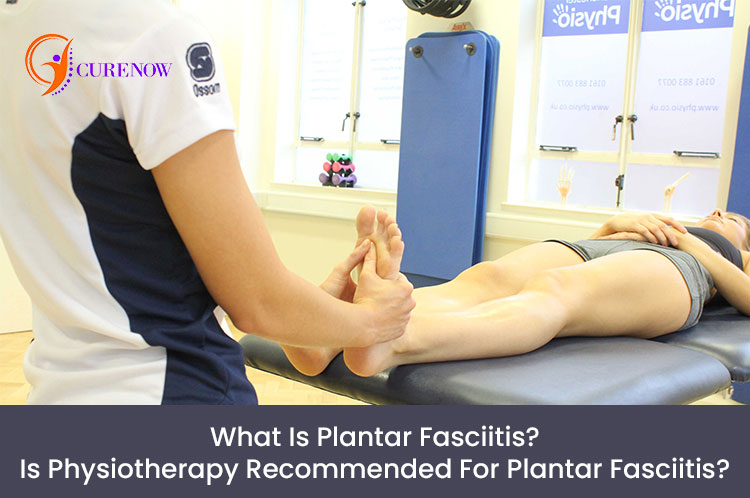
- 12 Oct 2023
- |
- By Admin
What Is Plantar Fasciitis? Is Physiotherapy Recommended For Plantar Fasciitis?
Plantar fasciitis is a common and often debilitating condition that affects many people, particularly those who are physically active or spend long hours on their feet.
This painful condition can significantly impact one's quality of life, making it crucial to seek effective treatment options.
In this blog post, we will delve into what plantar fasciitis is, its causes, common symptoms, and the role of physiotherapy in its treatment. We'll also provide a glimpse of some recommended exercises, while emphasizing the importance of professional diagnosis and treatment from experts like CureNow Wellness.
What Is Plantar Fasciitis?
Plantar fasciitis is a medical term that refers to inflammation of the plantar fascia, a thick band of tissue that runs along the bottom of your foot, connecting your heel bone to your toes. This condition is a type of overuse injury, often occurring when the plantar fascia is subjected to repetitive strain or micro-tears. The result is pain and discomfort, particularly in the heel area.
Causes of Plantar Fasciitis
Several factors contribute to the development of plantar fasciitis:
Overuse or Excessive Strain: Engaging in activities that put repetitive stress on the feet, such as running, dancing, or standing for extended periods, can lead to plantar fasciitis.
Improper Footwear: Wearing shoes that lack proper arch support or cushioning can strain the plantar fascia, increasing the risk of developing this condition.
Obesity: Excess body weight puts added stress on the feet, increasing the likelihood of plantar fasciitis.
Age: As we age, our plantar fascia can naturally lose elasticity, making it more susceptible to injury.
Common Symptoms
Plantar fasciitis typically presents with the following symptoms:
Heel Pain: The most common symptom is sharp, stabbing pain in the heel, especially upon taking the first steps in the morning.
Pain After Activity: Pain may also worsen after prolonged periods of standing, walking, or physical activity.
Stiffness: Patients often experience stiffness and limited mobility in the affected foot.
Tenderness: The heel area may become tender to the touch.
Role of Physiotherapy
Physiotherapy plays a vital role in managing and treating plantar fasciitis. At CureNow Wellness, our UK-trained physiotherapists work closely with patients to develop personalized treatment plans that address their unique needs. Here's how physiotherapy can help:
Pain Management: Physiotherapy techniques like ultrasound, soft tissue mobilization, and ice therapy can alleviate pain and reduce inflammation in the affected area.
Stretching and Strengthening: Physiotherapists teach patients specific exercises to stretch and strengthen the muscles and tendons in the foot and calf. These exercises can improve flexibility and reduce the risk of re-injury.
Gait Analysis: Our experts can perform gait analysis to identify and correct any abnormalities in your walking or running style that may contribute to plantar fasciitis.
Orthotic Devices: Custom-made orthotic insoles or shoe modifications may be recommended to provide better arch support and relieve pressure on the plantar fascia.
Common Exercises for Plantar Fasciitis
While we can suggest some exercises that may help alleviate plantar fasciitis symptoms, it's essential to emphasize that these exercises should be performed under the guidance of a qualified physiotherapist. Some exercises to consider include:
Calf Stretches: Gentle calf stretches can help relieve tension in the Achilles tendon and calf muscles.
Plantar Fascia Stretch: A seated or standing plantar fascia stretch can reduce tension in the arch of the foot.
Toe Exercises: Simple toe exercises can strengthen the muscles of the foot and improve balance.
Schedule a visit at CureNow Wellness today, and take the first step towards healing, treating and managing Plantar Fasciitis.
Visit us at CureNow.in now.
CureNow Wellness Pvt. Ltd.
F-Residences, Shop # 25, First Floor, Wadgaon Sheri, Kalyani Nagar Annexe, Pune - 411014, Maharashtra
Mobile No : 9545345300
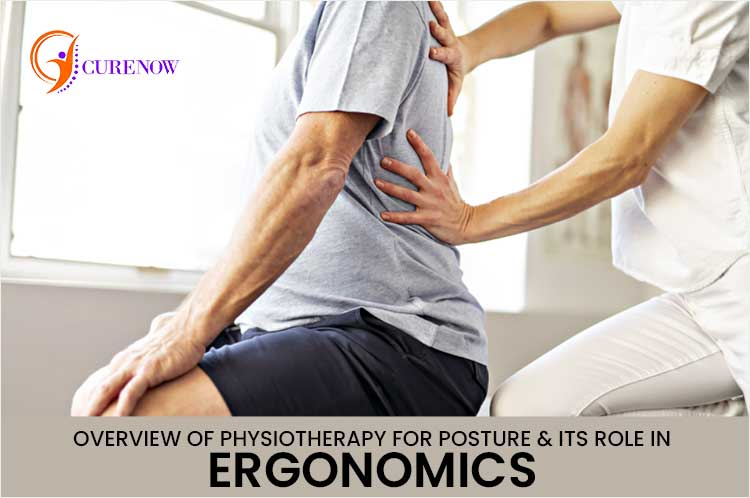
- 21 Sep 2023
- |
- By Admin
Overview Of Physiotherapy For Posture & Its Role In Ergonomics
In today's digital age, where office jobs and sedentary lifestyles have become the norm, the importance of maintaining good posture and embracing proper ergonomics cannot be overstated.
For office-going employees, this is especially crucial, as long hours spent sitting at desks or working on computers can take a toll on one's physical well-being. This blog explores the significance of good posture and ergonomics, the consequences of neglecting them, and the vital role that physiotherapy plays in promoting and maintaining both.
The Significance of Good Posture and Ergonomics
Maintaining good posture is not merely about looking poised and confident; it's about safeguarding your health. Proper posture involves aligning your body in positions that place the least strain on your muscles and ligaments. Good ergonomics, on the other hand, is the science of designing a workspace to minimize physical stress and discomfort. In an office setting, these principles work hand in hand to improve overall well-being.
Consequences of Neglecting Posture and Ergonomics
If you neglect your posture and disregard ergonomic principles, a cascade of adverse consequences can follow:
Muscle Strain: Poor posture can lead to the overuse or underuse of certain muscles, resulting in muscle imbalances and pain.
Back and Neck Pain: Slouching or hunching over a desk can put significant strain on your spine, leading to chronic back and neck pain.
Repetitive Strain Injuries (RSI): Incorrect keyboard and mouse usage can cause RSIs, which result from repetitive motions and poor hand positioning.
Decreased Productivity: Discomfort and pain can hinder your concentration and efficiency, affecting your overall productivity at work.
Long-term Health Issues: Prolonged poor posture can contribute to long-term health issues, including spinal deformities and increased risk of osteoarthritis.
Now, let's explore the role of physiotherapy in maintaining good posture and promoting ergonomics.
The Role of Physiotherapy in Posture and Ergonomics
Postural Assessment: A qualified physiotherapist can assess your posture to identify any deviations from the ideal alignment. This evaluation assists in discovering areas that need immediate improvement.
Customized Exercise Programs: Based on your postural assessment, a physiotherapist can create a personalized exercise program that targets specific muscles to correct imbalances and strengthen your core.
Manual Therapy: Physiotherapists employ manual therapy techniques to alleviate muscle tension and pain, improving your overall posture and comfort.
Ergonomic Guidance: Physiotherapists offer expert advice on how to optimize your workspace ergonomically. They can suggest adjustments to your chair, desk, computer monitor, and keyboard to ensure they are tailored to your body's needs.
Education and Awareness: Physiotherapists educate you about the importance of good posture and ergonomics, teaching you how to maintain correct alignment throughout your daily activities.
Pain Management: If you're already experiencing pain due to poor posture, physiotherapy can help manage and alleviate that pain through various techniques.
Prevention and Maintenance: Beyond correction, physiotherapists can provide strategies and exercises to help you maintain good posture and ergonomic practices in the long term.
Good posture and proper ergonomics are essential for maintaining physical well-being, especially for office-going employees.
Neglecting these principles can lead to various health issues and decreased productivity. Physiotherapy plays a pivotal role in promoting and maintaining good posture and ergonomic practices.
By seeking the guidance of a physiotherapist, individuals can address existing postural issues, prevent future problems, and ultimately improve their overall quality of life. Embracing the benefits of physiotherapy is a proactive step towards a healthier, pain-free, and more productive work experience.
Visit CureNow Wellness and schedule an appointment with our UK-trained and certified physiotherapists to find out more about posture and ergonomics.
Visit us at CureNow.in now.
CureNow Wellness Pvt. Ltd.
F-Residences, Shop # 25, First Floor, Wadgaon Sheri, Kalyani Nagar Annexe, Pune - 411014, Maharashtra
Mobile No : 9545345300

- 11 Sep 2023
- |
- By Admin
Cause & Symptoms Of Cervical Spondylitis: Can Physiotherapy Help?
Cervical spondylitis, also known as cervical spondylosis, is a prevalent condition characterized by the deterioration of the cervical spine's vertebrae and surrounding structures. It often results from the natural aging process, but lifestyle choices and genetic factors can also contribute to its development. While cervical spondylitis can lead to discomfort and reduced mobility, this blog explores the potential of physiotherapy to manage its symptoms and improve the overall well-being of those affected.
Understanding the Causes
Age-Related Degeneration: The gradual aging process is a primary cause of cervical spondylitis. As time passes, the spinal discs lose their water content and flexibility, leading to degeneration.
Herniated Discs: Ruptured or bulging discs between the vertebrae can exert pressure on the neck's nerves, resulting in pain and discomfort.
Bone Spurs: Over time, the body may develop additional bone material as a response to spinal degeneration. These bone spurs can impinge on nerves, causing pain.
Poor Posture: Prolonged periods of poor posture, such as hunching over electronic devices, can strain the neck and contribute to the development of cervical spondylitis.
Injuries: Trauma from accidents or sports-related incidents can cause significant damage to the cervical spine, increasing the risk of spondylitis.
Recognizing the Symptoms
Persistent Neck Pain: The most prevalent symptom of cervical spondylitis is ongoing neck pain, which can range from mild to severe and may worsen with movement.
Stiffness: Many individuals with cervical spondylitis experience neck stiffness, making it challenging to turn their heads or tilt them up or down.
Headaches: Neck pain can lead to tension headaches, which can be debilitating.
Numbness and Tingling: Nerve irritation can cause sensations of numbness, tingling, or weakness in the arms and hands.
Reduced Range of Motion: Individuals with cervical spondylitis may find it difficult to move their necks freely, affecting their daily activities and quality of life.
Now, let's delve into how physiotherapy can be a valuable ally in managing cervical spondylitis.
The Role of Physiotherapy
Pain Management: Physiotherapists employ various techniques, such as manual therapy and hot/cold therapy, to alleviate pain and reduce inflammation in the neck.
Posture Correction: Physiotherapy sessions emphasize improving posture and educating individuals on maintaining proper alignment, reducing strain on the neck.
Muscle Strengthening: Specific exercises are designed to strengthen the muscles that support the cervical spine, enhancing stability and reducing the risk of injury.
Range of Motion Enhancement: Physiotherapists guide patients through exercises aimed at increasing neck flexibility and restoring a full range of motion.
Ergonomic Guidance: Physiotherapists provide valuable insights on ergonomic adjustments at work and home to minimize the risk of exacerbating cervical spondylitis symptoms.
Personalized Treatment Plans: Recognizing the uniqueness of each patient, physiotherapy plans are customized to address individual conditions and progress.
Education and Self-Management: Patients receive comprehensive education about their condition and learn strategies for independent management, empowering them to improve their overall well-being.
Expert & guided physiotherapy offers promising avenues for symptom management and neck health improvement.
If you or someone you know is grappling with neck pain and discomfort, consider consulting a physiotherapist at CureNow to initiate a journey toward relief and a healthier, pain-free life.
Remember, it's never too late to take the first step toward better neck health.
Visit us at CureNow.in now.
CureNow Wellness Pvt. Ltd.
F-Residences, Shop # 25, First Floor, Wadgaon Sheri, Kalyani Nagar Annexe, Pune - 411014, Maharashtra
Mobile No : 9545345300

- 22 Aug 2023
- |
- By Admin
Back Pain Symptoms, Causes | Benefits Of Physiotherapy For Back Pain
Back pain is a common ailment that affects millions of people worldwide.
Whether it's due to poor posture, muscle strain, or underlying medical conditions, the discomfort and limitations caused by back pain can significantly impact one's quality of life. In this blog, we will delve into the causes and symptoms of back pain and explore how physiotherapy can effectively treat and alleviate this condition.
What is Back Pain?
Back pain is characterized by discomfort or pain felt anywhere in the back, from the neck down to the lower spine. It can vary in intensity, ranging from a mild ache to sharp, debilitating pain. Back pain can be classified into two main types: acute and chronic.
Acute back pain usually lasts for a few days to a few weeks and often resolves on its own. On the other hand, chronic back pain persists for more than three months and may require professional intervention.
Causes & Symptoms of Back Pain:
Muscle Strain: One of the most common causes of back pain is straining the muscles or ligaments in the back due to lifting heavy objects or sudden awkward movements.
Poor Posture: Prolonged sitting, slouching, or improper body mechanics can strain the back muscles and lead to pain.
Arthritis: Osteoarthritis or other forms of arthritis can affect the spine's joints, resulting in back pain.
Structural Issues: Conditions like scoliosis or spinal stenosis, where the spine's alignment is affected, can contribute to back pain.
Injury or Trauma: Accidents, falls, or sports-related injuries can lead to back pain, sometimes even causing fractures or dislocations.
Common symptoms of back pain include stiffness, localized pain, radiating pain down the legs (sciatica), muscle spasms, and limited mobility.
How Physiotherapy Helps in Treating Back Pain
Some key ways physiotherapy helps in treating back pain include:
Pain Relief: Physiotherapists use various techniques like manual therapy, heat or cold therapy, ultrasound, and electrical stimulation to alleviate pain and inflammation.
Exercise Programs: Tailored exercise programs can strengthen the core muscles, improve posture, and enhance flexibility, all of which contribute to better back health.
Posture Correction: Physiotherapists identify and correct poor posture habits, helping patients maintain a proper alignment that reduces strain on the back.
Manual Therapy: Hands-on techniques like mobilization and manipulation can restore joint mobility and relieve pain.
Education: Patients are educated about proper body mechanics and ergonomics to prevent future back pain episodes.
Some Physiotherapy Treatments for Back Pain:
McKenzie Method: This technique involves specific exercises and movements to identify the best direction to alleviate pain and restore mobility.
Core Strengthening Exercises: Strengthening the core muscles provides stability and support to the spine, reducing the risk of back injuries.
Hydrotherapy: Immersing in warm water and performing exercises can ease muscle tension and promote healing.
TENS (Transcutaneous Electrical Nerve Stimulation): Electrical impulses are used to block pain signals from reaching the brain, providing pain relief.
Consult with our UK-trained and certified Physiotherapists at CureNow Wellness, and find out more about our advanced and effective back pain treatment strategies.
Visit us at CureNow.in now.
CureNow Wellness Pvt. Ltd.
F-Residences, Shop # 25, First Floor, Wadgaon Sheri, Kalyani Nagar Annexe, Pune - 411014, Maharashtra
Mobile No : 9545345300

- 08 Aug 2023
- |
- By Admin
Find Out How Physiotherapy Helps In Healing Frozen Shoulder
Frozen shoulder, also known as adhesive capsulitis, is a painful condition that affects the shoulder joint, restricting its range of motion and causing discomfort. It commonly occurs when the connective tissues surrounding the shoulder joint become thick and tight, leading to a decrease in synovial fluid production. If left untreated, frozen shoulder can severely impact daily activities and quality of life.
Fortunately, physiotherapy has proven to be an effective and non-invasive treatment option for managing and healing frozen shoulder. In this blog, we will explore the causes, symptoms, and various physiotherapy techniques that can help alleviate the pain and restore shoulder function.
What is a Frozen Shoulder?
Frozen shoulder is a debilitating condition characterized by stiffness and pain in the shoulder joint. A capsule of connective tissue encloses the shoulder joint, and when this capsule thickens and tightens, it restricts the joint's movement. The condition typically progresses through three stages: the painful stage, the adhesive stage (frozen stage), and the thawing stage. Each stage presents varying levels of pain and stiffness.
Causes & Symptoms of Frozen Shoulder:
The exact cause of frozen shoulder is not always clear, but certain factors may increase the risk of developing the condition. These include previous shoulder injuries, diabetes, thyroid disorders, autoimmune diseases, and prolonged shoulder immobility due to post-surgery recovery or arm fractures.
The symptoms of frozen shoulder include:
- Persistent shoulder pain, particularly at night.
- Limited range of motion in the affected shoulder.
- Difficulty performing everyday tasks such as reaching overhead, dressing, or combing hair.
- Pain and discomfort when trying to move the shoulder.
How Physiotherapy Helps in Treating Frozen Shoulders
Physiotherapy plays a crucial role in treating frozen shoulder by restoring mobility, reducing pain, and improving overall shoulder function. A skilled physiotherapist will develop a personalized treatment plan tailored to the patient's specific condition and needs. Here are some ways physiotherapy aids in healing frozen shoulder:
a) Gentle Stretching Exercises
Physiotherapists use various stretching exercises to improve the range of motion in the shoulder joint. Gentle movements help to gradually loosen the tight capsule, reducing pain and increasing flexibility.
b) Strengthening Exercises
Specific shoulder strengthening exercises are employed to enhance the supporting muscles around the joint. Strengthening these muscles helps stabilize the shoulder, prevent further injury, and support the healing process.
c) Manual Therapy and Massage
Manual therapy techniques, including soft tissue mobilization and joint mobilization, are used to reduce pain and increase joint mobility. Massage helps in relaxing the muscles, improving blood flow, and reducing muscle tension.
d) Heat and Ice Therapy:
Applying heat pads to the affected shoulder can help relax the muscles and increase blood flow, promoting healing. On the other hand, ice therapy helps to reduce inflammation and alleviate pain.
e) Ultrasound Therapy
Ultrasound therapy uses sound waves to generate heat deep within the tissues, which can reduce pain and improve blood circulation, thereby aiding the healing process.
Physiotherapy Treatments for Frozen Shoulder
a) Pendulum Stretch
This exercise involves gently swinging the arm in small circles, helping to improve mobility in the shoulder joint and reduce stiffness.
b) Towel Stretch
Using a towel, patients can perform gentle stretches that help increase the range of motion in the shoulder.
c) Massage
Therapeutic massage applied to the shoulder area can help release tension, reduce pain, and improve blood flow.
d) Heat Pads
Applying heat pads to the shoulder before performing exercises or stretches can help relax muscles and facilitate movement.
e) Icing
Icing the shoulder after exercises or physical therapy sessions helps reduce inflammation and pain.
Physiotherapy is a valuable and effective approach for treating frozen shoulder. By employing a combination of stretching, strengthening exercises, manual therapy, and targeted treatments, physiotherapists can help patients find relief from pain and regain shoulder function.
Consult with our UK-certified physiotherapists at CureNow Wellness for a personalized treatment plan to pave the way for a faster and more complete recovery. Remember, early intervention and regular physiotherapy sessions are essential for achieving the best possible outcomes.
Visit us at CureNow.in now.
CureNow Wellness Pvt. Ltd.
F-Residences, Shop # 25, First Floor, Wadgaon Sheri, Kalyani Nagar Annexe, Pune - 411014, Maharashtra
Mobile No : 9545345300
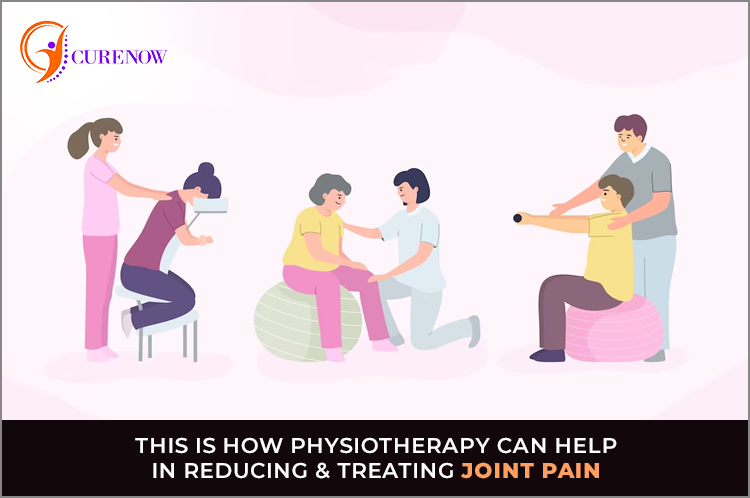
- 25 Jul 2023
- |
- By Admin
This Is How Physiotherapy Can Help In Reducing & Treating Joint Pain
Joint pain is a common condition that affects millions of people worldwide. It can occur due to various factors such as age, injury, overuse, or underlying medical conditions like arthritis.
Joint pain can significantly impact a person's quality of life, limiting their mobility and causing discomfort. However, physiotherapy offers effective solutions to reduce and treat joint pain, providing relief and restoring functionality. In this blog post, we will explore the symptoms of joint pain and delve into how physiotherapy can help alleviate and manage this condition.
Symptoms of Joint Pain
Joint pain can manifest differently depending on the underlying cause and affected joint. Some common symptoms include:
Stiffness: Joint stiffness often accompanies joint pain, making it difficult to move the affected joint freely. Stiffness is commonly experienced in the morning or after prolonged periods of inactivity.
Swelling: Inflammation and swelling may occur around the affected joint, causing discomfort and a visible increase in size. Swelling is usually a sign of an underlying issue, such as arthritis or an injury.
Limited Range of Motion: Joint pain can restrict the normal range of motion, making it challenging to perform daily activities or engage in physical exercise. This limitation can lead to muscle weakness and further aggravate the pain.
How Physiotherapy Can Help in Joint Pain
Pain Management
Physiotherapy offers various techniques to manage joint pain effectively. Therapists may use modalities like heat or cold therapy, ultrasound, or electrical stimulation to reduce pain and inflammation. These modalities promote blood circulation, relax muscles, and alleviate discomfort.
Exercise and Stretching
Specific exercises and stretching routines tailored to the individual's needs can help improve joint mobility and flexibility. Physiotherapists guide patients through range-of-motion exercises, strengthening exercises, and gentle stretching techniques to target the affected joint and its surrounding muscles. Regular exercise promotes joint lubrication and reduces pain.
Manual Therapy
Physiotherapists employ hands-on techniques to treat joint pain. Manual therapy may include joint mobilization, manipulation, or soft tissue massage to reduce pain, improve joint function, and enhance muscle flexibility. These techniques can help release tension, break up scar tissue, and restore proper alignment and movement.
Education and Lifestyle Modifications
Physiotherapists provide education and guidance on proper body mechanics, posture, and ergonomics. They teach patients how to protect their joints during activities, avoid excessive strain, and make necessary lifestyle modifications. By adopting healthier habits and practices, patients can manage joint pain effectively and prevent further complications.
Physiotherapy plays a vital role in reducing and treating joint pain. By addressing the root causes of joint pain and implementing a comprehensive treatment plan, including pain management, exercise, manual therapy, and education, physiotherapy helps individuals regain mobility, alleviate discomfort, and enhance their overall quality of life.
If you are experiencing joint pain, consulting a qualified physiotherapist can provide you with the appropriate care and guidance to effectively manage your condition.
Schedule an appointment with our UK-trained and certified Physiotherapists at CureNow Wellness, and find out more physiotherapy-based treatment for joint pain.
Visit us at CureNow.in.
CureNow Wellness Pvt. Ltd.
F-Residences, Shop # 25, First Floor, Wadgaon Sheri, Kalyani Nagar Annexe, Pune - 411014, Maharashtra
Mobile No : 9545345300

- 11 Jul 2023
- |
- By Admin
Top 5 Benefits Of Cardio Respiratory Physiotherapy
Cardio respiratory issues encompass a wide range of conditions that affect the heart and lungs, leading to breathing difficulties, decreased exercise tolerance, and reduced overall quality of life.
These conditions can arise from various factors such as chronic diseases, respiratory infections, or lifestyle choices. However, cardio respiratory physiotherapy offers significant benefits in the treatment and management of these conditions. In this blog post, we will explore the causes of cardio respiratory issues and delve into how physiotherapy can help improve respiratory function and overall well-being.
Causes of Cardio Respiratory Issues
Understanding the underlying causes of cardio respiratory issues is crucial for effective treatment and management. Some common causes include:
Chronic Diseases: Conditions like chronic obstructive pulmonary disease (COPD), asthma, cystic fibrosis, and heart failure can significantly impact respiratory function and cardiovascular health.
Respiratory Infections: Viral or bacterial infections affecting the respiratory system, such as pneumonia or bronchitis, can lead to acute or chronic cardio respiratory issues.
Sedentary Lifestyle: Lack of physical activity and a sedentary lifestyle can contribute to weakened respiratory muscles, reduced lung capacity, and impaired cardiovascular health.
High Blood Pressure: High blood pressure can contribute to the development of cardio respiratory issues, including heart disease, stroke, and impaired lung function.
Tobacco Use: Tobacco use is a leading cause of cardio respiratory issues, increasing the risk of heart disease, lung cancer, and respiratory problems.
How Physiotherapy Can Help in Cardio Respiratory Treatment and Management
Breathing Exercises
Physiotherapists employ various breathing exercises to improve lung function and enhance oxygenation. Techniques like diaphragmatic breathing, pursed-lip breathing, and incentive spirometry help strengthen respiratory muscles, increase lung capacity, and improve overall breathing efficiency.
Airway Clearance Techniques
For individuals with excessive mucus production or impaired mucus clearance, physiotherapists use specific techniques to help clear the airways. These techniques may include postural drainage, percussion, vibration, and coughing techniques to facilitate the removal of mucus and improve lung function.
Exercise Prescription
Tailored exercise programs are designed by physiotherapists to improve cardiovascular fitness and endurance. These programs may include aerobic exercises, such as walking, cycling, or swimming, which help strengthen the heart and lungs, enhance overall fitness, and promote better oxygen delivery throughout the body.
Education and Self-Management
Physiotherapists play a crucial role in educating patients about their condition, medication management, and self-care strategies. They provide guidance on energy conservation techniques, pacing activities, and lifestyle modifications to optimize daily functioning and prevent exacerbations.
Rehabilitation after Surgery or Hospitalization
Cardio-respiratory physiotherapy is instrumental in post-operative or post-hospitalization rehabilitation. Physiotherapists work closely with patients to rebuild strength, regain endurance, and restore functional independence. They provide exercises, breathing techniques, and support to ensure a smooth recovery and improve overall outcomes.
Cardio-respiratory physiotherapy offers significant benefits in the treatment and management of cardiorespiratory issues. By focusing on breathing exercises, airway clearance techniques, exercise prescription, education, and rehabilitation, physiotherapists help individuals improve their respiratory function, increase exercise tolerance, and enhance their overall quality of life.
If you or a loved one is experiencing cardio-respiratory issues, consult a UK-trained and certified physiotherapist at CureNow Wellness, and find out more about physiotherapy based treatments.
CureNow Wellness Pvt. Ltd.
F-Residences, Shop # 25, First Floor, Wadgaon Sheri, Kalyani Nagar Annexe, Pune - 411014, Maharashtra
Mobile No : 9545345300
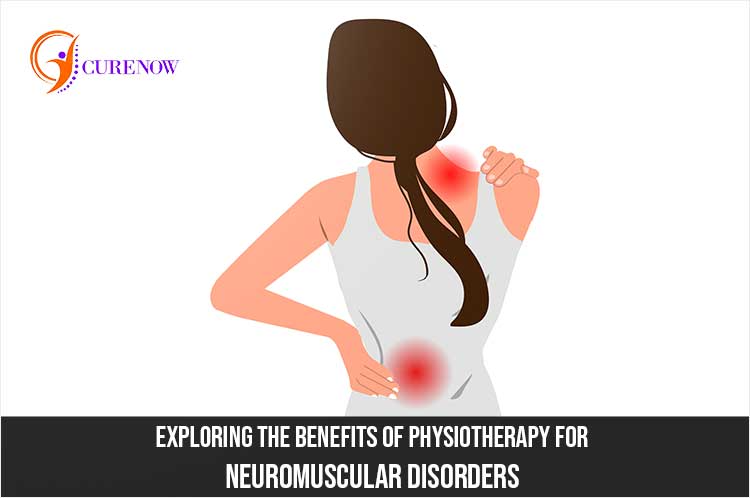
- 26 Jun 2023
- |
- By Admin
Exploring the Benefits of Physiotherapy for Neuromuscular Disorders
Neuromuscular disorders encompass a broad range of conditions that affect the nerves and muscles, resulting in impaired movement, muscle weakness, and reduced quality of life. These disorders can be challenging to manage, but physiotherapy offers valuable support in improving function, mobility, and overall well-being.
Understanding Neuromuscular Disorders
Neuromuscular disorders are described as conditions that affect the nerves that control voluntary muscles. These disorders can arise from various causes, such as genetic mutations, autoimmune responses, or nerve damage. Common symptoms include:
- Muscle weakness
- Decreased muscle control
- Impaired coordination
- Fatigue
- Difficulties with balance and mobility.
Best Physiotherapy Exercises for Neuromuscular Disorders
Physiotherapy plays a vital role in managing neuromuscular disorders, aiming to improve functional abilities, enhance independence, and maximize overall quality of life. Here are some recommended exercises commonly used in physiotherapy for individuals with neuromuscular disorders:
Strengthening Exercises: Specific exercises targeting weakened muscles can help improve muscle strength and function. These exercises may involve resistance training, bodyweight exercises, or the use of resistance bands or weights. Strengthening exercises help counteract muscle weakness and promote better movement control.
Range of Motion Exercises: Range of motion exercises focus on maintaining or increasing joint flexibility and mobility. These exercises involve gently moving the joints through their full range of motion, helping to reduce joint stiffness, enhance joint lubrication, and prevent contractures.
Balance and Coordination Training: Balance and coordination exercises help individuals with neuromuscular disorders enhance their stability and control during movement. These exercises may involve activities like standing on one leg, tandem walking, or using balance boards or stability balls. Improving balance and coordination can greatly contribute to reducing the risk of falls and improving overall mobility.
Functional Training: Functional training involves practicing tasks and activities relevant to daily life. These exercises are tailored to the individual's specific needs and challenges, focusing on improving their ability to perform activities such as walking, climbing stairs, or getting up from a chair. Functional training enhances independence and encourages the application of newly acquired skills in real-life situations.
Benefits of Physiotherapy for Neuromuscular Disorders
Improved Mobility and Function: Physiotherapy aims to enhance mobility and functional abilities, allowing individuals with neuromuscular disorders to perform daily tasks more easily. Through a combination of exercises, manual techniques, and assistive devices, physiotherapy helps individuals regain strength, coordination, and independence in their movements.
Pain Management: Neuromuscular disorders can be accompanied by chronic pain. Physiotherapy offers various pain management strategies, such as manual therapy techniques, heat or cold therapy, and electrical stimulation. These methods help reduce pain, improve muscle relaxation, and enhance overall comfort.
Delayed Disease Progression: Regular and guided physiotherapy helps to slow down disease progression. Physiotherapy exercises and interventions can preserve muscle strength, improve range of motion, and prevent further muscle atrophy, thus extending functional independence.
Increased Quality of Life: The comprehensive approach of physiotherapy for neuromuscular disorders focuses not only on physical improvements but also on the overall well-being of the individual. By addressing functional limitations, promoting independence, and providing emotional support, physiotherapy positively impacts the individual's quality of life.
Visit us at CureNow.in to schedule an appointment with our UK-trained and certified physiotherapists to find out more about Physiotherapy for Neuromuscular Disorders.
CureNow Wellness Pvt. Ltd.
F-Residences, Shop # 25, First Floor, Wadgaon Sheri, Kalyani Nagar Annexe, Pune - 411014, Maharashtra
Mobile No : 9545345300

- 12 Jun 2023
- |
- By Admin
Find Out Why Physiotherapy Is Recommended For Knee Rehabilitation
Knee rehabilitation plays a crucial role in recovering from knee injuries, surgeries, or chronic conditions. It focuses on improving strength, flexibility, and mobility of the knee joint. Physiotherapy is often recommended as an integral part of knee rehabilitation due to its numerous benefits.
Understanding Knee Rehabilitation
Knee rehabilitation is a comprehensive process aimed at restoring optimal function and minimizing pain in the knee joint. It involves a combination of therapeutic exercises, manual techniques, and other interventions tailored to the specific needs of each patient. Whether you've undergone knee surgery, suffered an injury, or struggle with chronic knee conditions, rehabilitation can aid in the recovery process.
How Physiotherapy Helps in Knee Rehabilitation
Individualized Treatment Plans: Physiotherapists at CureNow understand that each patient's knee condition is unique. Our UK-trained and certified physiotherapists will assess the severity of the injury or condition and develop personalized rehabilitation programs to address specific needs.
Pain Relief: One of the primary goals of physiotherapy in knee rehabilitation is to reduce pain and inflammation. Physiotherapists at CureNow Wellness employ various modalities like ultrasound, heat therapy, ice packs, and electrical stimulation to alleviate pain and promote healing. Additionally, they guide patients through exercises and stretches that help in pain management and improve overall knee function.
Restoration of Range of Motion: Knee injuries often result in restricted range of motion. Our physiotherapists use a combination of manual techniques, such as joint mobilizations and soft tissue massage, to improve the flexibility and mobility of the knee joint.
Strengthening and Stability: Physiotherapy focuses on strengthening the muscles around the knee to provide better support and stability. Through a range of exercises, including resistance training, weight-bearing exercises, and balance training, physiotherapists target specific muscle groups to rebuild strength.
Physiotherapy For Knee Rehabilitation
Here are a few effective physiotherapy treatments for ensuring swift and impactful knee rehabilitation:
Ultrasound: Ultrasound therapy uses high-frequency sound waves to provide deep heating to the affected area of the knee. This method helps increase blood flow, reduce pain and inflammation, and promote tissue healing.
Soft tissue therapy: Soft tissue therapy involves various manual techniques, such as deep tissue massage, myofascial release, and trigger point therapy. These techniques target the muscles, tendons, and ligaments around the knee joint to reduce tension, improve flexibility, and alleviate pain.
Electrotherapy: CureNow Wellness offers Electrotherapy, including techniques like electrical stimulation and transcutaneous electrical nerve stimulation (TENS), which involves the use of electrical currents to stimulate the nerves and muscles around the knee. This method can help in pain management, muscle strengthening, and reducing swelling.
Laser therapy: Laser therapy utilizes low-level laser light to penetrate the tissues of the knee, promoting cellular healing and reducing pain and inflammation. It helps in increasing blood circulation, accelerating tissue repair, and stimulating the production of collagen.
Kinesiology taping: Kinesiology taping involves the application of a specialized elastic tape to provide support and stability to the knee joint. The tape is applied in specific patterns to facilitate proper muscle activation, enhance proprioception, and reduce pain.
Soft tissue massages or knee joint mobilization: Soft tissue massages involve the application of various massage techniques to the muscles and soft tissues around the knee joint.
Visit us at CureNow.in and schedule an appointment with our UK-trained and certified Physiotherapists to find out more about knee rehabilitation.
CureNow Wellness Pvt. Ltd.
F-Residences, Shop # 25, First Floor, Wadgaon Sheri, Kalyani Nagar Annexe, Pune - 411014, Maharashtra
Mobile No : 9545345300

- 25 May 2023
- |
- By Admin
Find Out How Physiotherapy Can Help In Post Surgery Rehabilitation
Surgery is a major medical intervention that can lead to significant improvements in one's health and quality of life. However, the process of recovering from surgery can be a challenging and overwhelming experience. Surgery rehabilitation is an essential part of the recovery process, as it can help patients regain their strength, mobility, and independence. Physiotherapy is a highly effective form of surgery rehabilitation that can play a crucial role in the healing process.
After surgery, patients often experience a range of difficulties, including pain, swelling, and limited mobility. The recovery process can be long and arduous, and patients may require ongoing support and assistance throughout their journey. It's essential to work with a qualified physiotherapist to help manage these challenges and promote a successful recovery.
Physiotherapy can be beneficial in a range of cases where surgery and rehabilitation is necessary. For example, physiotherapy can help patients recover from orthopedic surgeries such as joint replacements, ligament repairs, and spinal surgeries. Physiotherapy can also be effective for patients recovering from cardiac surgery, abdominal surgery, and neurological surgery.
There are several benefits of physiotherapy for surgery rehabilitation. Some of these benefits include:
Advice and Guidance For Assured Results
A physiotherapist can provide guidance and support throughout the various stages of your recovery. They can help you set achievable goals, monitor your progress, and provide feedback and encouragement as needed.
Reducing Pain, Swelling, Scarring
After surgery, patients may experience pain, swelling, and scarring. A physiotherapist can help manage these symptoms using various techniques such as manual therapy, therapeutic exercise, and modalities like heat or cold therapy.
Increased Mobility
One of the most significant challenges after surgery is regaining mobility. A physiotherapist can help patients recover their mobility by developing an individualized exercise program that focuses on strengthening and stretching specific muscles and joints.
Enhanced Flexibility
Surgery can cause a loss of flexibility, particularly in the affected area. Physiotherapy can help patients regain their flexibility through targeted stretching exercises.
Increased Strength
Surgery can lead to a loss of strength in the affected area. Physiotherapy can help patients develop strength through resistance training, functional exercises, and other specialized techniques.
Balance and Coordination
Surgery can impact a patient's balance and coordination, making them more prone to falls and other injuries. Physiotherapy can help patients regain their balance and coordination through specialized exercises and techniques.
Restoring Normal Life
Physiotherapy can help patients return to their daily activities and independence. A physiotherapist can work with patients to develop strategies for performing daily tasks with limited mobility or flexibility.
Restoring Recreational Activities, Sports & Peak Performance
Physiotherapy can help patients return to their favorite recreational activities, sports, and peak performance. A physiotherapist can work with patients to develop specialized exercise programs that target the specific needs of their chosen activity.
Prevention Of Complications
Surgery can lead to complications such as blood clots, pressure ulcers, and infections. Physiotherapy can help prevent these complications by promoting circulation, improving mobility, and developing proper positioning strategies.
In conclusion, physiotherapy is an essential part of surgery rehabilitation that can help patients recover from surgery successfully.
By consulting with our qualified and UK-certified physiotherapists from CureNow, patients can benefit from a range of specialized techniques and exercises that can promote healing, improve mobility, and enhance their overall quality of life.
Whether recovering from orthopedic surgery, cardiac surgery, or neurological surgery, physiotherapy can help patients achieve their recovery goals and return to their daily activities with confidence and independence.
Visit us at CureNow.in to find out more about physiotherapy for Post Surgery Rehabilitation.
CureNow Wellness Pvt. Ltd.
F-Residences, Shop # 25, First Floor, Wadgaon Sheri, Kalyani Nagar Annexe, Pune - 411014, Maharashtra
Mobile No : 9545345300

- 11 May 2023
- |
- By Admin
What Are The Benefits Of Physiotherapy for Multiple Sclerosis?
Multiple Sclerosis (MS) is a chronic, progressive disease that affects the central nervous system. It is caused by the immune system attacking the myelin, which is a fatty substance that surrounds and protects the nerve fibers. This damage disrupts the transmission of signals between the brain and the rest of the body, leading to a variety of symptoms. MS is often diagnosed between the ages of 20 and 40 and affects women more frequently than men. Common symptoms include fatigue, muscle weakness, coordination problems, numbness or tingling sensations, and difficulty with vision or speech.
While there is no cure for MS, there are several treatments available to manage symptoms and improve quality of life. One of these treatments is physiotherapy, which involves the use of exercises and physical interventions to improve mobility, balance, strength, and coordination.
Benefits of Physiotherapy for Multiple Sclerosis:
Here are some of the ways that physiotherapy can benefit individuals with MS:
Reduce Symptoms:
Physiotherapy can help to reduce the severity and frequency of MS symptoms, such as fatigue, muscle weakness, and spasticity. By engaging in regular exercise and stretching, individuals with MS can improve their overall physical fitness, which can lead to a reduction in symptoms and an improved sense of well-being.
Learn how to support and cope with your changing body:
MS is a chronic and unpredictable disease, and many individuals with MS may experience changes in their physical abilities over time. Physiotherapy can provide education and support to help individuals with MS adapt to these changes and learn new ways to perform daily tasks. This can include instruction on how to use assistive devices such as canes or braces, as well as tips on how to conserve energy and manage fatigue.
Avoid exacerbating symptoms:
Physiotherapy can help individuals with MS to avoid exacerbating symptoms by teaching them how to move safely and efficiently. This can include instruction on proper body mechanics and postural alignment, as well as exercises to improve balance and coordination.
Develop strength and stamina:
Muscle weakness and fatigue are common symptoms of MS, but regular exercise and physical activity can help to improve strength and endurance. Physiotherapy can provide a structured and progressive exercise program that is tailored to the individual's needs and abilities.
Regain abilities after a disease relapse:
MS relapses can result in a temporary loss of function or mobility. Physiotherapy can help individuals with MS to regain lost abilities and improve their overall function following a relapse. This can include exercises to improve strength and balance, as well as strategies to manage spasticity and other symptoms.
Improve the quality of life:
Physiotherapy can have a significant impact on an individual's overall quality of life. By reducing symptoms and improving physical function, physiotherapy can help individuals with MS to maintain their independence and participate in daily activities that are important to them.
Multiple Sclerosis is a complex and challenging disease, but physiotherapy can play an important role in managing symptoms and improving quality of life. Our UK-trained and certified physiotherapists have the required expertise and experience to suggest the best physical treatment plan, that can bring a positive change.
Visit us at CureNow.in, and take the first step towards treating and managing Multiple Sclerosis.
CureNow Wellness Pvt. Ltd.
F-Residences, Shop # 25, First Floor, Wadgaon Sheri, Kalyani Nagar Annexe, Pune - 411014, Maharashtra
Mobile No : 9545345300

- 28 Apr 2023
- |
- By Admin
What Is Physiotherapeutic Ultrasound? What Are Its Primary Benefits? (How To Use?)
It's a myth that physiotherapy treatments are limited to massages and exercise prescriptions.
Modern methods used by physiotherapy teams incorporate technology, including Ultrasound therapy.
This technique is employed by physiotherapists and has several inherent benefits, which we will explore in this blog post by CureNow.
What Is Physiotherapeutic Ultrasound?
Ultrasound therapy is an electrotherapy technique that has been utilized in physiotherapy practices for many years. It works by emitting high-frequency sound waves that penetrate the body's soft tissues. These sound waves cause cellular fluids to vibrate and move, creating a non-thermal effect. The proposed benefits of ultrasound therapy include improving the healing rate of certain soft tissues.
One of the primary benefits of ultrasound therapy is its ability to increase blood flow to a specific area, which can accelerate the resolution time of the inflammatory process. Additionally, ultrasound therapy can stimulate the production of collagen, which is the main protein found in tendons and ligaments. Collagen plays a crucial role in the healing process of soft tissues, and by promoting its production, ultrasound therapy may lead to faster tissue healing.
This is a safe therapy and quite an effective treatment option for individuals who are experiencing soft tissue injuries. While it is not a cure-all, it can provide significant benefits when used in conjunction with other physiotherapy techniques.
We at CureNow Wellness have a highly efficient and advanced Therapeutic Ultrasound device, that has benefited our patients to get relief from pain.
How To Use Physiotherapeutic Ultrasound?
The physical therapist's ultrasound unit contains a small crystal that vibrates rapidly when hit with an electrical charge, generating piezoelectric waves.
These waves then emit from the ultrasound sound head as ultrasound waves, which enter your injured tissues during treatment.
The ultrasonic waves can increase blood flow and cavitation in the tissues, which may lead to the proposed benefits of ultrasound therapy.
Increased blood flow can accelerate the healing process, while cavitation can promote the movement of fluids in and out of the tissues, aiding in the removal of waste products and reducing inflammation.
Benefits Of Physiotherapeutic Ultrasound
Therapeutic ultrasound can provide multiple benefits to patients undergoing physical therapy.
#1 Pain Relief
Physiotherapeutic Ultrasound is an effective method to reduce pain and muscle spasms while preparing the muscles for further therapeutic treatments.
#2 Relax Tissue Tension
Ultrasound therapy can relax tissue tension by providing deep heat to the affected area and increasing blood flow, which can improve soft tissue cell metabolism and promote faster healing. It can also help treat surgical wounds and soft tissue lesions.
#3 Enhance Blood Flow
Ultrasound increases blood flow, which can reduce swelling and chronic inflammation, and relieve pain for the patient.
#4 Heat Therapy
The ultrasound waves penetrate deep to provide a heating effect that relaxes deep musculature and joint tissues.
#5 Scar Tissues Breakdown
Lastly, the treatment generates tiny micro-vibrations that can break down scar tissue, increasing the range of motion and providing longer-lasting relief.
A physical therapist's skill and knowledge can make a significant difference in the effectiveness of ultrasound therapy.
Consult with our UK-Certified and trained Physiotherapists, who can correctly diagnose the condition of the patient, and suggest how Physiotherapeutic Ultrasound can help the patient to get relief from pain.
CureNow Wellness Pvt. Ltd.
F-Residences, Shop # 25, First Floor, Wadgaon Sheri, Kalyani Nagar Annexe, Pune - 411014, Maharashtra
Timings: 10:30 AM-8:30 PM
(Sunday closed)

- 14 Apr 2023
- |
- By Admin
What Is Kinesiotaping? Check The Top 5 Benefits Of Kinesiotaping
Developed by Japanese Chiropractor Dr. Kenzo Kase in the 1970s, The Kinesio Taping Method is a therapeutic technique that uses tape to alleviate pain and promote lymphatic drainage by lifting the skin at a microscopic level.
This lifting action creates convolutions in the skin, which increases the interstitial space and reduces inflammation in the affected area.
The Kinesio Taping Method is based on extensive research and clinical experience and involves the application of Kinesio tape in a specific manner, determined by evaluation and assessment.
The applications of Kinesio Tex Tape are numerous and versatile, and they can help reduce pain and inflammation, enhance post-surgical healing, optimize performance, prevent injury, promote good circulation, and aid the body's natural healing process.
What Are The Features Of Kinesio Tex Tape?
Kinesio Tex Tape is a therapeutic tape used in the Kinesio Taping Method, and it is made up of either 100% cotton and elastic fibers or a blend of polyester and cotton with elastic fibers.
The latter is preferred when higher tensions are needed for sensitive skin applications.
The tape is applied to a paper backing using an acrylic adhesive with 10-15% stretch, also known as "paper off tension," which is used in some Kinesio Taping techniques.
The tape has several other characteristics, such as the ability to stretch up to 120-140% of its original length and recoil back to the anchor without stretch.
It has a heat-activated adhesive, hypoallergenic dyes, is latex-free, and dries in 5-10 minutes after being wet.
Additionally, the tape can be worn for several days, making it a practical and effective therapy option. These features make Kinesio Tex Tape a versatile and safe option for most users.
Benefits Of Kinesiotaping
Kinesiotaping offers numerous benefits that make it a popular therapeutic technique.
#1 Immediate Pain Relief
When applied to the body, Kinesio tape can provide support to the muscles and reduce inflammation, thus providing immediate pain relief.
#2 Faster Healing
The tape also lifts the skin, which enhances circulation and increases lymph fluid movement in the body, leading to faster healing.
#3 Solution For Various Injuries
Kinesio taping is used to treat several conditions, including rotator cuff injuries, sprains, carpal tunnel syndrome, herniated discs, tennis elbow, plantar fasciitis, and whiplash.
This versatility makes it an ideal option for those suffering from a range of injuries.
#4 Enhance Performance
Kinesio tape can protect the body by reducing the risk of further injury. Additionally, it can promote proper motor patterns, making it an effective tool for athletes and individuals seeking to improve their physical performance.
#5 Preventive Measure
Kinesio tape is not only used to recover from injuries but also in preventive and wellness care, such as posture correction and lymphatic drainage.
In summary, Kinesiotaping offers a range of benefits, making it a popular therapeutic technique for various conditions.
Visit CureNow Wellness, one of the most popular and recommended Physiotherapy Clinics in Pune, where UK-trained & Certified Physiotherapists can provide result-oriented Kinesiotaping, and help patients to get relief from pain and recover faster from injuries.
Visit us at CureNow today.
CureNow Wellness Pvt. Ltd.
F-Residences, Shop # 25, First Floor, Wadgaon Sheri, Kalyani Nagar Annexe, Pune - 411014, Maharashtra
Timings: 10:30 AM-8:30 PM
(Sunday closed)

- 23 Mar 2023
- |
- By Admin
Workout Injuries Of The Shoulder? This Is How Physiotherapy Can Help You Right Away
Engaging in a workout at the gym can have a therapeutic effect.
You can perform your exercises, receive guidance from your trainer or instructor, and lift weights. This regimen can leave you feeling rejuvenated.
There's nothing quite like running on the treadmill or completing a challenging deadlift after a tough day. However, despite the endorphins flowing, there is always the possibility of an unfortunate event occurring, such as a workout injury.
Whether it's a shoulder injury, ankle sprain during leg day, or a sudden muscle spasm from a poor form: Your normal routine is disrupted, and you feel helpless.
This is where Physiotherapy can help you, right away.
Types Of Workout Injuries Of The Shoulder
Some common shoulder injuries resulting from workouts include (but are not limited to)
Rotator Cuff Injury
Weight Lifter Shoulder
Dislocated Shoulder
Sprains and strains
Separations
Tendinitis
Bursitis
Torn rotator cuffs
Frozen shoulder
Arthritis and more.
How Physiotherapy Can Help To Recover?
Physical therapy for shoulder pain resulting from workouts involves more than just generic exercise routines. While whole-body exercises are beneficial for overall physical and mental well-being, physical therapy exercises for shoulder pain are specifically designed to achieve four key goals.
The first goal is strengthening, as chronic shoulder pain can lead to weakened muscles in the shoulders and upper back. Strengthening exercises for these areas can offer greater support to the shoulder joint.
The second goal is to increase the range of mobility, as limited movement in tendons and ligaments can exacerbate shoulder pain. Many shoulder rehabilitation exercises aim to gradually increase the pain-free range of motion.
The third goal is breaking up scar tissue, which can form after surgery and cause limited movement and pain even during the healing process. Breaking up scar tissue promotes flexibility in the joint and helps ease movement.
The fourth and most crucial goal is improving quality of life, as shoulder pain can impede the simplest of life's joys, like lifting your arms to hug your children. Physical therapy for shoulder pain is geared toward helping patients regain their quality of life by restoring functionality and reducing discomfort.
Tips For Shoulder Exercises
To alleviate shoulder pain encountered during workouts, the patient needs to do the basic exercises upto three to six times per week, as per the suggestions and recommendations of the physiotherapist.
Some tips:
- Begin with a ten-minute routine and gradually increase the duration as the patient becomes stronger and more adaptable.
- As the exercises are being done, the patient should concentrate on loosening up and releasing any pressure in the shoulders or other areas where they may feel tightness.
- Stretch only to the extent that feels comfortable for the day, avoiding pushing oneself past the limits. If any pain is encountered beyond mild discomfort, exercises should be stopped.
Consult With CureNow
Book an appointment with our UK-trained and certified Physiotherapists at CureNow Wellness, and take the first step towards treating shoulder pain. Our expert Physiotherapists will first diagnose the condition and accordingly suggest the best treatment and exercises for treating shoulder pain.
CureNow Wellness Pvt. Ltd.
F-Residences, Shop # 25, First Floor, Wadgaon Sheri, Kalyani Nagar Annexe, Pune - 411014, Maharashtra
Timings: 10:30 AM-8:30 PM
(Sunday closed)
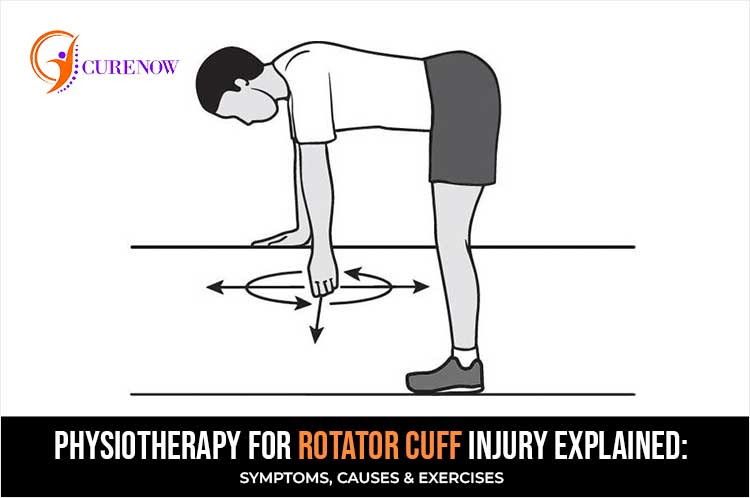
- 09 Mar 2023
- |
- By Admin
Physiotherapy for Rotator Cuff Injury Explained: Symptoms, Causes & Exercises
What is Rotator Cuff Injury?
The rotator cuff encompasses a set of tendons and muscles encircling the shoulder joint, which secure the upper arm bone's head in the shallow socket of the shoulder. When injured, the rotator cuff can cause a persistent, throbbing pain in the shoulder that intensifies at night.
As one age, the likelihood of sustaining a rotator cuff injury grows higher. Individuals who perform frequent overhead motions, such as carpenters and painters, may experience such injuries at an earlier age.
Causes Of Rotator Cuff Injury
- Rotator cuff injuries can occur gradually due to the degeneration of tendon tissue over time or suddenly from a fall or accident.
- Repetitive overhead activities or heavy lifting can also damage or irritate the tendon.
Risk Factors
Factors that may increase the risk of a rotator cuff injury include:
- Age, with individuals over 60 being most susceptible
- Certain occupations such as carpentry and painting
- Certain sports like baseball and tennis
- Family history of the condition.
Without treatment, rotator cuff injuries can lead to long-term loss of motion or weakness in the shoulder joint.
Symptoms Of Rotator Cuff Injury
Although symptoms may vary, the typical indicators of a rotator cuff tear include:
- Recurrent pain, especially during specific activities
- Discomfort that inhibits sleeping on the affected side
- Audible cracking or grating noises when moving the arm
- Restricted arm mobility
- Muscle weakness.
These symptoms may resemble those of other medical problems or conditions, so it's essential to consult a healthcare provider for a diagnosis.
Diagnosis Of Rotator Cuff Injury
To diagnose a rotator cuff injury, healthcare providers typically review the patient's medical history and conduct a physical examination.
Additional diagnostic procedures may include:
- X-rays, which produce images of internal tissues, bones, and organs using electromagnetic energy beams
- Magnetic resonance imaging (MRI), utilizes large magnets, radio frequencies, and a computer to generate detailed images of bodily structures.
Rotator cuff tears can be partial or complete, with partial-thickness tears leaving the tendon partially intact.
Physiotherapy Has The Solution For Rotator Cuff Injury
Physical therapy exercises can effectively enhance the flexibility and strength of the muscles encompassing the shoulder joint, and for many individuals suffering from rotator cuff issues, these exercises can help manage their symptoms without further treatment.
However, in some cases, a rotator cuff tear may result from a singular injury, and prompt medical attention is necessary as surgery may be required.
Note: CureNow Wellness now has Digistem 901 VECTOR 90 modality along with Localised Ultrasound which helps in early recovery of Rotator cuff tear. Get in touch with our team for more details.
Benefits Of Physiotherapy
A physical therapist can aid in the restoration of range of motion and teach patients exercises to enhance the strength of their shoulder muscles. Additionally, they can assist in:
- Improving posture to alleviate pain
- Identify comfortable sleeping positions
- Teach safe object-carrying techniques
- Advise on the use of ice or heat for pain relief
Understanding the importance of consistent physical activity and finding alternative methods of performing tasks to avoid further damage to the shoulder is also part of physical therapy. Recovery and a return to regular activities may take some time, but a therapist can help patients navigate this process with patience and perseverance.
Need more information regarding the treatment of Rotator Cuff Injury? Consult with our UK-trained and certified Physiotherapists at CureNow Wellness right now. Visit us at CureNow.in.
CureNow Wellness Pvt. Ltd.
F-Residences, Shop # 25, First Floor, Wadgaon Sheri, Kalyani Nagar Annexe, Pune - 411014, Maharashtra
Timings: 10:30 AM-8:30 PM
(Sunday closed)
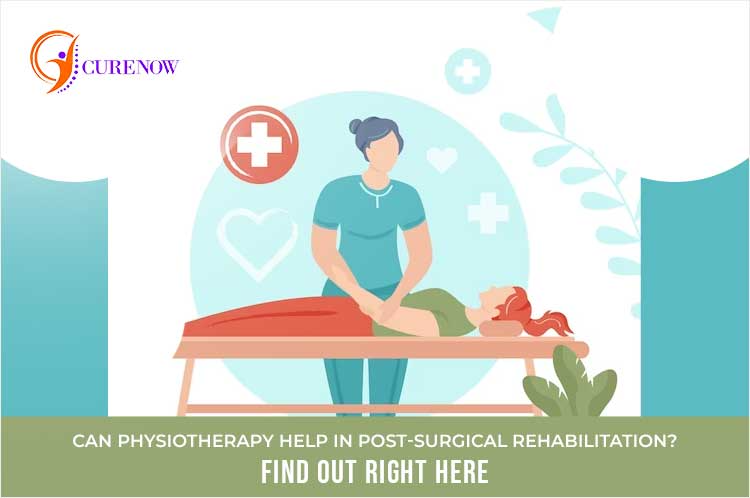
- 22 Feb 2023
- |
- By Admin
Can Physiotherapy Help In Post-Surgical Rehabilitation? Find Out Right Here
What Is Post-Surgical Rehabilitation?
Post-surgical rehabilitation refers to physical therapy aimed at aiding recovery from various surgeries, including orthopedic, cardiac, thoracic, neurological, and abdominal procedures. The goal is to mitigate post-operative consequences through physiotherapy.
In some cases, pre-operative physiotherapy has been observed to improve outcomes before orthopedic surgery.
To achieve a smoother recovery, pre-surgery physiotherapy is recommended. After an assessment, patients are provided with a pre-operative exercise program to maintain function and strength, as well as prepare for post-surgical rehabilitation.
Which Surgeries Need Rehabilitation?
The most frequent surgeries that typically require physiotherapy are:
- Orthopedic Surgery (bone, joint, and muscle repairs, reconstructions, and replacements)
- Spinal and Neurological Surgery (spinal fusions, disc repairs, and replacements, brain surgery)
- Abdominal and Thoracic Surgery (internal organ surgeries such as heart, lung, liver, and gastrointestinal system)
- Obstetric and Gynecological Surgery (postnatal, hysterectomy, gynecological repairs, and reconstructions)
- Urologic Surgery (bladder and prostate procedures)
- Breast Surgery (resections and reconstructions).
Can Physiotherapy Help In Post-Surgical Rehabilitation?
Yes, it definitely does.
Here are some benefits Of Post-Surgical Rehabilitation
- Pain management
- Returning to daily activities
- Strengthening weak muscles
- Improving flexibility and range of motion
- Achieving the previous level of function
- Improving posture
- Regaining independence
- Reducing anxiety and increasing confidence
- Improving circulation and preventing infections
- Providing advice on comfortable positioning to reduce pressure sores risk.
Please note: Physiotherapy should start immediately after surgery, both in the hospital and after discharge, to achieve the best possible recovery outcome.
Post-Surgical Rehabilitation: Who Will Benefit?
Individuals who have undergone surgery and are experiencing pain, stiffness, decreased balance and coordination, muscle weakness, limited mobility, low endurance, and decreased independence can benefit from post-surgical rehabilitation after being discharged from the hospital.
Surgery can have both physical and psychological impacts that can affect recovery and cause stress and anxiety. Our physiotherapists will conduct a comprehensive evaluation and work with you to set both short and long-term goals to optimize recovery and prevent any additional complications from the surgery.
In Hospital Physiotherapy
In-hospital post-surgical rehabilitation often begins the day after the procedure and is based on the type of surgery, physician instructions, and level of recovery. The following treatments may be provided:
- Breathing and circulation exercises to prevent respiratory and cardiovascular complications
- Assistance with movement to ensure safe mobility
- Instruction on using mobility aids such as crutches
- Discharge advice, including necessary equipment for home use
- Fitting of splints or slings and proper application instructions
- Explanation of the rehabilitation process and precautions
- Tailored exercises to aid in recovery.
Outpatient Physiotherapy
After leaving the hospital, continued rehabilitation is available through an outpatient physiotherapy program from CureNow Wellness.
A referral from a doctor is not required, but any information about the surgery can be helpful for the physiotherapist.
The therapist will create a personalized treatment plan using techniques such as manual mobilization and massage, exercise guidance, and other methods to improve range of motion, coordination, and strength, allowing for a return to work, sports, and hobbies.
Consult with our UK-trained and certified Physiotherapists from CureNow Wellness, start Post-Surgical Rehabilitation without any delay and take solid steps towards attaining full recovery.
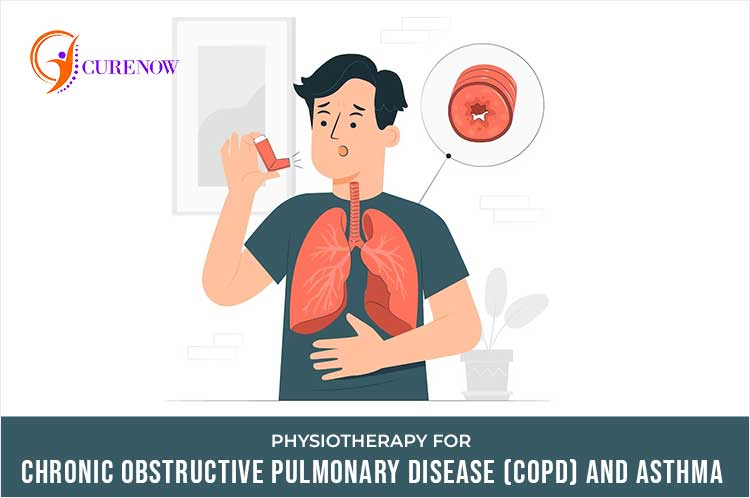
- 08 Feb 2023
- |
- By Admin
Physiotherapy For Chronic Obstructive Pulmonary Disease (COPD) And Asthma
What Is COPD?
COPD is a long-term lung disease marked by inflammation that obstructs airflow in the lungs, causing difficulty breathing, coughing, wheezing, and increased mucus production.
It is largely caused by prolonged exposure to irritating gases or particles, often from smoking. People with COPD face a heightened risk of heart disease, lung cancer, and other health issues. The two most common components of COPD are emphysema and chronic bronchitis, which often co-exist and can present differently in severity among those with COPD.
COPD is a degenerative illness that worsens with time, but it is also manageable. Through proper treatment, the majority of those with COPD can improve their symptoms, and quality of life, and decrease their risk of related health issues.
What Is Asthma?
Asthma is a respiratory condition characterized by narrow and inflamed airways that may produce extra mucus, causing difficulty breathing, coughing, wheezing and shortness of breath.
For some, asthma may be a minor inconvenience, but for others, it can significantly impact daily activities and pose a risk of a severe asthma attack.
Although asthma has no cure, its symptoms can be managed effectively. Monitoring and adjusting treatment in response to changes in symptoms is crucial in working with a doctor to manage asthma effectively.
Physiotherapy For COPD Patients
With proper and dedicated physiotherapy, COPD patients can get relief and initiate the healing process with physiotherapy.
Based on the diagnosis and present situation, some exercises and activities which physiotherapists can suggest for COPD patients:
- Breathing exercises to alleviate breathlessness and clear mucus/phlegm
- Manual techniques like percussion and vibration to loosen mucus/phlegm
- Proper positioning to enhance lung expansion and clear phlegm
- Exercise programs to increase activity and improve fitness
- Education and self-management guidance on using inhalers, nebulizers, and oxygen
- Recommendations, advice, and training on using devices to clear the airway and maintain lung volume
- Pulmonary rehabilitation classes offered in hospitals and community settings
The treatment plan will enable the patient to manage their condition effectively and identify when to seek assistance from doctors.
Physiotherapy For Asthma Patients
Some common exercises and activities suggested for asthma patients by physiotherapists:
Breathing Techniques:
Physiotherapists employ two primary breathing techniques:
Breathing retraining - focuses on normalizing breathing patterns
Buteyko breathing - targets hyperinflation and is also a form of breathing retraining
Respiratory Muscle Training:
Many asthma patients avoid physical activities due to fear of an asthma attack. However, avoiding physical activity can worsen the condition by reducing the body's ability to breathe. A physiotherapist will help train the respiratory muscles to improve breathing and increase physical activity. This can be achieved using respiratory devices and later progress to exercises and other physical activities.
Timing and Rhythm Method:
During an attack, taking smaller breaths can relax the air passage and lungs. The breath retraining technique involves breathing in through the nose and out through the mouth. It's essential to work with both your physiotherapist and doctor for optimal results, as medicine and physiotherapy should complement each other.
Schedule an appointment with our highly expert and UK-trained/certified physiotherapists at CureNow to find out how Physiotherapy can help COPD and Asthma patients.
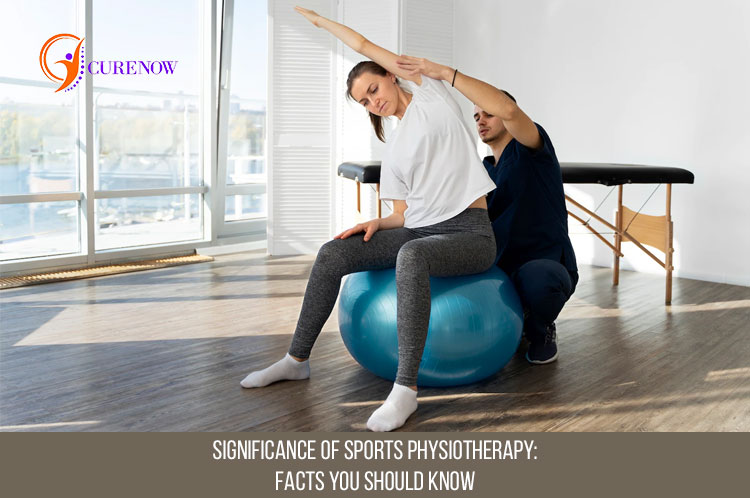
- 20 Jan 2023
- |
- By Admin
Significance Of Sports Physiotherapy: Facts You Should Know
What Is Sports Physiotherapy?
Within the vast realm of physiotherapy, sports physiotherapy is a niche specialization, which is dedicated to the assessment & treatment of injuries related to sports, exercises, and physical activities.
Why The Need For Sports Physiotherapy?
The overall diagnosis and treatment of injuries suffered by sportspersons are different, compared to a non-sportsperson.
Since sportsperson are focussed on high-level performance, they tend to place extra demand on their bodies, and thus, the injuries encountered needs a highly specialized treatment schedule, which is why sports physiotherapy is recommended and practiced.
If we observe broadly, then sports injuries tend to impact joints, ligaments, muscles, and tendons, and these are the injuries where the expertise and experience of sports physiotherapists are required.
Why Sports Physiotherapy: Facts You Should Know
There are several advantages of consulting with sports physiotherapists, and following their treatment plan as per the injury condition and other factors.
Enhance Physical Strength
One of the main benefits is the ability to enhance physical strength. As an athlete, the body is subjected to a lot of strain and pressure during various sports activities. This can lead to muscle, joint, bone, and ligament damage. By working with a sports physiotherapist, you can increase your body's strength and be better equipped to handle the physical demands of your sport.
Relaxation Of The Body
Another benefit of sports physiotherapy is the ability to help your body relax after intense workouts or games. It can be difficult for some athletes to unwind and de-stress after a particularly grueling session. With the help of a sports physiotherapist, you can learn techniques and stretches to relax your body and restore energy for the next day.
Joint and Muscle Flexibility
In addition to helping your body relax, sports physiotherapy can also improve joint and muscle flexibility. This is especially important for athletes whose sports require a high level of flexibility. A sports physiotherapist can work with you to develop a flexibility training program that meets your specific needs and goals.
Preventing Injuries
Another important aspect of sports physiotherapy is injury prevention. By strengthening and conditioning your body through targeted exercises, you can reduce your risk of sports-related injuries such as strains, sprains, and torn ligaments. Your physiotherapist will work with you to create a personalized plan that is tailored to your sport and your body's needs.
Recovery From Injuries
Finally, sports physiotherapy can also help you recover from injuries that do occur. If you suffer from a sports-related injury, your physiotherapist can help you recover as quickly as possible and prevent future complications. They will work with you to develop a rehabilitation plan that helps you get back to your best as soon as possible.
In conclusion, sports physiotherapy can provide a range of benefits to athletes, including the ability to enhance physical strength, help the body relax, improve joint and muscle flexibility, prevent injuries, and treat injuries. By working with a sports physiotherapist, you can improve your performance and stay healthy while pursuing your sport.
Consult with our UK-trained and certified sports physiotherapist at CureNow Wellness, and find out more about the relevance and importance of sports physiotherapy.

- 06 Jan 2023
- |
- By Admin
Shoulder Pain Is Disrupting Your Daily Life? Physiotherapy Has The Solution You Need
The shoulder is made up of several joints, muscles, and tendons that give the arm a wide range of motion. This mobility can lead to instability or impingement of the shoulder's soft tissue or bones, causing pain. The pain may be temporary or persistent and may require medical attention.
Shoulder pain can completely disrupt your normal day-to-day life since it’s associated with a wide of motions such as throwing a perfect pitch or scratching your back.
The good news is that physiotherapy has the solution you are seeking.
Causes Of Shoulder Pain
Shoulder pain may be caused by a variety of factors, including:
- Arthritis in the shoulder joint
- Bone spurs
- Bursitis (inflammation of a fluid-filled sac)
- A broken shoulder bone
- Dislocated shoulder or shoulder separation
- Frozen shoulder (stiffness and pain in the shoulder)
- Overuse or injury of nearby tendons
- Nerve injury that affects shoulder movement
- Tears in the rotator cuff tendons, and poor shoulder posture and mechanics.
In some cases, shoulder pain may be referred to as pain from another part of the body, such as the neck or lungs, and is not worsened by movement.
Symptoms Of Shoulder Pain
Some common signs and symptoms of shoulder pain may include warmth or redness in the shoulder, pain in the neck, arm, or back, a clicking or grinding sensation when moving the arm, muscle stiffness and weakness, and limited range of motion.
Can Physiotherapy Help?
With proper and guided physiotherapy, shoulder pain can not only be reduced and controlled, but also eradicated.
But how?
With physiotherapy, the shoulder muscles get strengthened, which gives relief from pain. Gradually, the joint functions are restored, and the range of motion is normalized.
Since exercises release natural painkillers, the patient is not dependent on medications and side-effects.
Besides, Physical therapy can improve blood circulation, particularly in the injured part of the body, which can facilitate faster and more effective healing. Some examples of shoulder stretches that may provide pain relief include the pendulum stretch and the crossover arm stretch.
Manual Physical Therapy & Rehabilitative Tools and Therapies
Based on the present condition, our UK-trained and certified physiotherapists can recommend the best manual exercises and rehabilitative tools and techniques for fast relief from shoulder pain.
Our physiotherapists are skilled in manual therapy techniques that can improve blood flow and encourage healing in the shoulders, which can help reduce pain.
Examples of manual manipulation exercises include thoracic and cervical joint manipulation or mobilization. Manual therapy can provide relief from pain and gradually restore normal shoulder function.
Physical therapists may also utilize rehabilitative tools and therapies, such as resistance bands, shoulder pulleys, and techniques like temperature therapy, electrical stimulation, and dry needling, to facilitate comprehensive and effective shoulder rehabilitation.
These treatments can be beneficial for patients who need physical therapy after surgery, as well as those experiencing chronic shoulder pain due to an injury or health condition like arthritis.
Schedule an appointment with CureNow Wellness today, and find out how shoulder pain can be effectively treated and managed with Physiotherapy.
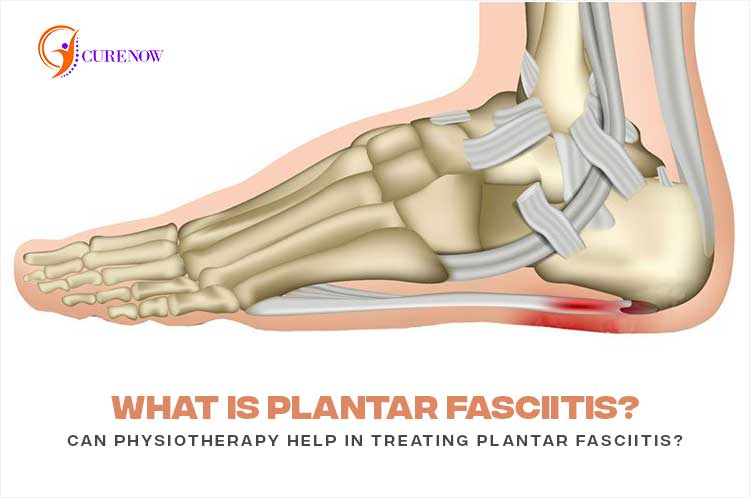
- 20 Dec 2022
- |
- By Admin
What Is Plantar Fasciitis? Can Physiotherapy Help In Treating Plantar Fasciitis?
Have you ever experienced a stabbing and unbearable pain originating from the bottom of the feet, near the heel, especially when one starts walking after a considerable amount of time, disrupting the normal gait and movement?
That happens due to Plantar Fasciitis, and the good news is that it can be healed with physiotherapy.
In this blog, we will try to understand what is Plantar Fasciitis, its symptoms and causes, and how physiotherapy can help the patient to heal and recover.
Plantar Fasciitis: Definition & Causes
Pain arising from the plantar fascia is called Plantar Fasciitis, a very common, but extremely painful orthopedic condition, usually occurring in patients aged 40-60 years, both male and female.
Now, the plantar fascia is a thick, weblike ligament, that connects one’s heels with the front of the foot, and basically acts like a shock absorber for the foot. It also supports the arch of the foot, enabling the person to walk smoothly.
The condition Plantar Fasciitis occurs when the plantar fascia ligaments experience wear and tear due to movements and walks, and there is additional pressure on the feet which tends to damage the ligaments.
When this happens, then the plantar fascia becomes inflamed, resulting in heel pain and stiffness.
Symptoms Of Plantar Fasciitis
The most common and primary symptom of Plantar Fasciitis is the pain originating from the bottom of the heel, or sometimes the bottom mid-foot area. Usually, this condition impacts one foot, but in exceptional cases, both feet are also prone to this pain.
The pain due to Plantar Fasciitis is at its peak during the mornings, then the patient wakes up, and takes the first step few steps after a long period of time.
A burning sensation or stabbing pain can be experienced from the bottom of the foot, which extends outwards, from the heel.
A very interesting thing to note: Patients suffering from Plantar Fasciitis don’t feel this pain while walking, but rather, after stopping and/or after resuming the walk.
Imaging Tests For Plantar Fasciitis
Orthopedics and Physiotherapists recommend imaging tests such as X-Ray or MRI to decode the issues pertaining to this pain, by checking the structures and tissues within the foot to understand the cause of Plantar Fasciitis.
Although X-Ray won’t reveal the exact details, an expert physiotherapist can find out the issues related to bone fractures, heel spurs, or any other factor which caused Plantar Fasciitis.
With an ultrasound, the physiotherapist can find out whether there is any thickening, or calcifications of the ligaments or tissues, which caused this pain.
Meanwhile, an MRI scan can reveal if there is any thickening of the plantar fascia or swelling which caused this condition.
Can Physiotherapy Treat Plantar Fasciitis?
Yes, physiotherapy has been found to be an excellent non-surgical method to treat and heal Plantar Fasciitis and give relief to patients. With gradual and dedicated physiotherapy exercises and treatment, the patient can witness a marked improvement in their condition.
Physiotherapy exercises are targeted to stretch plantar fascia and Achilles tendons, besides strengthening lower leg muscles, which enables the patient to stabilize their walks by lessening the burden on the plantar fascia.
Depending on the case and level of pain, physiotherapists can also recommend extracorporeal shock wave therapy, wherein sound waves are bombarded onto the heel, to stimulate healing within the ligament.
Consult with our UK-trained and certified Physiotherapists at CureNow Wellness, and find out how Physiotherapy can help the patient to recover from Plantar Fasciitis. We have advanced procedures such as Therapeutic Ultrasound and Kinesiotaping available at our clinic.
Book your appointment

- 06 Dec 2022
- |
- By Admin
Cervical Spondylosis: Definition, Symptoms & Causes | Can Physiotherapy Help?
Often called ‘arthritis of the neck’, Cervical Spondylosis is age-related wear and tear of the spinal disks in the neck, which gradually causes pain and stiffness in the neck.
With dedicated physiotherapy, this orthopedic condition can be controlled, and pain can be reduced, giving relief to the patients, and enabling them to carry on with their regular day-to-day activities with ease.
Definition Of Cervical Spondylosis
The condition wherein there is a natural wearing down of cartilage, disks, ligaments, and bones in the neck is described as Cervical Spondylosis.
As per various studies, it has been found that 9 out of 10 people above 60 can experience some or the other form of Cervical Spondylosis.
Symptoms Of Cervical Spondylosis
In the initial phase, the patients may not experience any symptoms of Cervical Spondylosis, and suddenly one day, several symptoms may arise.
The most common early symptoms of Cervical Spondylosis include:
- Neck pain and/or stiffness, which gets worse when the patient moves their neck
- A consistent soreness in the neck
- Muscle spasms
- Clicking, popping, or grinding sound when the patient moves their neck
- Sudden dizziness
- Consistent and long-term headaches
Causes of Cervical Spondylosis
As age progresses, the spine of a person experiences wear and tear, which changes the condition of the disks between the vertebrae.
These changes are the root cause of Cervical Spondylosis. Some of these changes include:
- The spinal disks in the neck start to degenerate, which makes the disks thinner, and reduces the elasticity of the soft tissues. This is the reason that people aged 60 or more start to feel shorter.
- Due to wear and tear of the spine, some parts of the spinal disks may tend to tear or crack, resulting in a herniated disk. And when it happens, then the particular disk budges out, pressing on the nearby tissues or the spinal nerve, causing intense pain and numbness.
- Often, the cartilage in the joints starts to degenerate, resulting in Osteoarthritis. And when this happens, then the degeneration of the spinal disks accelerates.
- Sometimes, abnormal bone growth starts to occur along the edges of vertebrae, due to extra degeneration of the cartilage in the joints of the vertebrae in the spine. This condition is called osteophytes or bone spurs and has no symptoms.
Physiotherapy For Cervical Spondylosis
Among non-surgical treatments for Cervical Spondylosis, physiotherapy is considered one of the most recommended and result-oriented treatments, that not only gives relief to the patient, but also help them to recover from the condition, and carry on with their normal day-to-day activities with ease.
Depending on the situation and extremity of this condition, the physiotherapist may recommend specific exercises that can:
- Give relief from the pain arising due to Cervical Spondylosis
- Strengthen and stretch the weakened muscles
- Improve the posture of the patient by using traction to gently stretch the joints & muscles
At CureNow, we also provide Computerised Intermittent Traction and DigiMed IFT as part of Physiotherapy treatment for Cervical Spondylosis.
Schedule an appointment with our UK-trained and Certified Physiotherapists at CureNow Wellness, and correctly diagnose the condition of Cervical Spondylosis, and take the first step towards healing.

- 24 Nov 2022
- |
- By Admin
Knee Pain & Knee Rehabilitation: Is Physiotherapy An Effective Treatment Strategy?
Knee pain can happen to anyone, irrespective of age or location. A sudden injury, or a ruptured ligament, or torn cartilage can lead to knee pain, and limit your range of motion.
Medical conditions such as arthritis, gout, and infections can also lead to knee pain.
Can physiotherapy help in knee pain and knee rehabilitation?
Yes, very much. For both knee pain and knee rehabilitation from surgery or recovery from the accident, physiotherapy is suggested and recommended for fast and solid results.
Common Symptoms Of Knee Pain
- Swelling of knees and stiffness along the knees
- Redness, and warmth to touch
- Instability, and weakness
- Trouble walking, standing, and jumping
- Popping or crunching noise, while walking
- Inability to strengthen the knee
Common Causes Of Knee Pain
Some common causes of knee pain include:
- Knee injuries such as sprains, strains, and tears around the knee. Sports is a common cause.
- Osgood-Schlatter's disease, wherein the bony lump below the knee cap becomes painful
- Patellofemoral pain syndrome, wherein the patient experiences pain behind or around the kneecap
Physiotherapy Examination For Knee Pain
An expert physiotherapist will start the treatment process with a close and in-depth analysis of the current situation, and then find out the correct treatment flow.
Some common physiotherapy examinations include:
Gait Evaluation
Assessment of how the patient is walking
Measuring Range Of Motion & Strength
Measuring and observing how far the knee can bend or straighten, and its inherent strength
Assessment Of Balance
Find out if the patient’s balance is impaired or not. If it is, then excessive stress and strain should be directed toward the knee and the cause of the pain
Swelling or Girth Measurement
After an injury or surgery, there can be swelling in the knee. Measuring this swelling helps in determining the treatment schedule and flow.
Physiotherapy Treatment for Knee Pain and Rehabilitation
After a close examination of the current stage of knee pain and the associated symptoms, the physiotherapist will initiate treatment, based on physiotherapy.
First and foremost, the objective here is to strengthen the knee muscles and thereby improve the mobility and range of motion of the patient.
Some of the exercises recommended for the patient, based on the above-mentioned factors:
- Straight leg exercises and quad sets
- Short arc quads
- Exercise can help to strengthen the hips. Mainly because the hip muscles help to control the position of the knees, and thereby, it's important to strengthen the hip muscles
- Lower extremity stretches
- Balance exercises
Other physiotherapy-based treatments include:
- Ultrasound
- Electric stimulation
- Application of ice and heat
- Kinesiology taping
- Knee joint mobilization (also called Soft tissue massages)
Although these above-mentioned treatments can give temporary relief, it’s important to focus on consistent and long-term exercises and physiotherapy treatment since it can help to restore functional mobility and help the patient to carry on with day-to-day activities with ease.
Get in touch with our UK-trained and certified Physiotherapists, who can correctly diagnose the condition of the knee pain, and suggest the best Physiotherapy based treatment.
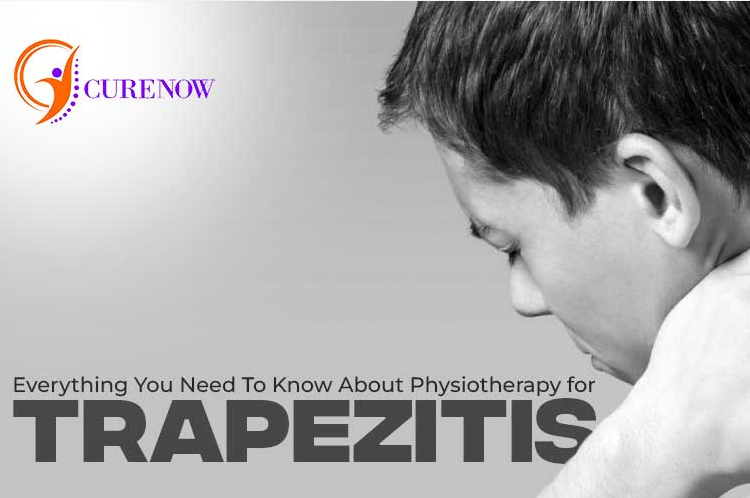
- 10 Nov 2022
- |
- By Admin
Everything You Need To Know About Physiotherapy for Trapezitis
Trapezitis is that stinging, persistent pain at the back of the neck and along the shoulders, which makes you immovable, and every inch of the movement generates intense pain and suffering.
In this blog, we will discuss the symptoms of Trapezitis pain, its causes, and how Physiotherapy can help to get relief and get cured.
Symptoms Of Trapezitis Pain
This pain arises from the trapezius muscle, which causes severe neck spasms, and stiffness around the neck and shoulder.
Common Symptoms Include:
- The patient finds it difficult to move their shoulder and neck, along with head
- The pain runs down from the arms and back
- Tingling and numbness sensation across the arms
- Dizziness while standing and walking
- Pain in the temple, face, jaw, back of the eye, base of the skull
- Range of motion is reduced/limited
- Discomfort while sitting or doing any activity
Common Causes Include:
The most common type of patients for Trapezitis pain include IT employees, who need to sit for long hours in front of the computer. Those who have a habit of watching Television for a prolonged period can also suffer from this pain.
Sportspersons, and athletes who are exposed to Strenuous Repetitive movements (RSI) (also industrial workers, artisans, etc), can also have Trapezitis pain, and face such pain across the neck and shoulder.
Some other causes include:
- Stress, fatigue
- Wrong head posture
- Sitting for a pre-longed period without any back support
- Holding the phone between ear and shoulder, for a long period
- Sleeping on your back, with your head turned sideways
- Long drives on roads
- A profession where you need to be bent for a long period (Architects, Dentists, Secretaries, Computer operators)
Role Of Physiotherapy For Trapezitis Pain
Physiotherapy has been found to be quite effective in providing relief from Trapezitis and curing it with a good success rate.
An expert Physiotherapist can help to release the muscle spasm by using different modalities such as TENS, IFT, ACLT, Ice, Moist heat, Ultrasound, and more, as they can release the trigger points, and give swift relief.
Besides, based on the diagnosis and current stage of this pain, the physiotherapist can suggest the best posture and strengthening and stretching exercises for the neck and shoulder.
For Trapezitis Pain, physiotherapists suggest some rehabilitation exercises which help the patient to regain strength and be flexible.
Some other treatment which has been found to give excellent results:
- Reflexology: Using pressure points to get relief from pain
- Laser Therapy: It can reduce inflammation and triggers healing in a quick time
- Alignment Correction: It can help to rectify bad posture
- And more.
If you looking for expert help in treating Trapezitis Pain, then we at CureNow Wellness can help you. Our UK-trained and certified Physiotherapists can correctly diagnose the condition, and ensure that the patient is able to get relief and a long-term solution.
Book an appointment right here: CureNow.in

- 11 Oct 2022
- |
- By Admin
Explained: Physiotherapy for Facial Palsy / Bell's Palsy
Yes, Physiotherapy can help patients with Facial Palsy / Bell's Palsy to reduce pain, start the recovery process, and gradually lead a normal life.
Before we share how, let’s first discuss what is Facial Palsy / Bell's Palsy, and the common symptoms and causes of the same.
Let’s start!
What Is Facial Palsy / Bell's Palsy?
In Bell’s Palsy/Facial Palsy, the patient experiences sudden weakness of face muscle, mostly on one side, which makes the face appear to droop.
In most cases, both facial palsy and bell’s palsy are used interchangeably, but, there exist some differences.
While facial palsy can be a permanent situation, Bell’s Palsy is temporary and can be cured gradually. In fact, in most cases of Bell’s palsy, the patient is able to recover without any surgical process.
Causes Of Facial Palsy / Bell's Palsy
Still, even after much advancement in medical research, the exact cause of Facial Palsy / Bell's Palsy is unknown.
As per some research, it was found that this condition occurs due to swelling and inflammation of the nerve, which controls the muscles on the face.
In some cases, it can happen due to some spontaneous reaction after a viral infection, especially if a dormant virus becomes re-activated.
Some other causes include Haemorrhage, Vasculitides, HIV, Multiple sclerosis, Intracranial tumor, and/or stroke.
Symptoms Of Facial Palsy / Bell's Palsy
Some common symptoms include:
- Mild to severe paralysis of one side of the face, which can happen suddenly, without any warning
- In some mild cases, there is no paralysis, but the sudden weakness of the facial muscles
- Facial droop is the most common symptom
- The patient has difficulty making facial expressions and finds it tough, almost impossible to smile
- Difficulty in the closing of eyes at the impacted side of the face is also common
- Continuous or random drooling
- Constant pain in and around the jaw and in some cases, even behind the ears
- Headache
- Loss of taste
- The amount of tears and saliva is changed gradually
Physiotherapy For Facial Palsy / Bell's Palsy
Every case of Facial Palsy / Bell's Palsy is different and has certain unique characteristics, pertaining to the patient’s age, the severity of the condition, symptoms, and more.
In typical cases of bell’s palsy, it has been found that physiotherapy has been extremely helpful in the management of pain, increasing the strength, and mobility of the patient, and enabling them to lead a normal life, without any external support.
In our Clinic we have Excellent HMS surge Faradic, Galvanic Facial Stimulator, Which re energizes the Motor Points of Facial muscles and starts Impulses in them, Along with facial Stimulation , targeted facial exercises helps to restore the Power in muscles and regain facial coordination and movement.
Besides, physiotherapy has also been observed to help in the management of Synkinesis, which happens after an injury to facial nerves.
With physiotherapy, patients can be taught to re-learn neuromuscular activities, which enables them to regain strength, range of facial movement, and symmetry.
Book an appointment with our UK-trained and certified physiotherapists to find out more about different physiotherapy-based treatments for Facial Palsy / Bell's Palsy, and take the 1st step towards healing.

- 22 Sep 2022
- |
- By Admin
Physiotherapy For Orthopedics Surgery - Important Facts You Should Know
Orthopedics surgeries are recommended as a last resort, and should not be taken lightly at all: The patient’s entire mobility depends on the success of the surgery.
Hence, it’s very important and critical to start physiotherapy after the orthopedics surgery is completed, and the patient is able to do exercises.
The faster these physiotherapy exercises begin, the better will be the recovery time for the patient, and he/she will be able to carry on with their day to day activities with ease.
After the Orthopedics surgery, physiotherapists will examine the patient, and check the severity of the surgery, range of motions impacted, and recovery stage. Based on these insights, appropriate physical exercises are recommended for the patient.
In this blog, we will discuss about orthopedic surgeries which require physiotherapy, why physiotherapy is important and some rehabilitation-based exercises recommended by expert physiotherapists.
Which Orthopedics Surgeries Need Physiotherapy?
-Spinal Surgery
-Reconstruction of Ankle, elbow or knee
-Meniscectomies
-Replacement of shoulder
-Laminectomies
-Hip or Knee Joint Replacement
-Rotator cuff repairs
-Ligament repair or Reconstruction
-Shoulder surgeries
Consult with our UK-trained and UK-certified physiotherapists at CureNow Wellness to know more about the different types of surgeries that need physiotherapy for fast recovery.
Why Physiotherapy Is Important After Surgery
Basically, physiotherapy helps the patient to regain strength and complete range of motion, so that they are able to handle day-to-day activities without any external help.
With physiotherapy, the patient is able to:
Restore mobility of the patient, especially in the impacted area where surgery was performed
Drastically helps in managing the pain, which remains after surgery
The patient becomes independent, regains confidence
Muscles and tissues which suffer wear and tear are strengthened, and they are able to handle normal activities
Blood clots are prevented
Which Exercises Are Included For Orthopedics Surgery Patients
The exercises which are suggested for patients who have undergone orthopedic surgery are primarily focused on strengthening the muscles and enhancing the mobility of the patient.
Some of these exercises include:
Hip Exercises: This will help in improving joint stability, strengthening joint muscles and improving balance while walking. Some common exercises include Seated Rotation Stretch, Supine Hamstring Stretch and more.
Wrist Range of Motion Exercise: In some cases of orthopedic surgery, the patient experiences loss of range of motion in the wrists. To counter this, wrist range of motion exercises are suggested such as wrist rotation, wrist walks, and more.
Quad Strengthening: Quad consists of the 4 muscles in the front of the thigh. Quad Strengthening exercises help to regain strength in the thigh, and make them flexible. Some common exercises for Quad Strengthening include: Straight Leg Raises, Terminal Knee Extensions and more.
Other exercises include Toe Extensions, Standing Calf Stretch (for Plantar Fasciitis) and Shoulder exercises such as Crossover Arm Stretch & Pendulum.
Before starting any exercise mentioned here, it’s advisable and necessary to consult with expert Physiotherapists who will examine the current state, and accordingly suggest the appropriate exercises.
Book an appointment at CureNow Wellness to start the healing process.

- 08 Sep 2022
- |
- By Admin
Physiotherapy Guide For 5 Major Types Of Sports Injuries
Whoever is active outdoors, and indulges in sports-related activities, for them, sports injuries are a very common issue. As per the IOC manual of sports injuries, it’s defined as “damage to the tissues of the body that occurs as a result of sport or exercise.
Sports injuries can happen due to overtraining, incorrect posture while playing sports, lack of conditioning, and more.
Sometimes, sports injuries can be as simple as an ankle sprain, or in some cases, as complex as acute trauma or repetitive stress, which happens to professional athletes.
Mainly, sports injuries impact bones and soft tissues which include ligaments, muscles, and tendons.
Physiotherapy has been observed to be an effective and efficient way to not only cure sports injuries but also prevent them.
In this blog, we will discuss the Physiotherapy Guide for the 5 most common types of sports injuries, and find out how patients can get relief.
Plantar Fasciitis
Plantar Fasciitis occurs due to the collagen degeneration of the plantar fascia, at the origin, heel, and surrounding of the perifascial structure.
Physiotherapists suggest massage of the Plantar Fascia, along with heel raise and resistance-based ankle inversion (while sitting on the floor) for treating this condition.
Along with that, Electrotherapy Modalities like Digimed-301 & Kinesiotaping are also suggested for speedy recovery.
Ankle Sprain
With a lost balance, or a foot twist, you can experience an ankle sprain, and often it’s painful.
For treating a mild ankle sprain, physiotherapists suggest ice packs, compression, and elevation techniques. However, for a medium-grade ankle sprain, it’s suggested to deploy a complete RICE Program (Rest, Ice, Compression, Elevation), and the patient is asked to immobilize the ankle using a bandage or splint.
Range of motion exercises such as Ankle alphabet, and knee motion, and mild stretching exercises such as Elastic band push and Elastic band pull are advised in this condition.
Depending on the current status, physiotherapists also recommend Digimed-301 & Kinesiotaping, which are Electrotherapy Modalities under Physiotherapy treatment.
ACL Strain / Knee
ACL or anterior cruciate ligament (ACL) is caused when this ligament (in the middle of the knee) is overstretched or experiences tear and wear due to sports or any accident.
ACL results in impacting the stability of the knee and severe ACL injuries may require surgeries.
For mild cases of ACL, physiotherapists suggest exercises such as heel slides, Isometric Quad Contractions, Prone Knee Flexion and Passive Knee Extensions. It has been observed that Digimed-301 & Kinesiotaping are also useful for pain management and speedy recovery. These are Electrotherapy Modalities under physiotherapy treatment.
Quad Strain
When the quadriceps experience acute tearing injury, then the condition is known as quadriceps muscle strain, and it can cause due to fast running or sprinting (for example football)
In the cases of quadriceps muscle strain, physiotherapists can suggest exercises for hip flexion, knee extension and squat control, in order to strengthen the muscles and ensure all range of motions.
In case the physiotherapist deems fit, Digimed-301 & Kinesiotaping can also be suggested, which are Electrotherapy Modalities.
Lower Back Pain
For mild cases of lower back pain, physiotherapists can suggest ice packs, heat application and electrical simulation, which are categorized under passive physical therapy.
In case lower back pain is consistent and intense, then active physical therapies can be suggested, which include Stretching, Dynamic stabilization exercises, and Core strengthening exercises. Electrotherapy Modalities such as Digimed-301 & Kinesiotaping can also be recommended.
It’s always recommended to consult our UK-certified and UK-trained Physiotherapists at CureNow Wellness, who have extensive experience in treating sports injuries.
Book an appointment today!

- 18 Aug 2022
- |
- By Admin
Back Pain: Definition, Symptoms & Causes | Is Physiotherapy For Back Pain Impactful?
Back pain is one of the leading causes of disability across the world, impacting productivity of millions of employees, and impacting their daily life.
If treated at the right time, back pain can be controlled and cured.
In this blog, we will share the symptoms and causes of back pain, and find out whether physiotherapy is impactful for treating back pain?
Let’s start!
Back Pain Definition
Back pain can be described as a physical discomfort, arising anywhere on the spine or back, which ranges from mild to severe.
Symptoms Of Back Pain
Back pain can range from a simple muscle ache to sharp, stinging sensation on the spine and/or back of the person. In some cases, due to the severity of the back pain, the pain can radiate below to the legs and worsen when the patient is bending, twisting, lifting, standing or walking.
It is advisable to consult a doctor when these happens:
- Back pain is persistent for more than 1 week
- Back pain continues to increase and doesn’t reduce even after ample resting
- Spreads down to the legs, or worse, beyond knees
- It causes weakness, numbness and tingling sensation on the legs (or any one leg)
- Weight loss happens unexpectedly, suddenly
In extreme and severe case of back pain, the patient may experience:
- Bowel and/or bladder problem
- Fever
- Patient loses balance, and falls down suddenly
Causes Of Back Pain
Some of the common causes of back pain are:
Muscle or Ligament Strain
Back muscles and spinal ligaments are get strained due to sudden or repeated lifting of weights or awkward movements. Such constant and repeated strain can play havoc with the back and spine, and ligaments, causing back pain.
Ruptured Disks
Disks act as cushion between the vertebrae in the spince. The soft material which is present inside the disks can rupture or bulge, causing pressure on the associated nerve, causing back pain. Interesting thing to note: Ruptured disks can also happen, without back pain, and often gets accidently diagnosed while doing an X-ray.
Arthritis
Arthritis or Osteoarthritis in the spine is one of the leading causes of back pain. It leads to narrowing the space around the spinal cord, which is medically called spinal stenosis.
Osteoporosis
The spine's vertebrae can sometimes undergo minor fractures, which are painful and leads to severe back pain. If the patient’s bones are genetically porous and brittle, such situation can arise.
Is Physiotherapy Impactful For Back Pain Treatment?
A big yes.
For issues pertaining to back pain, physiotherapy is normally recommended, as it helps the patient to control the pain, build strength and flexibility, and improve the gait and movement.
Some of the recommended physiothereapy techniques for treating back pain includes:
- Mobilization or Manipulative physiotherapy
- Stabilization exercises
- Stretching exercises
- Ergonomic advice
- Postural guidelines
- Strengthening exercises
- Aerobic conditioning
- Heat/ice packs
- TENS units
- Lonophoresis
- Ultrasound
- Specific exercises such as Ankle Pumps, Wall Squats, Single Knee to Chest Stretch, Straight Leg Raises and more.
Consult with our UK-trained and Certified Physiotherapists at CureNow Wellness and take the first step towards treating back pain.
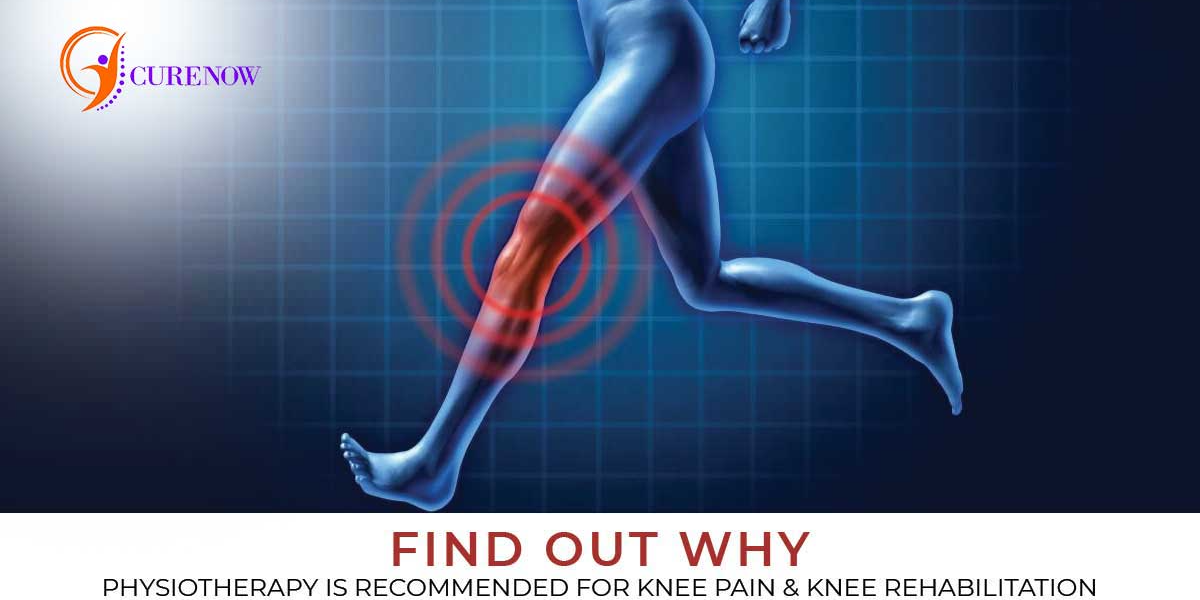
- 04 Aug 2022
- |
- By Admin
Find Out Why Physiotherapy Is Recommended For Knee Pain & Knee Rehabilitation
Knee pain is a pretty common issue, which impacts a majority of people across the world, irrespective of age or gender. Injuries are a common cause of knee pain - Injuries occurring due to a ruptured ligament or a torn cartilage, for example.
In some extreme cases, when the knee joint is worn/damaged, and the patient’s mobility is severely impacted, then knee replacement is done, after which comes the phase of knee rehabilitation.
In both knee pain and knee rehabilitation, physiotherapy is highly recommended, so that the patient is able to carry on with their normal day-to-day routine without any issues.
In this blog, we will understand more about the role of physiotherapy in knee pain and the knee rehabilitation process.
Symptoms Of Knee Pain
Some of the common symptoms of knee pain are:
- Swelling and stiffness in the knee
- Redness around the knee
- Feels warm, when touched
- Popping and crunching noise, when you walk/run/jump
- The patient finds it extremely hard to straighten the knee
- The patient is not able to bear the weight on his knees
- Feels the knee is unstable
- Can’t fully extend and/or flex the knees
- In some cases, mild fever along with swelling and stiffness in the knees
These symptoms are also common in the phase after knee rehabilitation.
If these symptoms are present, then Physiotherapy is the way forward.
How Physiotherapy Can Help In Knee Pain and Knee Rehabilitation?
Once you book an appointment with our expert, UK-trained and Certified Physiotherapists at CureNow Wellness, they will examine your knees and suggest ways to rebuild the strength, flexibility, and movement of the knees with various exercises and equipment.
In the initial examination, the patient’s knees are checked to find out how much can they bend, move and straighten, based on the test conditions.
Usually, depending on the case, a Physiotherapist can suggest these for resolving the knee pain (and to help the patient with knee rehabilitation):
- - Stretches and Exercises
- - Ultrasound Massages
- - Ice and Heat therapy
- - Electrical nerve or muscle stimulation
Different Types Of Examinations Done By Physiotherapists For Knee Pain
Gait Examination
In this test, the patient’s walk is examined and observed. Expert physiotherapists can quickly find out any different movement or issue, while the patient walks.
Palpation
This is a manual examination of the knees and surrounding areas to find any abnormalities or issues, which can be checked physically.
Range of Motion Measurement
In this test, it’s checked how far can the knees straighten or bend. In some cases, special instruments are used to measure how the knees are bending.
Strength Measurement
In this test, physiotherapists check for muscular weakness or imbalance, which is causing knee pain in the patient.
Balance Assessment
In case the balance is impacted due to knee pain, appropriate stress and strain can be directed towards the knee for improving it.
Girth Measurement (Swelling Test)
In case the patient experiences excessive swelling, then the measure of swelling is checked, and appropriate exercises are recommended.
Book an appointment with our expert Physiotherapists at CureNow Wellness, and find out how we can help patients with knee pain and undergoing knee rehabilitation to get back to their normal life.
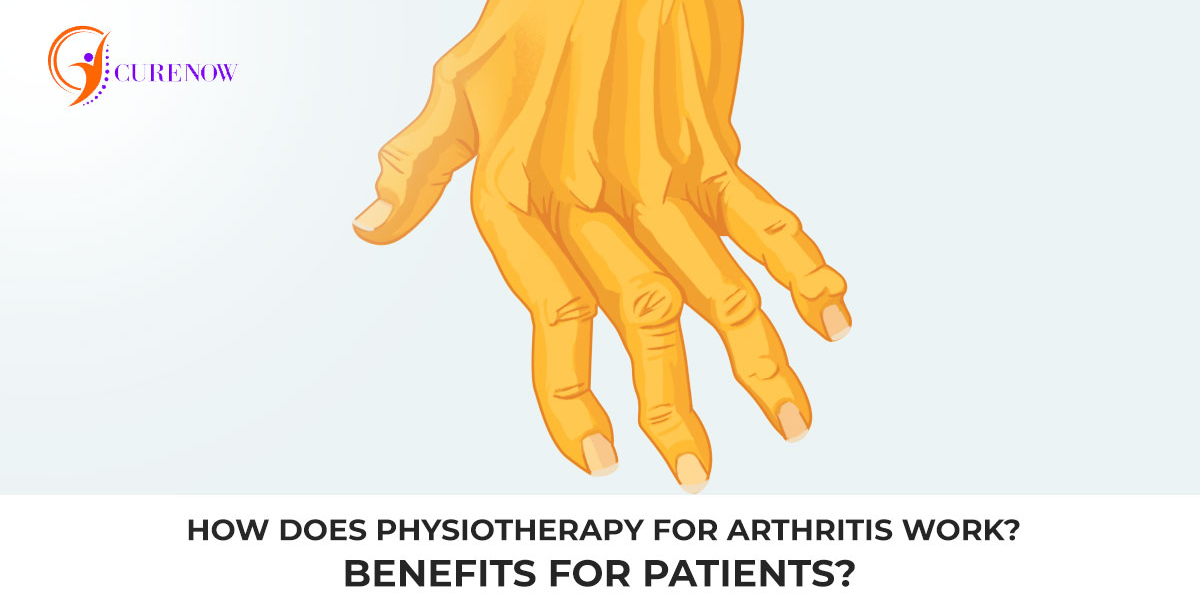
- 25 Jul 2022
- |
- By Admin
How Does Physiotherapy For Arthritis Work? Benefits For Patients?
In this blog, we will discuss how physiotherapy helps to treat and prevent arthritis, and what are the benefits of applying physiotherapy for arthritis.
But first, let’s understand what arthritis is, and its symptoms.
What Is Arthritis?
In layman's terms, arthritis is swelling along with tenderness in one or more joints, anywhere in a patient's body.
But, there is much more to that.
Arthritis is not a single disease or condition, but it collectively refers to joint pain or joint disease, and there are more than 100 types of arthritis along with related conditions.
In the US, arthritis is considered to be a leading cause of disability, and women are most prone to this condition, compared to men. Now, unlike popular opinion, arthritis is not an aging disease.
What Causes Arthritis?
There are mainly two reasons for arthritis:
Osteoarthritis: This is the most common type of arthritis, and this is caused by wear and tear of the joint's cartilage. This cartilage is that hard, slick coating on the ends of the bones, where the joint is actually formed. With the wear and tear, bones start to grind on the bones, leading to friction and the patient suffers pain and restricted movements. In some cases, Osteoarthritis can cause major changes in the bone, along with the deterioration of the connective tissues that hold the joints together.
Rheumatoid arthritis: This is a rare form of arthritis, wherein the body’s immune system directly attacks the lining of the joint capsule, which results in the lining (synovial membrane) becoming inflamed and swollen. In such cases, if not treated, the cartilage and the bone within the joints are destroyed.
Physiotherapy for Arthritis: Benefits & Treatment
With laser-targeted and consistent physiotherapy, arthritis can be prevented and to some extent, cured, which enables the patient to carry on with their normal day-to-day life without any hassles.
Primary benefits of Physiotherapy for Arthritis include:
- Pain Management: The patient is able to manage the pain arising from this condition, and reduce it.
- Proper Understanding: With regular physiotherapy, the patient is able to understand why arthritis happens and can take corrective measures accordingly.
- Fitness: The overall fitness level of the patient improves, making them self-independent to manage their normal day-to-day activities.
- Strengthening: The patient’s muscles and bones are strengthened, and stamina is increased, which eventually negates the impact of arthritis.
- Depending on the state of arthritis, and the body parts impacted, there are different types of physiotherapy exercises that are recommended for the patients.
Some of these exercises include:
Exercises to increase range of motion, muscle strengthening, and absorb shock. Stiffness and swelling are gradually reduced.
Electrostimulation: Electrostimulation provides therapeutic relief to the patient, and is found to be an effective treatment plan post-surgery.
Balneotherapy: Also known as hydrotherapy, this is an experimental treatment, which can help the patient to reduce pain, and improves mobility and functionality of the joints.
Consult with our UK-trained and certified Physiotherapists at CureNow Wellness, and find out how physiotherapy can help arthritis patients to reduce pain, and manage their day-to-day activities with ease.
Book an appointment today, and start the healing process.
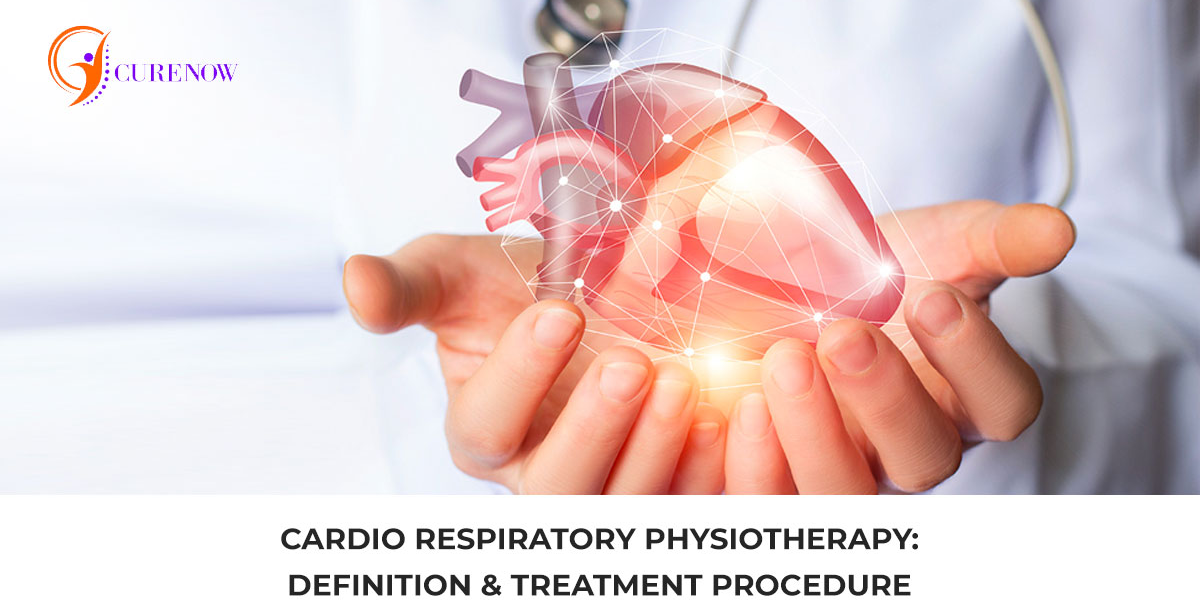
- 13 Jul 2022
- |
- By Admin
Cardio-Respiratory Physiotherapy - Definition & Treatment Procedure
What Is Cardio Respiratory Physiotherapy?
For patients impacted by diseases related to the heart and lungs, Cardiorespiratory Physiotherapy is recommended. With Cardiorespiratory Physiotherapy, heart and lung diseases can also be prevented, and a comprehensive rehabilitation process can be started.
With Cardiorespiratory Physiotherapy, lung secretions can be cleared, lung collapse can be prevented and patients can breathe easily, without much effort.
In children with acute respiratory illness, Cardiorespiratory Physiotherapy is quite effective, especially in those cases, where external ventilation support is required for patients.
For heart patients, Cardiorespiratory physiotherapy will help in increasing blood flow and enhancing strength and stamina for lowering heart-related diseases.
Common Conditions For
Common cardiorespiratory conditions, when cardiorespiratory physiotherapy is recommended:
- Congestive Cardiac Failure (CCF)
- Peripheral Vascular Disease
- Asthma
- Emphysema
- Hypertension
- Chronic Obstructive Pulmonary Disease (COPD)
- Angina
- Heart or lung injury or surgery
- Heart Attack (MI)
- Bronchitis
- Respiratory Infections, i.e. Pneumonia
- Bronchiectasis
Treatment Procedure Under Cardiorespiratory Physiotherapy
- Depending on the condition and severity of the patient, different treatment procedures are advised for patients with heart and lung diseases, both in-hospital and/or at home.
- Some of the common treatment procedures under Cardiorespiratory physiotherapy include (but are not limited to..)
- Deep Breathing Exercises: With deep breathing exercises, the patient’s lungs can absorb more oxygen which directly results in improving respiratory functionality, along with chest expansion.
- Breathing Facilitation Exercises: With breathing facilitation exercises, the lungs' capacity is increased, leading to improved and seamless breathing.
- Percussions and Vibrations: These are manual physiotherapy techniques, which are applied to the chest wall. With Percussion, the sputum in the lungs is loosened, and it can stimulate coughing, which eventually helps the patient to loosen secretions and makes breathing easy. With vibrations, expiratory flow rates are increased and cause changes to the intrathoracic pressures. Both of these manual exercises are done by a therapist on the patient.
- Coughing and Breathing Strategies: These are normal physiotherapy exercises, which the patient can do on their own, and helps the patient to manage shortness of breath.
- Breathing and Circulation Exercises: These are advanced cardiorespiratory exercises that help the patients to prevent further respiratory and vascular complications. Chest infection and deep venous thrombosis (DVTs) can be prevented with breathing and circulation exercises.
- Mobility Assistance: Mobility assistance is very helpful and relevant for those patients who are recovering from injuries or surgeries related to the heart. With mobility assistance from expert physiotherapists, the patients can sit up from bed, move, stand and walk on their own, and gradually return to normal life.
- Customized tailored exercises: In some cases, physiotherapists having expertise and experience in cardiorespiratory exercises can formulate special, customized exercises that help the patient to control their breathing patterns, and develop muscle strength and stamina.
If you are searching for expert guidance for cardiorespiratory physiotherapy, then our UK-trained and certified Physiotherapists at CureNow Wellness can help you, right away. Our seasoned physiotherapists can diagnose the present condition, and suggest the best way forward.
Book an appointment with our Physiotherapists today, and start the healing process.
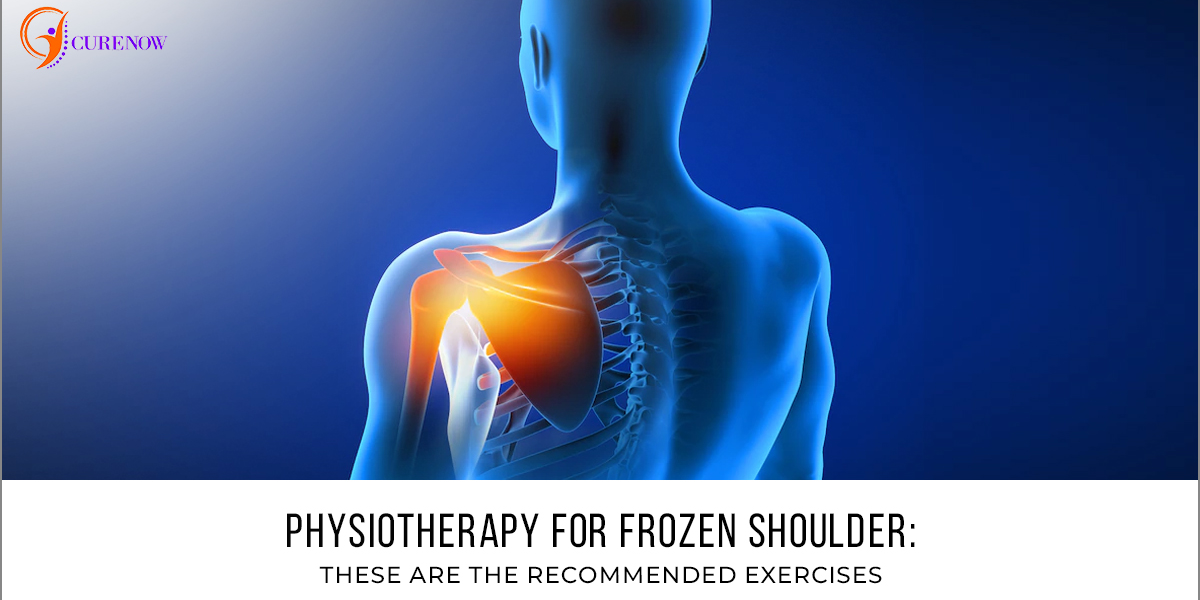
- 22 Jun 2022
- |
- By Admin
Physiotherapy For Frozen Shoulder: These Are The Recommended Exercises
What Is a Frozen Shoulder?
Frozen shoulder, which is also known as adhesive capsulitis, is a condition wherein the patient faces stiffness and pain in the shoulder joint. Normally, there are three stages of Frozen Shoulder.
Freezing Stage: When the patient moves the shoulder, in any direction, or for any purpose, then pain is experienced and this causes the range of motion to be limited.
Frozen Stage: In this stage, although the pain starts to diminish, the stiffness of the shoulder increases, and using the shoulder becomes even tougher. The range of motion becomes further limited.
Thawing Stage: In this stage, the range of motion gradually improves and the patient is able to move the shoulder.
Note here, that in some extreme cases, the pain resulting from frozen shoulders decreases during the day, but increases during the night while sleeping.
What Are The Causes Of Frozen Shoulder?
Frozen shoulder occurs when the capsule of connective tissues present in the shoulder joint thickens, resulting in tightening of the shoulder joint, and subsequently, its movement is restricted.
This capsule of connective tissues present in the shoulder joint encases bones, ligaments, and tendons, which support the shoulder’s movement and flexibility.
Now, the big question is, why does this happen?
As per some experts, diabetes and thyroid patients are more prone to frozen shoulders. And especially those patients, who have been immobilized due to any recovery from surgery or injuries. Patients having a cast on their arm for holding the arm in one position can also suffer from frozen shoulders.
Interestingly, women between the age of 40 to 70 years are more prone to frozen shoulders, compared to men, although both men and women can have this condition.
Physiotherapy Exercises For Frozen Shoulders
For treating frozen shoulders, physiotherapy is recommended since the exercises help the patient to speed up the recovery process.
Before we share the physiotherapy exercises recommended for frozen shoulders, it’s important to note that these exercises depend on the stage of the frozen shoulder.
It’s always advisable to consult with expert Physiotherapists who have experience in treating frozen shoulders, before initiating these exercises.
Here are the recommended exercises for treating frozen shoulder:
Shoulder stretches
There are two types of stretching exercises: Pendulum stretch and towel stretch.
In pendulum stretch, relax your shoulders, then stand and lean over slightly, and allow the arms to hang down. Then swing the arm in a small circle, max a foot in diameter. Make such 10-12 revolutions in each direction, once a day. Gradually, increase the diameter.
In towel stretch, take a towel of approximately three feet, around your back, hold one end of the towel with one hand, and use the other hand to stretch the towel horizontally. Use the unaffected arm to pull the impacted arm upward using the towel.
Finger Walk
Face a wall directly, away three-quarters of an arm’s length, and then reach out.
Touch the wall at waist level, using only the fingertips of the affected arm. Now bend the elbow slightly, and slowly walk your fingers up the wall, just like a spider. Do it until the arm is raised as far as you can do it comfortably.
Always use your fingers to do this crawling, not the shoulder muscles.
Rope and pulley stretches, along with internal and external rotation are also recommended for frozen shoulders, and it needs some external help from the physiotherapists.
If you have frozen shoulder, then you can join our Frozen Shoulder Rehab Protocol at CureNow, and avail the best treatment for this condition.
Consult with UK-trained and certified physiotherapists from CureNow Wellness, and find out which exercises will bring in the best results, depending on the stage of the frozen shoulder.
Book an appointment today at CureNow.in
Our address: CureNow Wellness Pvt. Ltd.
F-Residences, Shop # 25, First Floor, Wadgaon Sheri, Kalyani Nagar Annexe, Pune - 411014, Maharashtra. Contact : +91 9545345300
Review Us on Google - https://bit.ly/3wrKjrN

- 08 Jun 2022
- |
- By Admin
Causes & Symptoms Of Cervical Spondylosis: Can Physiotherapy Help In Treatment?
What is Cervical spondylosis?
Cervical spondylosis is the medical term for the general wear and tear impacting the spinal disks in the neck, due to old age and other factors. Once the disc dehydrates, it starts to shrink, which gives rise to symptoms of osteoarthritis (such as bony spurs, which are bony projections along the edges of the bone)
Old age is the primary reason for Cervical spondylosis, and as per recent research, more than 85% of people aged above 60 years, face this one of the other forms of this condition.
Cause of Cervical spondylosis
With natural aging, the bones and cartilages that make up the backbone and neck gradually deteriorate, leading to several changes that form the root cause of Cervical spondylosis.
These changes include:
Dehydrated Disk
For the vertebrae of the spine, the discs act as natural cushions. Once a person crosses 40 years of age, these disks start to dry up and start shrinking, which leads to more bone to bone contact between the vertebrae. This leads to cases of Cervical spondylosis.
Herniated Disks
The exterior of the spinal disks too is impacted with age: Often, cracks start to appear, which triggers herniated or bulging disks. Once this happens, it can press and impact the spinal cord and nerve roots.
Bone Spurs
Due to disk degeneration, the spine starts producing additional amounts of bones, as a natural (but misguided) effort to strengthen the spine. Such extra amounts of bone pinch the spinal cord and nerve roots. This is a typical case of Cervical spondylosis.
Stiff Ligaments
Cords of tissue, which connect bone with the bone are ligaments, and once ligaments become stiff due to aging, the neck becomes less flexible and range of motion is impacted. This leads to Cervical spondylosis.
Patients who are overweight, and those who avoid exercise are also prone to this condition, along with those who are lifting heavy weights, which need lots of bending and twisting.
Some other causes include: past neck injuries, past spine injuries, slipped disk (ruptured), and/or severe arthritis.
Symptoms of Cervical Spondylosis
Interestingly, a majority of patients with Cervical Spondylosis don't experience any symptoms. However, once the symptoms appear, they normally include stiff pain and stiffness in the neck.
In extreme cases of Cervical Spondylosis, the space required by the spinal cord and nerve roots that pass through the spine to the rest of the body becomes narrow. And this leads to:
Numbness and/or abnormal sensation in the shoulders and arms, and in some cases legs too.
Coordination is impacted, and the patient finds it difficult to walk, run or jump
Bladder movement is impacted
Consistent headaches, centered in the back of the head
Intense pain on the inside of shoulder blade and frozen shoulder too, in some cases
Can Physiotherapy Help In Treating Cervical Spondylosis?
Depending on the stage of Cervical Spondylosis, physiotherapy is recommended for patients with Cervical Spondylosis.
With specialized and dedicated physiotherapy exercises such as massage, mobilization, manipulation, ultrasonic therapy, Interferential therapy etc, the patients can experience drastic improvement.
With regular and targeted physiotherapy exercises, the patient will have: improved blood flow, decreased swelling, reduced muscle spasm, restoration of a normal range of motion, lubricate joint surfaces, reduced pain, painless neck and arms movement, and more.
At CureNow, we have Computerized Static & Intermittent Cervical Traction that will help in faster recovery from Cervical Spondylosis. Depending on the prevalent stage, and the symptoms, our Physiotherapists will correctly diagnose the condition, and suggest the best exercises and treatment plan.
Consult with our UK-trained and certified Physiotherapists at CureNow Wellness, and initiate the healing process for Cervical Spondylosis.
Book an appointment today at: CureNow.in.
Our address: CureNow Wellness Pvt. Ltd.
F-Residences, Shop # 25, First Floor, Wadgaon Sheri, Kalyani Nagar Annexe, Pune - 411014, Maharashtra. Contact : +91 9545345300
Review Us on Google - https://bit.ly/3wrKjrN

- 20 May 2022
- |
- By Admin
Top 5 Inherent Benefits Of Physiotherapy For Back Pain
Did you know that the occurrence of low back pain in India is alarming with nearly 60% of the people in India having suffered from low back pain at some time during their lifespan?
With timely attention to back pain, you can not only save expensive treatments and surgeries but also lead a healthy, pain-free life without any form of back pain.
In this blog, we will focus on the top 5 benefits of physiotherapy, when it comes to treating and minimizing back pain.
But first, let’s understand what back pain is, and some of the symptoms.
What Is Back Pain?
Back pain, also called Backache or Lumbago is experienced in the back of the person and comes from the muscles that surround the spine.
In the most common form, back pain impacts the curve of the lower back and can move all the way upto the base of the neck.
Now, these two particular areas support the weight of your entire body, and pain results in great discomfort and disrupts normal day-to-day life.
Some of the most common causes of back pain are incorrect sitting/sleeping posture, injuries or accidents, and falls. Excessive sports and outdoor activities or lifting weights can also lead to back pain. Pregnancy and sudden weight gain can also lead to back pain.
Due to these reasons, your back can experience minor muscle strain, or in some extreme cases, herniated disks and fractures, that can lead to damaging the spinal cord, and back pain.
Benefits Of Physiotherapy For Back Pain
Most of the time, Physiotherapy is recommended for those who are suffering from back pain, and it brings results and relief to the patients.
Exercises such as stretching, Dynamic stabilization, and more are recommended for treating back pain, and more importantly, reducing the pain.
Here are the 5 benefits of Physiotherapy, when it comes to back pain:
- Muscles surrounding the spine are strengthened and made robust, which takes the pressure off spinal discs and facet joints, and thus, gradually back pain is reduced to a larger extent..
- Stiffness is removed, which makes the person more mobile, and improves body movements.
- Circulation of blood is greatly improved, which results in the proper distribution of nutrients to all the body parts, including the spinal cord. This helps to treat back pain faster.
- More and more endorphins are released into the body, which acts as a natural painkiller. With more endorphins, the dependence on pain killer medicines is reduced, which positively impacts the entire body.
- The severity of back pain is greatly reduced, with a visible reduction in the frequency of back pain. Once the severity reduces, the issue of back pain also goes away, gradually.
If you are looking for back pain treatment, then we at CureNow Wellness can help you, right away. Our UK-trained and certified Physiotherapists will diagnose the condition, and accordingly devise a result-oriented Physiotherapy treatment plan, which will help the patient to eliminate back pain and lead a normal, healthy life.
We will also suggest the best postures and ergonomics for ensuring that your back is always in the best condition and health.
Book an appointment today, and start the healing process. Visit CureNow Wellness today.
Our address: CureNow Wellness Pvt. Ltd.
F-Residences, Shop # 25, First Floor, Wadgaon Sheri, Kalyani Nagar Annexe, Pune - 411014, Maharashtra. Contact : +91 9545345300

- 05 May 2022
- |
- By Admin
What is Parkinson's Disease? What Are The Physiotherapy Treatments For Parkinson's Disease?
First recognized as a disease in the early 1800s by James Parkinson, Parkinson's Disease is a neurological disorder. An estimated 7-10 million patients have Parkinson's Disease, globally.
In this blog, we will find out what Parkinson's Disease is, the causes and symptoms and how Physiotherapy can help patients with Parkinson's Disease to lead a normal life.
What is Parkinson's Disease?
Parkinson's Disease is a severe neurodegenerative disorder that directly impacts the patient’s body movements and disrupts their normal day-to-day functioning.
Critical cognitive processes of the patient are severely impacted, that includes regulation, planning, and execution of behavior. One of the most common manifestations of this disease is Bradykinesia, which means slowness of movement along with rigidity, weakness, and tremor.
In the late stage of Parkinson’s disease, the patient finds it difficult to chew, since it impacts the muscles in the mouth, leading to poor nutrition and in some extreme cases, choking.
Causes and Symptoms of Parkinson’s Disease
Parkinson’s disease is caused by the loss of nerve cells in the substantia nigra, which is a part of the brain that produces dopamine.
Now, dopamine is a chemical that acts as a messenger between the brain and nervous system and helps humans to coordinate body movements, and to control their movements.
Once the quantity of dopamine drops in the brain, the person is not able to control his/her body movements, and the overall functioning of the body slows down, thereby impacting the patient’s day-to-day normal life.
Some of the most common and visible symptoms of Parkinson’s disease include:
●Slowed movement or bradykinesia
●Tremors in fingers, and hands
●Rigidity in muscles
●Improper posture and gait
●Loss of balance while walking, standing, running, jumping
●Unconscious or automatic body movements such as blinking, yawning, smiling, etc gets impacted, and eventually are lost
●Speech becomes impaired, and monotone
●It becomes very hard to write
Physiotherapy for Parkinson's Disease
In recent times, suggestions and recommendations for Physiotherapy have rapidly increased for helping patients with Parkinson’s disease, because of the positive results attained.
Even the National Institute for Health and Clinical Excellence has recommended physiotherapy for Parkinson’s disease patients, across all the stages.
Two main objectives of conducting physiotherapy for Parkinson’s disease patients are:
●Maximize functionality and body movements of the patients
●Minimizing secondary complications, that may arise during movement rehabilitation
Physiotherapists who are treating such patients focus on improving and enhancing the patient’s posture, upper limb functions, transfers, physical capacity, balance, and overall activity.
Depending on the situation and stage, Physiotherapists can also suggest cognitive movement and cueing strategies which will eventually make the patient self-reliant and independent to carry on with their normal day-to-day activities.
Consult with our UK-trained and certified Physiotherapists at CureNow Wellness to diagnose the condition of patients impacted by Parkinson’s Disease, who will guide and consult regarding the best strategies related to Physiotherapy.
Book an appointment with us, and take the 1st step towards enabling the patient to lead a normal life. Visit us at CureNow.in.
Our address: CureNow Wellness Pvt. Ltd.
F-Residences, Shop # 25, First Floor, Wadgaon Sheri, Kalyani Nagar Annexe, Pune - 411014, Maharashtra. Contact : +91 9545345300
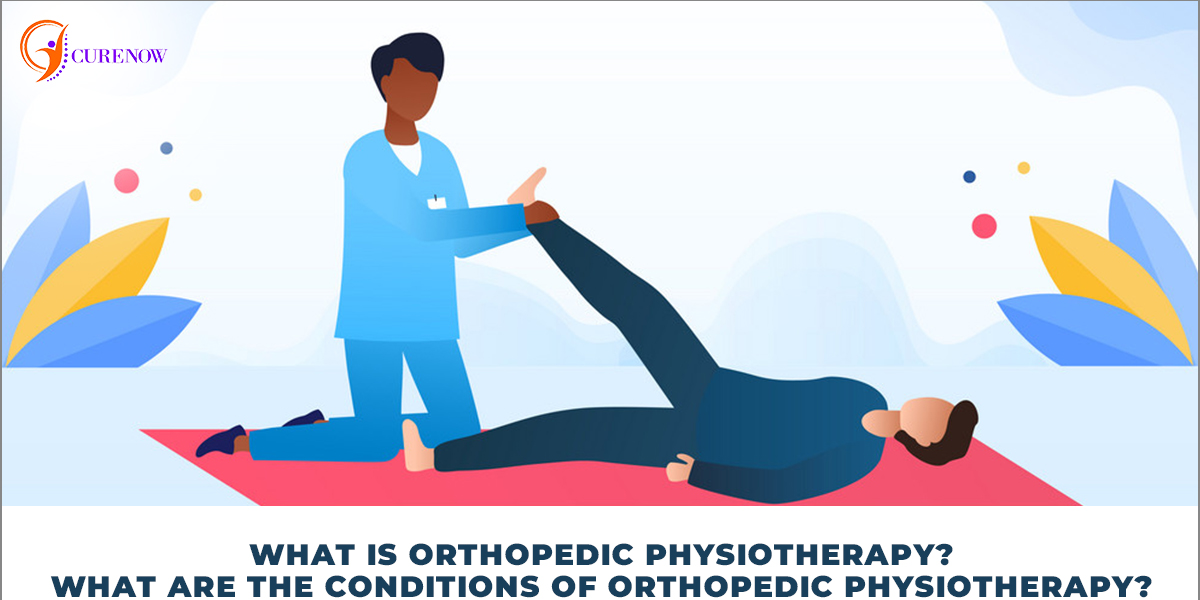
- 22 Apr 2022
- |
- By Admin
What Is Orthopedic Physiotherapy? What Are The Conditions Of Orthopedic Physiotherapy?
For patients who are recovering from any injury or accident, or surgery, orthopedic physiotherapy can be life-changing. Patients can regain their strength, carry on with their normal day-to-day activities and gradually lead a normal life.
In this blog, we will explain what Orthopedic physiotherapy is, and the conditions of orthopedic physiotherapy, which will help our readers to understand it better.
What Is Orthopedic Physiotherapy?
Orthopedic physiotherapy involves treatment and care of a patient’s musculoskeletal system, which includes:
Connective tissue
Ligaments
Tendons
Bones
Joints
Muscles
Based on the severity of the condition, our expert Physiotherapists will suggest:
Appropriate and feasible movement diagnosis
Comprehensive treatment plan
How and when to administer therapeutic care
Educating and training the patient to manage the current injuries, and ensure that such injuries are prevented in future
Types Of Orthopedic Physiotherapy
Some of the common types of orthopedic physiotherapy are:
Sports Physiotherapy
Physical rehabilitation
Knee Therapy
Hand therapy
Shoulder therapy
Knee therapy
Pediatric orthopedics
Conditions for Orthopedic Physiotherapy
Now, the big question: When should a patient undergo Orthopedic Physiotherapy?
Here are some common conditions, wherein orthopedic physiotherapy is recommended:
Ligament Strain, Sprain, or Tear
In cases of ligament strain, sprain or tear, orthopedic physiotherapy can help to relieve pain and enhance flexibility, coordination, and strength. Patients are also suggested to do basic exercises for stretching and strengthening, which can help the patient to recover faster.
Fracture Rehabilitation
Once the fracture has been immobilized, the patient's rehabilitation can be immediately started with orthopedic physiotherapy. With fracture rehabilitation, patients can gradually lift weights, return to full functionality and movement, regain strength and the full range of movements.
As an immediate effect, the patient is able to reduce pain and swelling.
Inflammation of Tendons
Inflammation of tendons or tendonitis can be effectively cured and healed with orthopedic physiotherapy. After the diagnosis of the condition, physiotherapists can suggest various stretches and exercises reduce the inflammation, and encourage the affected tendons to heal and regain strength.
In specific cases, the physiotherapists can also suggest the usage of arch supports, heel lifts, and splints to support the impacted tendon and enable the patient to carry on with their normal day-to-day activities.
Osteoporosis
Osteoporosis is a disorder of the skeleton, wherein the bones start losing minerals and their support capabilities, which leads to bones becoming brittle, and prone to injuries and in extreme cases, fractures.
With dedicated and targeted orthopedic physiotherapy, patients can be taught proper postures, movements, and actions that can prevent injuries. Besides, with regular exercises and physical therapy, the patient can enhance their bone mass, strengthen their muscles and bones, and improve balance to a larger degree.
Osteoarthritis
Common among senior citizens, Osteoarthritis is considered one of the most common types of arthritis. In this condition, the joints undergo continuous deterioration, and inflammation, which disrupts regular movement and walking/sitting/running activities.
With regular and guided Orthopedic physiotherapy, patients of can Osteoarthritis can regain mobility, strength, and function, and reduce pain in the joints to a larger extent. Training in correct posture and body movement is also critical in this endeavor.
Other common conditions for initiating Orthopedic Physiotherapy include Rheumatoid-Arthritis, and Surgical Rehabilitation of the Hip, Shoulder, Knee, and Foot/Ankle.
Get in touch with our UK-trained and certified Physiotherapists at CureNow to know more about Orthopedic physiotherapy, and how patients can get benefited from it.
Book an appointment today.
Our address:
CureNow Wellness Pvt. Ltd.
F-Residences, Shop # 25, First Floor, Wadgaon Sheri, Kalyani Nagar Annexe, Pune - 411014, Maharashtra. Contact : +91 9545345300

- 08 Apr 2022
- |
- By Admin
What Is Neurology Physiotherapy? Find Out Top Benefits Of Neurology Physiotherapy
For rehabilitating patients with neurological conditions, neurology physiotherapy is recommended. In this blog, we will share what is neurological physiotherapy, and how patients can get befitted with this.
What Is Neurological Physiotherapy?
With neurology physiotherapy, patients with movement and function disorders are treated. It mainly involves those whose nervous and neuromuscular systems are impacted, and they are unable to function normally.
In order to start the healing process, and rehabilitate them, neurology physiotherapy is recommended by physiotherapists.
Some of the common neurological conditions for which neurology physiotherapy can be suggested are:
- Parkinson’s disease
- Stroke (CVA or TIA)
- Multiple sclerosis
- Spinal Cord injuries
- Traumatic brain injuries
- Functional Neurological Disorders
In such conditions, the patient’s movement and functionalities are severely impacted. Some common symptoms include:
- Poor balance
- Poor coordination
- Uncontrolled muscle spasm
- Muscle weakness
- Tremors
- Complete or partial loss of function
- Complete or partial loss of sensation
With neurological physiotherapy, patients can gradually regain balance, restore critical functionalities, strengthen their muscles which can make them independent, and enable them to carry on with their day-to-day activities without any external help.
Neurology Physiotherapy: Principles
The primary objective of neurology physiotherapy is to help the patient to rehabilitate, and start the healing process.
The principles on which neurology physiotherapy is based:
- In case the brain undergoes any injury, it has the capability to adapt to the new reality and change
- Deploying a problem-solving approach, based on the patient’s injury and the extent of the nervous and neuromuscular disorder
- Encouraging movement and range of motion, wherever possible
- Some most impactful activities involve: sensory stimulation, strengthening, verbal feedback, positive reinforcement
- Encouraging the patient to conduct normal movement and functions
- Improving and correcting the posture of the patients, while sitting, standing, or lying
- Preventing and stopping muscle shortening, since it leads to spasticity and abnormal movement
- Engaging the patient in various activities and movements
- Ensuring that the patient is able to achieve independence and higher quality of life
Benefits Of Neurology Physiotherapy
With regular, consistent and focused neurology physiotherapy, patients can benefit in the following ways:
- Movements become seamless, and they are precise and goal-oriented
- Normal patterns of movement are regained
- Muscle strength is improved
- Range of movement increases
- Fine motor skills improve by a larger degree
- Both posture and balance improvise
- Spasticity and contractures are reduced, by lengthening tight muscles
- Fitness level and endurance is increased
- Breathing becomes normal gradually
- The risk of falling down reduces
- The patient is able to carry on a normal day to day activities with ease
- Stress and anxiety are reduced
- Pain is relieved gradually
- The patient becomes more independent
- The patient is able to achieve maximum potential
Based on the severity and extent of the neurological conditions, Physiotherapists at CureNow Wellness will suggest the best strategy and plan for neurology physiotherapy.
Our UK-trained and certified physiotherapists can diagnose the condition, and then accordingly consult the best way forward.
Our address: CureNow Wellness Pvt. Ltd.
Book an appointment with us today, and start the healing process.
F-Residences, Shop # 25, First Floor, Wadgaon Sheri, Kalyani Nagar Annexe, Pune - 411014, Maharashtra. Contact : +91 9545345300
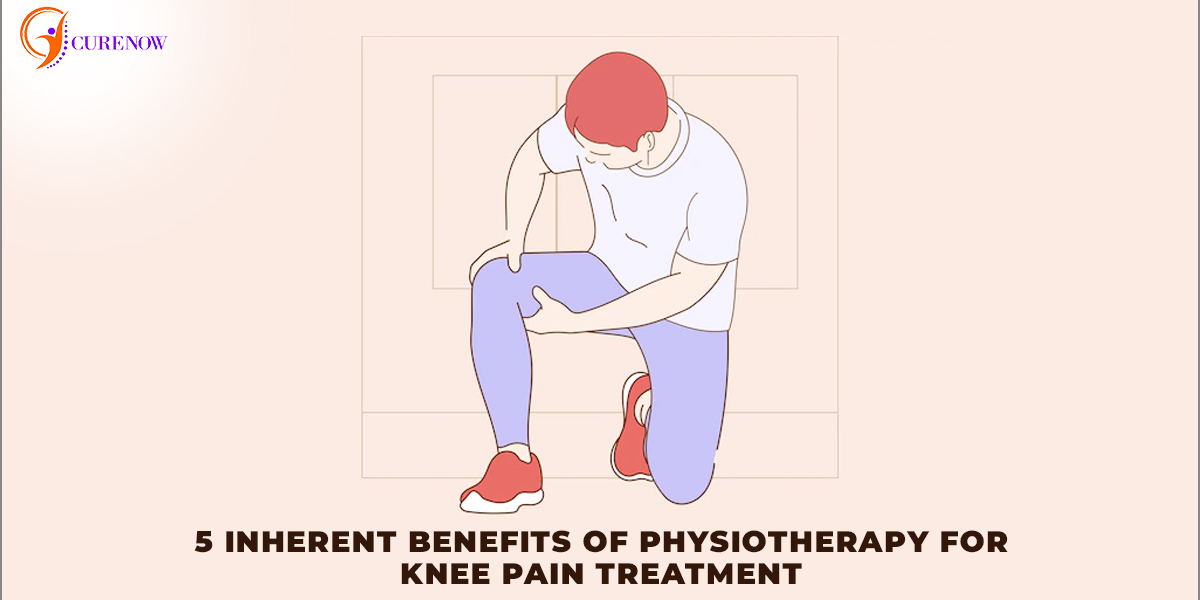
- 24 Mar 2022
- |
- By Admin
5 Inherent Benefits Of Physiotherapy For Knee Pain Treatment
Consistent knee pain is a major obstacle for leading a normal life: While the pain itself makes it bad, the soreness and stiffness due to knee pain makes it worse. The patient finds it difficult to walk, run or jump and often needs external assistance for the same.
In some extreme cases, knee pain can also impact the balance of the legs, and the patient may even fall down or trip while walking.
With regular and dedicated physiotherapy, patients of knee pain can gradually recover, and carry on with their normal day to day activities with ease. However, depending on the severity of the knee pain, different physiotherapy exercises are recommended by the physiotherapists, which leads to gradual improvement and subsequent recovery.
Some of the common symptoms of knee pain include:
- Stiffness and swelling of joints
- Constant pain
- Severe pain when the knee is being used like walking, jumping, running
- Crunching and popping noise when the patient is sitting or getting up
- Difficulty and/or inability to straighten or flex or bend the knees
- Unstable knees due to weakness
- Deformity around the knee joints
- Consistent knee pain that occurs in night or cold weather
- Long term knee pain, that is sustained beyond few days
5 Benefits Of Physiotherapy For Knee Pain Treatment
Now, let’s discuss the inherent benefits of knee pain treatment:
Minimal Need For Medications
It’s a general tendency to lean towards pain killers and medications to treat pain, not only knee pain, but any type of pain. And this is not recommended for a longer duration of time. Although painkillers will make the brain forget about the pain, but the pain still remains. And in most of the cases, the patients get dependent on the medications to get instant relief from pain, and this makes the situation even worse.
Avoiding Surgery
In case the knee ailment deteriorates, then surgery is the last option, but which needs to be avoided. Surgery is expensive, risky, invasive and can put a huge toll on the patient’s overall health and wellness.
With gradual and dedicated physiotherapy, surgery can be avoided, and the condition can be improvised gradually.
Enhanced Mobility
The biggest benefit of long term and dedicated physiotherapy is that, the patient of knee pain is able to increase mobility, and carry on with their normal day to day activities with ease: Walking, running, playing with children, jumping etc can be resumed with physiotherapy as the patient is able to regain strength, range of motion and mobility functions.
Ofcourse, this cannot happen overnight, but with determination, patience and focus.
Improvement In Balance
As mentioned earlier, in severe cases of knee pain, balance of the patient can deteriorate, and this can even lead to falling down.
This imbalance arising due to knee pain can be resolved with dedicated and consistent physiotherapy, and the patient can experience a marked difference in their gait and balance.
Avoiding Pain In The Future
Expert Physiotherapists can suggest techniques and ways to ensure that the patient is able to avoid pain in the future as well, after recovering from the present knee pain condition.
At CureNow Wellness, we have experienced physiotherapists, who have years of experience in treating knee pain and enhancing mobility, strength and balance of the patients. Our UK-trained and certified Physiotherapists will correctly diagnose the conditions, and suggest the best way forward.
Our address: CureNow Wellness Pvt. Ltd.
F-Residences, Shop # 25, First Floor, Wadgaon Sheri, Kalyani Nagar Annexe, Pune - 411014, Maharashtra. Contact : +91 9545345300

- 10 Mar 2022
- |
- By Admin
What Is Sports Injury? How Can Physiotherapy Help In Treating Sports Injuries?
In this blog, we will discuss sports injuries, and find out how physiotherapy is among the best treatment protocols for recovering from sports injuries.
We will share some of the best practices related to sports injury treatment via Physiotherapy and will reveal how CureNow Wellness can help patients successfully recover from sports injuries.
What Is Sports Injury?
Sports injuries are common injuries that are caused by a direct impact or overuse or a force, which is greater than the withstanding power of that body part. Generally, sports injuries are classified into two categories: Acute and Chronic.
While acute sports injuries are caused suddenly such as sprained ankles due to an awkward landing, chronic sports injuries are caused by repeated overuse/abuse of muscle groups or joints, leading to more severe injuries.
However, structural abnormalities from birth, and/or poor techniques of playing sports can also gradually lead to chronic sports injuries.
Types Of Sports Injuries
Some of the most common types of sports injuries (both acute and chronic) with common symptoms of stiffness, consistent pain, swelling include:
Ankle Sprain,
Tennis elbow
Knee injuries
Sprains
Muscle strain
Dislocations
Strained hamstring
Shin splints
And more.
How Can Physiotherapy Help In Sports Injury Treatment
Physiotherapy has been found to be extremely useful in treating sports injuries, with a high percentage of success rate. With dedicated and focused physiotherapy treatment, patients with sports injuries can not only recover, but also avoid future injuries, and remain fit and active for a long period of time.
This is how Physiotherapy can help in recovering from sports injuries:
Range Of Motion Exercises (ROM)
For reducing the stiffness of muscles and joints, Physiotherapists often recommend a range of motion, which is carried over a specific body part for fast recovery.
When physiotherapists assist patients to perform a range of motion exercises, it’s known as passive ROM, and if the patient is able to perform all the exercises on their own, then it’s called active ROM.
Strengthening
One of the biggest drawbacks of experiencing sports injuries is that it makes the muscles weak. And this is the reason Physiotherapists perform strengthening exercises on patients with sports injuries.
While static strengthening exercises exert muscles at high intensity, without any movement of the joints, dynamic strengthening exercises make the muscles move. Example of static strengthening exercises: the patient holds a squat position or a push-up position for a specific time period. Examples of dynamic strengthening exercises include walking, running, or lifting weights.
Low-Level Laser
Inflammation and muscle pain arising due to sports injuries can be treated with low-level laser wherein the healing power of light is used on specific body parts, impacted by sports injuries. This is an alternative to surgery and medications, and gradually gaining popularity all across.
In case of musculoskeletal sports injuries, low-level laser is highly recommended by expert physiotherapists.
Ice packs and hot packs are other beneficial physiotherapy-based treatments for treating sports injuries and providing relief from stiffness and pain.
At CureNow Wellness, we have seasoned physiotherapists who are trained and certified in the UK and have expertise in successfully treating sports injuries.
Book an appointment with our sports physiotherapists and start the healing process right away.
Our address: CureNow Wellness Pvt. Ltd.
F-Residences, Shop # 25, First Floor, Wadgaon Sheri, Kalyani Nagar Annexe, Pune - 411014, Maharashtra. Contact : +91 9545345300

- 24 Feb 2022
- |
- By Admin
Importance & Relevance Of Respiratory Physiotherapy
Chest Physiotherapy, also known as Respiratory Physiotherapy is recommended for bronchiectasis, asthma, chronic bronchitis, or pulmonary fibrosis patients.
Besides, patients who have recurrent chest infections, pneumonia, and other chest-related issues, and recent respiratory, abdominal, or cardiac surgery can also do respiratory physiotherapy for getting relief and for starting the healing process.
In this blog, we will discuss more about respiratory physiotherapy, and what benefits can patients get, with appropriate physiotherapy exercises.
What Is Respiratory Physiotherapy?
Respiratory or Chest physiotherapy is a broad term that is employed to describe physiotherapy treatments and techniques targeted for improving respiratory efficiency, by clearing secretion from the lungs and improving airway clearance.
With proper and guided respiratory physiotherapy, the lungs of the patients will experience a decrease of work for breathing, expansion of the lungs is promoted and lung collapse is prevented.
Respiratory physiotherapy is considered as an important, adjuvant therapy for patients who are suffering from:
●Chronic respiratory diseases such as COPD, bronchiectasis, cystic fibrosis
●Neuromuscular diseases such as muscular dystrophy, cerebral palsy, spinal cord injury
●And for patients who are undergoing peri-operative care during upper abdominal surgeries
Please note that respiratory physiotherapy should be started only if the doctor recommends the same for the patients since several factors need to be considered for it.
Benefits Of Respiratory Physiotherapy
Through respiratory physiotherapy, the patient can experience the following benefits:
●Exercise tolerance is maintained and improved to a larger degree
●Functional capabilities such as carrying out daily tasks, walking etc are improved drastically
●Physical activity is enhanced and optimized, which leads to improved and healthy behavior
●Breathlessness is reduced gradually, and the process of breathing improves, putting less pressure on the lungs
●The efficiency of ventilation is improved
●The process of mechanical ventilation can be gradually reduced, and the setting up of noninvasive mechanical ventilation is made easy
●Expectoration of secretions is initiated and helps the patient to mobilize the process (coughing out the mucus)
●Reduce pain such as thoracic
●Removal of airway secretions (retained or profuse)
●Improvise the ventilation-perfusion ratio/ improve gas exchange
Examples Of Respiratory Physiotherapy Techniques
Some of the common and beneficial Respiratory Physiotherapy techniques include:
Diaphragmatic breathing
This involves engaging the stomach, abdominal muscles, and diaphragm while breathing. With this technique, heart rate slows down, and blood pressure stabilizes to a greater extent.
Pursed Lip Breathing
In this technique, the patient inhales air via the nose, and exhales slowly, steadily via pursed lips. With this technique, the air trapped in the lungs can be gradually removed since the airways are open for a longer duration.
ACBT or Active Cycle of Breathing Technique
In this technique, the patient is first asked for controlled breathing, followed up by deep breathing or Thoracic expansion exercise, and finally Huffing or Forced Expiratory Technique (FET). This technique helps the patient to clear excess mucus from the lungs.
Before recommending any technique for respiratory physiotherapy, it is strongly recommended that you first schedule an appointment with a certified Physiotherapist, and then accordingly take the next steps.
We at CureNow Wellness have UK-trained and certified Physiotherapists, who have extensive experience in Respiratory Physiotherapy.
Our address: CureNow Wellness Pvt. Ltd.
F-Residences, Shop # 25, First Floor, Wadgaon Sheri, Kalyani Nagar Annexe, Pune - 411014, Maharashtra.
Contact : +91 9545345300

- 10 Feb 2022
- |
- By Admin
Facial Palsy And Bell's Palsy: Causes, Symptoms & Role Of Physiotherapy In Treatment
Bell’s Palsy and Facial Palsy are neurological disorders that can lead to facial paralysis and other conditions.
In this blog, we will discuss the causes and symptoms of Bell’s Palsy, Facial Palsy, and find out how Physiotherapy can be used to improve the patient’s conditions.
What Is Bell’s Palsy & Facial Palsy?
The name Bell’s Palsy comes from the 19th-century Scottish anatomist and surgeon Sir Charles Bell, who accidentally found that by severing the seventh cranial (or facial) nerve, facial palsy is caused.
In the case of Bell’s Palsy, there is an inflammation around the facial nerve, and this causes facial palsy around that area. Meanwhile, facial palsy is a similar condition, but involves only one facial nerve, and is considered more acute.
Bell’s Palsy is the most common reason for acute facial palsy.
Cause Of Bell’s Palsy and Facial Palsy
The exact cause that triggers Bell’s and Facial Palsy is still unknown, and this is the reason they are known as an idiopathic condition.
However, some theories and researches point out viruses such as herpes and influenza, and respiratory tract infections, that can cause the facial nerve to compress, which eventually results in facial and Bell’s palsy.
Symptoms Of Bell’s Palsy and Facial Palsy
- Partial or full paralysis of usually one-half of the face
- Inability to close the eyes at the impacted side
- Drooping at the impacted side (depending on the severity)
- In some cases, both the sides of the face are impacted
- An altered sense of taste is a common symptom
- Sensitivity to loud noise
- Drying of the eye on the impacted side
- Difficulty in eating, speaking, sleeping, drinking
- Streaming nostril on the impacted side
Role Of Physiotherapy In Treatment Of Bell’s Palsy & Facial Palsy
With regular physiotherapy, Bell’s Palsy and Facial Palsy patients can experience enhanced muscle strength, which helps in the healing process.
Besides, exercises help the patients to regain facial coordination and help the patient to recover from facial paralysis in a gradual manner.
Important Note: During the early phase of Bell’s or Facial Palsy, the most important thing to do is, check if the patient is taking care of their eyes or not (in the impacted side).
Since the facial nerve produces lubrication to the cornea, patients can get dry eyes, which can lead to corneal ulcer and eventually damage to the eyes.
Expert physiotherapists will make sure that such a condition doesn’t arise.
Physiotherapy Techniques For Bell’s Palsy & Facial Palsy Patients
- Trophic electrical stimulation (TES)
- Neuromuscular retraining (NMR)
- Kabat technique
- Electromyography (EMG) and mirror biofeedback
- Proprioceptive neuromuscular facilitation (PNF) techniques
- MIME Therapy, which can include self-massage, breathing and relaxation, eyes and lip closure exercises, exercises for letter, word and facial expressions, exercises to enhance coordination between both sides of the face and to reduce synkinesis
However, these physiotherapy exercises should be conducted under the guidance of a certified Physiotherapist, who will first diagnose the condition, and accordingly suggest the best way forward.
Consult with our UK-trained and certified Physiotherapists at CureNow Wellness, and start the healing process today.
Our address:
CureNow Wellness Pvt. Ltd.
F-Residences, Shop # 25, First Floor, Wadgaon Sheri, Kalyani Nagar Annexe, Pune - 411014, Maharashtra.
Contact : +91 9545345300

- 28 Jan 2022
- |
- By Admin
Find Out How Physiotherapy Can Help You Manage & Cure Shoulder Pain
Shoulder pain is one of the most common musculoskeletal issues impacting a large segment of the population, especially those above 35 years. In fact, as per a study published by Wiley, it was found that 17.3 people out of 1000 in the age group of 45-64 years reported some sort of shoulder pain in a year.
Physiotherapy is considered one of the best treatments for minimizing and curing shoulder pain, and some stunning improvements have been observed in improving the prevalent conditions of patients with regular and consistent physiotherapy.
Let's find out how Physiotherapy can help in managing and curing shoulder pain, with Physiotherapy.
Causes & Symptoms Of Shoulder Pain
One of the most common causes of shoulder pain is impingement syndrome: When the rotator cuff tendons get trapped under the bony area of the shoulder, then it results in sharp pain during the movements of the arm.
Another leading cause of shoulder pain is rotator cuff tendinitis, wherein the tendons get swollen.
Referred pain also causes shoulder pain: As a result of injury to the neck or biceps, the movement of the shoulder is restricted and causes pain. Arthritis, broken shoulder, dislocated shoulder, frozen shoulder, etc are other leading causes.
Symptoms of shoulder pain include sharp pain in the shoulder joint, pain while moving your shoulder, weakness in the shoulder, the sensation of pins and needles (tingling), and lack of movement.
Physiotherapy For Shoulder Pain
Some of the most effective and result-oriented physiotherapy treatments for shoulder pain are:
Ice Therapy: Under the Rest, Ice, Compression Elevation (RICE) model, applying ice at the impacted area of the shoulder can help immediate reduction in inflammation and swelling, which reduces pain with immediate effect.
Heat Therapy: While ice therapy is deployed within the first couple of hours of the injury, heat therapy can be applied after 72 hours of the injury at the shoulder, for best results.
Hands-On Therapy: An expert physiotherapy will apply direction-specific pressure on the tissue surrounding the impacted shoulder, and help to relax the injured shoulder, and reduce the pain.
Stretching: Stretching is yet another effective Physiotherapy based treatment, wherein the physiotherapist gently pushed the muscles, and it helps to regain the range of motion associated with the shoulder. In some cases, physiotherapists may also apply pressure on the neck and spine, depending on the severity of the case.
Strengthening: The physiotherapist may recommend strengthening exercises for making the muscles around the shoulder stronger, and more resistant to pain. Strengthening not only reduces existing pain but also prevents further shoulder pain./p>
Joint Mobilization: In this physiotherapy-based treatment, the impacted shoulder’s mobility is enhanced and improved, by stretching the joint capsule. Only expert physiotherapists with experience should be asked to deploy this treatment.
Other physiotherapy-based treatments for shoulder pain include ultrasound, electric stimulation, athletic taping, Kinesiology taping, and more.
Our UK-trained and certified physiotherapists at CureNow Wellness can correctly understand the root cause of your shoulder pain, and help in relieving the pain, and ensuring that the pain doesn't repeat.
Our address: CureNow Wellness Pvt. Ltd.
F-Residences, Shop # 25, First Floor, Wadgaon Sheri, Kalyani Nagar Annexe, Pune - 411014,
Maharashtra. Contact: +91 9545345300
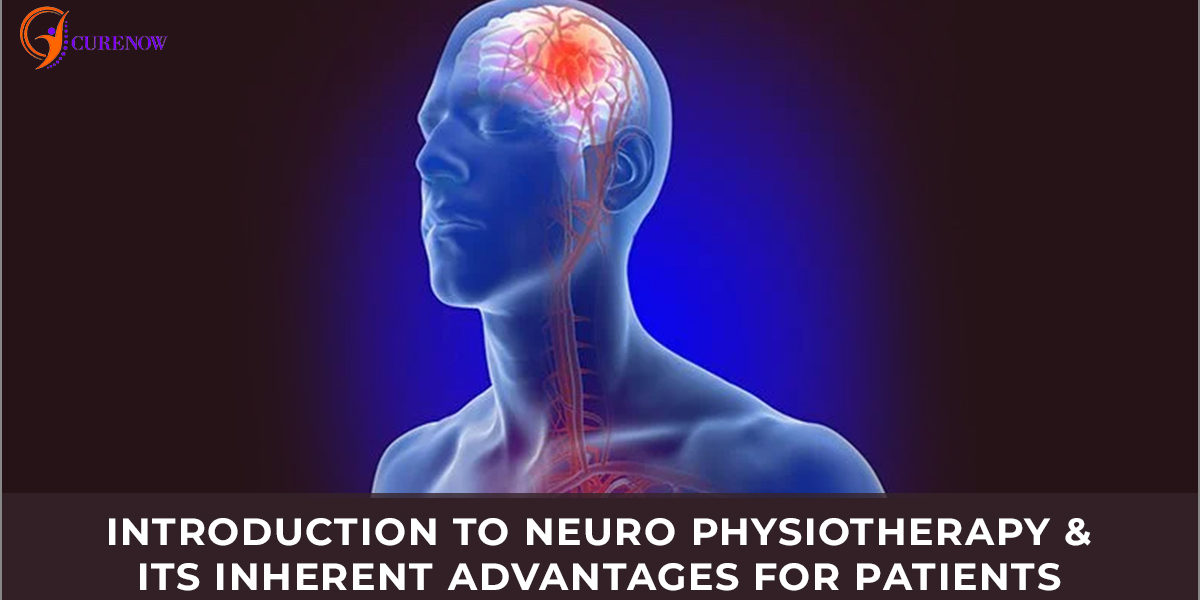
- 13 Jan 2022
- |
- By Admin
Introduction To Neuro Physiotherapy & Its Inherent Advantages For Patients
For patients who are impacted by any injury, disability, or illness, their motor functions are disrupted, along with regular movements of joints, muscles, and tendons.
In such cases, Physiotherapy can help them to heal, and recover faster.
In Neuro Physiotherapy, patients with neurological conditions are treated, and their condition of physical impairment is improved by keeping their joints flexible and muscles active.
In this blog, we will understand more about Neuro Physiotherapy, and how it can benefit the patients.
Conditions Where Neuro Physiotherapy Can Be Used
Neuro Physiotherapy is deployed where patients have any neurological conditions such as:
Bell’s palsy
Traumatic brain injury such as Head Injury
Spinal cord injury
Stroke
Parkinson’s disease
Multiple sclerosis (MS)
Due to these neurological conditions, the patient may experience a lack of sensation, tremor, paralysis, or motor deficits. This happens when there is damage to the central nervous system, and there is a breakdown of the pathways that carry different nerve signals from the organs to the muscles and vice versa.
Based on the existing condition of the patient, lack of movement and functions, and the severity of the issue, appropriate neuro physiotherapy is recommended to improve the existing conditions and to enable the patient to carry on with their day-to-day activities with ease.
How Does Neuro Physiotherapy Work?
The core objective and intention of neuro physiotherapy are to rehabilitate the patients, who are suffering from the above-mentioned conditions, and make them self-reliant and independent.
For example, is the patient finding it tough to walk without any support? Or are there minor inconveniences of fine movements in arms or legs that need treatment?
Based on the condition of the patient, appropriate neuro physiotherapy is recommended, and this can improve the patient’s condition.
Now, the question is how does neuro physiotherapy work?
And the answer is neuroplasticity, which is a phenomenon wherein the brain is able to form new connections (lose them), based on the signals it receives.
Unlike traditional physiotherapy that focuses extensively on body movements and body functions, neuro physiotherapy uses the phenomenon of neuroplasticity to help the brain form new synaptic connections.
In layman's terms, the brain of the patient is rewired to enable them to learn new skills and functions such as walking.
Types Of Neuro Physiotherapy
In severe cases, neuro physiotherapy can be used to help the patient relearn walking, sitting, or standing.
In less severe cases, it can also be used to improve the body posture, which prevents any injuries or pain.
Besides building strength and coordination, neuro physiotherapists can suggest limb positioning or splints to accelerate joint recovery
Mobility aids such as walking frames and motorized wheelchairs can be also deployed as part of neuro physiotherapy to improve motor functions.
At CureNow Wellness, we have UK-trained and certified Physiotherapists who will correctly diagnose the prevalent neurological conditions of the patient and suggest the best exercises, aids, and tools to improve body functions, mobility, and posture.
Our address: CureNow Wellness Pvt. Ltd.
F-Residences, Shop # 25, First Floor, Wadgaon Sheri, Kalyani Nagar Annexe, Pune - 411014, Maharashtra.
Contact : +91 9545345300

- 23 Dec 2021
- |
- By Admin
This Is How Physiotherapy Will Help In Sports Injury Recovery
Injuries that occur while indulging in any sports-related activities are termed as sports injuries, and if not treated on time, they can restrict the patient’s normal movements and flexibility, leading to disruption in performing day-to-day activities.
Reasons for sports injuries can be several; most common being overtraining or lack of conditioning, incorrect posture or technique, or simply an unavoidable accident.
Some common types of sports injuries are ACL tear in the knees (Anterior cruciate ligament (ACL) ruptures); Rotator cuff injuries; frozen shoulders; stress fractures; pulled hamstrings or chronic injuries.
In this blog, we will share how guided and expert physiotherapy can help in swift recovery from sports injuries, and how physiotherapy can help the patients to regain their strength and flexibility.
This Is How Physiotherapy Can Help In Sports Injury Recovery
Our UK-trained and certified Physiotherapists have extensive knowledge and experience of treating sports injuries and can offer the best diagnosis and treatment schedule for ensuring swift recovery.
With our sports physiotherapy, we help in the following ways:
- Healing of tissues will accelerate with breaking down of scar tissues
- Range of movement will improve, with stretching muscles and ligaments
- Muscle spasm or stiffness can be removed
- Lubrication and nourishment of the injured /affected joints for fast recovery
- All forms of chemicals are removed from the impacted region, which causes pain
- Weakened muscles are made stronger with regular and systematic exercises
Physiotherapy In Sports Injury Cases: Primary Advantages
In our extensive experience, we have observed that in most of the cases, proper and systematic physiotherapy leads to amazing results, which not only delights our patients but also surprises them.
Here are the advantages of physiotherapy in case of sports injuries:
- Full body functions and movements are restored as soon as possible, depending on the will and determination of the patient
- Patients can return to playing their favorite sports
- Muscle groups that are weakened can be strengthened for improved performance
- Sports physiotherapy can help in reducing pain and inflammation
- Ensuring top-class cardiovascular fitness, even if the patient stops playing sports
- Mitigating risks and preventing future injuries
- Enhanced flexibility and coordination
- Guidance on correct postures, right shoe size, and the right exercises for ensuring that the injuries are not repeated
Physiotherapy Treatment For Sport Injuries
Physiotherapy in sports injuries includes mobilisation, strengthening exercises, pain relief techniques, enhancing functional skills, and more, depending on the cause and severity of the injury.
Kinesiology Taping For Sports Injuries
When it comes to treating sports injuries, Kinesiology taping is one of the most efficient treatments that has shown us amazing results. In this treatment, special tapes known as Kinesiotape are placed in specific directions on the body, for supporting joints, muscles, and tendons, and enabling better mobility and movement for the patient.
These special tapes are able to harness the interface between skin and the muscles, thereby providing a long-lasting positive impact for the patient for treating sports injuries.
In case you need correct guidance and consultation related to the treatment of sports injuries, and preventing such injuries among sportspersons and physically active sportspersons, then CureNow Wellness has the solution you are seeking.
Our address: CureNow Wellness Pvt. Ltd.
F-Residences, Shop # 25, First Floor, Wadgaon Sheri, Kalyani Nagar Annexe, Pune - 411014, Maharashtra. Contact : +91 9545345300

- 09 Dec 2021
- |
- By Admin
Find Out How Physiotherapy Can Help With Recovery - 5 Signs You May Need Physiotherapy
Physiotherapy is one of the most critical allied health sciences that assist patients to recover faster and carry on with their normal day-to-day activities with ease. For those patients who are impacted by pain, injury, illness, or disability, physiotherapy is the best way forward to start the healing process and help them to become independent in mobility and movements.
In this blog, we will share the symptoms and signs that strongly suggest the need for physiotherapy and we will highlight how physiotherapy can help patients with recovery.
5 Signs You Need Physiotherapy
●Recurring Pain: If you are facing recurring pain in any body part, especially hands, arms, legs, ankles, back, shoulders, or neck, then yes, you definitely need assistance from a physiotherapist.
●Imbalance: If you are facing issues with maintaining balance while walking, then it’s a very strong sign of the need for a physiotherapist for correct treatment.
●Pain while sitting on a chair: While sitting on a chair, and working, if you are feeling pain such as headache or backache, then it means that physiotherapy is required for timely treatment to stop aggravating the situation.
●Limited mobility and flexibility: If you are feeling a consistent decrease in mobility and flexibility, then this is a very strong sign that you need physiotherapy.
●Sports Injuries: Any form of sports injuries, if not treated, can lead to severe issues. To stop this, physiotherapy is the way forward.
How Physiotherapy Can Help In Recovery
Now, let’s find out some major ways how physiotherapy can assist in the patient’s recovery from various health issues:
Pain Relief
This is considered as one of the biggest reasons why physiotherapy is recommended and suggested for recovery. Pains and aches resulting from injuries or surgeries, or any chronic disorder can be mitigated, reduced, and eventually stopped by regular physiotherapy.
Avoiding major surgeries
Surgeries are crucial in extreme cases, such as critical injury or accident or a genetic disorder. However, as observed, there are several instances when surgeries can be avoided or prevented with proper and focussed physiotherapy, and it can save the patient from a lot of hassles. For proper guidance, it’s very important to consult with the right physiotherapist, having extensive experience in handling such cases. Our UK-certified physiotherapists at CureNow Wellness can assist you in this regard.
Avoiding dependency on medicines
Medicines, especially painkillers can offer instant relief, but in the long term, they can induce severe complications, and reduce the natural resistance that our bodies exhibit against diseases. With regular and focussed physiotherapy, this dependency on medicines, especially painkillers can be reduced gradually.
Age-Related Issues
With age, a human body’s joints and muscles become weak, and this leads to weakness, injuries, and reduced movement and flexibility. These age-related issues can be managed with physiotherapy, and help the aged person to enhance their body movements, improve flexibility and coordination to a larger degree.
Consult with our UK-certified Physiotherapists at CureNow Wellness, and find out more about the benefits of Physiotherapy, and how it can help the patients to heal faster.
Our address: CureNow Wellness Pvt. Ltd.
F-Residences, Shop # 25, First Floor, Wadgaon Sheri, Kalyani Nagar Annexe, Pune - 411014, Maharashtra. Contact : +91 9545345300

- 26 Nov 2021
- |
- By Admin
Role of Physiotherapy in Pre and Post Orthopedic Surgery
There are several reasons for Orthopedic surgery: fractures, broken bones, muscle injury, dislocation, tendon tears or ruptures, and more. In sports injuries or accidents, an orthopedic surgery can be recommended in extreme cases as well.
For seamless and fast recovery of patients undergoing orthopedic surgery, it’s recommended to have regular Physiotherapy, since it has numerous benefits for patients.
In this article, we will share the role and importance of Physiotherapy in pre and post orthopedic surgery cases, and share how we at CureNow Wellness Physiotherapy can assist patients in this regard.
Role Of Physiotherapy In Pre & Post Orthopedic Surgery
Bringing Back Mobility, Strength & Confidence
Once an orthopedic surgery is completed, the affected areas (for example due to fracture, or dislocation) become weak and the strength is lost.
With regular and dedicated Physiotherapy, the patient can be empowered to get their mobility back and to increase their muscle strength gradually.
But how?
With guided Physiotherapy by experts from CureNow, the patient won’t be forming any blood clots in the impacted areas, and this ensures seamless blood flow for quick recovery.
Besides, with consistent Physiotherapy done by the patients, the weakened tissues and muscles get their strength back, which enables the patient to regain confidence and mobility, and they are able to perform their day-to-day activities with ease.
Systematic Pain Management
Since pain is both subjective and objective experience, Physiotherapy is recommended by Doctors for effective pain management post orthopedic surgery.
In fact, 45% of American patients demand a systematic pain management process to handle the chronic pain post-surgery, and Physiotherapy can prove to be a boon in such cases.
For both a speedy recovery and systematic rehabilitation of the patient, Physiotherapy is often the only way out. With regular and guided Physiotherapy, patients can not only reduce the pain experience but also regain strength, range of motion and have stronger muscles, that pave the path for a faster recovery.
At the same time, if proper Physiotherapy is not conducted after Orthopedic surgery, then the patient can experience muscle weakness, joint stiffness, contracture, which delays their recovery.
Physiotherapy Is Recommended After Which Ortho Surgeries?
After these orthopedic surgeries, Physiotherapy is generally recommended by the Orthopedists:
- Meniscectomies (when the entire torn meniscus or a part of it is removed, which is a typical knee joint.)
- Hip or Knee joint replacements
- Spinal surgery
- Ankle, elbow or knee reconstruction
- Shoulder replacement
- Laminectomies (when lamina, the back part of a vertebra is surgically removed)
- Rotator cuff repairs
- Physiotherapy Treatments For Pre & Post Orthopedic Surgery
Some of the most common and beneficial Physiotherapy exercises that are recommended for both pre and post orthopedic surgery:
Strengthening exercise to help muscles and tissues regain their strength
Mobility exercises to make the patient flexible and able to perform day to day activities
Electric stimulation and laser treatment to focus on the area of the impact
For more information on the role and importance of Physiotherapy post and pre Orthopedic surgery, please book an appointment with us at CureNow Wellness, where our UK-trained and certified Physiotherapists will suggest the best way forward.
Our address: CureNow Wellness Pvt. Ltd.
F-Residences, Shop # 25, First Floor, Wadgaon Sheri, Kalyani Nagar Annexe, Pune - 411014, Maharashtra. Contact : +91 9545345300

- 10 Nov 2021
- |
- By Admin
4 Inherent Benefits Of Cardio-Respiratory Physiotherapy
Cardiorespiratory is the medical science of issues related to the lungs and heart. Some of the common cardiorespiratory diseases include Chronic bronchitis, Chronic obstructive pulmonary disease (COPD), Congestive heart failure, and Emphysema.
With regular and guided Physiotherapy, patients of these and other cardiorespiratory diseases can recover faster, and with more rigor and intensity.
In this article, we will share 4 inherent and very relevant benefits of Physiotherapy in Cardiorespiratory diseases and subsequent recovery.
Lung Capacity Enhanced & Improved
The biggest and most critical advantage of Physiotherapy in Cardiorespiratory is improving the functioning of lungs, and enhancing the lung’s capacity, which happens because of improved blood circulation.
There are specialized breathing exercises that enable improvement in lung capacity for cardiorespiratory patients.
Avoiding Lung Collapse
After some medical procedures such as general anesthetic during the treatment of cardiorespiratory diseases, excessive secretions can build up in the lungs, which can lead to lung collapse and difficulty in breathing.
Since lungs are overloaded with such secretions, the organs get insufficient oxygen, which leads to more complications.
With regular Physiotherapy, such secretions can be removed, and the patient will have to make less effort to breathe and progress fast on the recovery path.
Removing Mechanical Ventilation
For cardiorespiratory patients dependent on mechanical ventilation for getting oxygen, Physiotherapy can prove to be extremely beneficial.
With proper Physiotherapy exercises and breathing exercises, the patient’s lungs capacity is improved, and this leads to removal of the ventilation swiftly.
Physical Exercises Minimizes Cardiorespiratory Risks
If a person is physically fit and healthy, then it automatically minimizes the risks associated with cardiorespiratory conditions and is considered a powerful proactive strategy to mitigate risks.
By regular Physiotherapy, any person prone to cardiorespiratory diseases due to any genetic factor or work conditions can make their lungs and heart stronger, and thereby avoid any cardiorespiratory-related diseases.
Some Common Cardiorespiratory Physiotherapy Exercises
Some of the most common physiotherapy exercises recommended for cardiorespiratory diseases include:
- Deep breathing exercises
- Breathing Facilitation Exercises
- Hands-on exercises
- Percussions and Vibrations
- Coughing and breathing exercises
- Breathing and circulation exercises
- Mobility Assistance
- Mobility Aids
The exact Physiotherapy exercises to be administered depend on various conditions such as the severity of the issue, the patient’s current status, present lung capacity, how far the patient’s day-to-day activities are impacted, and more.
It’s recommended that the patient is consulted by a professional Physiotherapist, who will properly examine the patient and depending on the condition, will suggest the best way forward.
If you are searching for top physiotherapists who are experts in cardiorespiratory conditions, then we at CureNow Wellness can help you right away.
We have decades of experience in Physiotherapy, and our UK-trained and certified Physiotherapists have the required expertise to provide top-rated Physiotherapy care and consultancy for cardiorespiratory conditions.
To consult with our trained Physiotherapists, please book an appointment here or visit us at our state-of-the-art Physiotherapy clinic.
Our address: CureNow Wellness Pvt. Ltd.
F-Residences, Shop # 25, First Floor, Wadgaon Sheri, Kalyani Nagar Annexe, Pune - 411014, Maharashtra. Contact : +91 9545345300

- 12 Oct 2021
- |
- By Admin
What Is Frozen Shoulder? Can Physiotherapy Assist In Frozen Shoulder Treatment?
Frozen Shoulder: Definition
Often you must have felt an acute, stinging pain originating from the shoulder joints, that makes body movement, especially arms and back difficult.
This is called frozen shoulder, whose technical name is adhesive capsulitis.
Common symptoms of frozen shoulder are stiffness and pain at the shoulder joints, and in the first stage of this condition, any movement related to the shoulder causes pain. The first stage, called the freezing stage, makes the range of motion limited, and painful. This stage often lasts for 6-9 weeks, and the condition is most severe in this stage.
The second stage of frozen shoulder, lasting for 4-6 weeks is known as the frozen stage, makes the shoulder stiffer, thereby making normal body movements tougher. However, the pain diminishes in this stage, but the shoulder muscles become weak.
In the third stage, called the thawing stage, the pain further diminishes, and the stiffness reduces, thereby increasing the range of motion. This stage lasts for 6 months to 2 years.
But the pain can worsen at night, often disrupting sleep as well.
What Causes Frozen Shoulder?
In a human body, the bones, ligaments, and tissues of the shoulder are encased in a capsule of connective tissues. When this capsule thickens and tightens around the shoulder, then that condition causes a frozen shoulder.
Primary symptoms are limited range of motion and consistent pain.
As per some medical journals, frozen shoulder is more common in those patients who are diabetic, and/or suffering from diseases such as Tuberculosis, Parkinson's disease, hyperthyroidism, and Cardiovascular diseases.
Prolonged immobility or reduced mobility due to various factors such as surgery or illness can also cause frozen shoulders.
Frozen Shoulder Treatment
Among non-surgical treatments for frozen shoulders, physiotherapy is considered one of the most reliable, and popular treatments.
The objective of physiotherapy for frozen shoulders is to increase the range of motions for the patient and enable them to carry on their day-to-day activities with ease.
Under physical therapy for frozen shoulders, stretching exercises are usually recommended for the patients, based on the diagnosis and severity of the condition.
Some of the beneficial stretching exercises for frozen shoulders include:
Pendulum Stretch, Towel Stretch, Finger Walk, Cross-Body reach, armpit stretch, Outward rotation, and inward rotation.
After regular stretching exercises, the stiffness associated with the frozen shoulders reduces, and the patient’s normal range of motion is restored as the shoulder muscles regain their original strength.
In extreme cases, steroid injections are also administered to reduce inflammation, which reduces pain and stiffness.
Under surgical treatment, Shoulder arthroscopy is the most common procedure, wherein the abnormal adhesive tissue in the shoulder joint capsule is operated upon.
Specialized Treatment For Frozen Shoulders At CureNow
We at CureNow offer advanced Electrotherapy treatment for frozen shoulders.
We have the latest digimed 301 IFT VECTOR 90 frozen shoulder program along with topical Ultrasound which helps in reducing adhesions and helps in early mobility of shoulder joints.
If you are seeking professional, and result-oriented physiotherapy for frozen shoulders, then we at CureNow Wellness Physiotherapy can provide you guidance and assistance.
Our UK-certified Physiotherapists are trained in treating frozen shoulders and provide relief to the patient in a gradual, non-surgical treatment procedure.
Our address: CureNow Wellness Pvt. Ltd.
F-Residences, Shop # 25, First Floor, Wadgaon Sheri, Kalyani Nagar Annexe, Pune - 411014, Maharashtra. Contact : +91 9545345300

- 15 Sep 2021
- |
- By Admin
Physiotherapy Treatment For Facial Palsy / Bell’s Palsy.
What exactly is Facial Palsy or Bell’s Palsy? What are the symptoms of this condition? Can Physiotherapy help in treating Facial Palsy?
Bell’s Palsy has been named after 19th-century Scottish surgeon Sir Charles Bell, who discovered the root cause of this condition: Severing of 7th cranial nerve.
In this blog, we will discuss more about Facial Palsy/Bell’s Palsy, and find out if physician exercises can help patients recover.
Definition Of Facial Palsy and Bell’s Palsy
Facial Palsy is a neurological condition, often described as a type of Facial Paralysis, wherein the patient is not able to control the facial muscles of the impacted side of the face.
Bell’s Palsy is a special type of Facial Palsy, wherein the exact cause of the facial paralysis is not known, initially.
Causes Of Facial Palsy
There can be several causes of Facial Palsy, that includes (but are not limited to): sudden compression of facial nerves, viruses such as herpes and influenza, respiratory tract infections, weak immune systems, and consistent stress.
With Bell’s Palsy condition, the patient and doctors are not able to correctly find out the reason for this condition, and this can cause further damage since proper medication and exercises cannot be started.
In such conditions, it’s always recommended to stop all sorts of stressful activities with immediate effect, and take plenty of rest.
Symptoms Of Facial Palsy
●Facial paralysis, wherein the patient is not able to control a part of the face (normally one-half), along with the drooping of that side of the face
●Sharp, intense pain in the inner side of the ears (the side which is impacted)
●Loss of senses such as taste and sometimes smell
●Irritation on listening to loud noise
●Becomes difficult to eat, since the patient loses control over lips and cheeks on one side of the face
●Becomes difficult to speak, especially letters such as B and P
●Running nose from the side of the face which is impacted, since the patient loses the control
Physiotherapy For Facial Palsy
Facial and Physical Therapy, along with consultations from speech and language therapists can help the patients of Facial Palsy to manage this condition, and gradually carry on their day-to-day activities with comfort.
Some of the exercises & treatment methodologies that are recommended by Physiotherapists, based on the condition and symptoms of Facial Palsy are:
●Facial stimulation
●Nose and Cheek exercises
●Mouth Exercises
●Eye Exercises
●Muscle Re-education exercises
●Soft-tissue techniques
●Heat packs
The core objective of Physiotherapy and Facial Therapy is to strengthen the facial muscles, and optimally stimulate facial nerves at the impacted area.
You can consult with CureNow Wellness Physiotherapy for more information about physiotherapy-based treatment for Facial Palsy and Bell’s Palsy condition. Our UK-trained and certified Physiotherapists can assist patients with this facial paralysis condition, and help them to recover faster.
F-Residences, Shop # 25, First Floor, Wadgaon Sheri, Kalyani Nagar Annexe, Pune - 411014, Maharashtra. Contact : +91 9545345300

- 08 Sep 2021
- |
- By Admin
Physiotherapy for Cervical Spondylosis (Symptoms, Exercises and Treatment)
Cervical spondylosis is one of the most common mobility-related issues among patients who are aged above 60. Infact, as per a study, it was found that nearly 85% of people above 60 years are right now living with cervical spondylosis, but in most cases, they are not able to experience the pain.
If not diagnosed early, this condition can severely impact the mobility of the patients, besides incurring pain and numbness.
Fortunately, Physiotherapy has the solution for this condition.
Definition of Cervical Spondylosis
A medical condition wherein discs, ligaments in the neck, and/or cervical spine and vertebrae deteriorate gradually, is known as Cervical Spondylosis.
This condition is also known as degenerative osteoarthritis and cervical osteoarthritis. In layman terms, this condition is often called “arthritis of the neck”.
Causes Of Cervical Spondylosis
Over time, the cervical spine experiences gradual wear and tear, and in some cases, severe degeneration. This is normally one of the most common causes of Cervical Spondylosis. In some cases, previous injuries to the neck (accident, or while doing exercises) can also lead to this condition.
Now, cervical spice is referred to as the seven small vertebrae that start from the base of the neck and basically give structure and shape to our neck. In the condition of Cervical Spondylosis, the edges of the vertebrae develop sudden bone spurs known as osteophytes, due to which the discs get thinner, and they gradually lose the ability to absorb the shock experienced in the neck.
Symptoms Of Cervical Spondylosis
The most common symptoms are weakness and severe pain in the neck, which often leads to loss of consciousness in the patient. The patient is not able to move, and mobility functions are severely hampered.
Let’s understand why this happens.
The swollen neck joints, also called facet joints, press and pinch the nerve roots, or in some cases, the spinal cord which results in pin and needles type pinching pain, and/or tingling sensation.
Due to these issues, the patient first loses their ability to freely move their neck, and then gradually mobility functions are disrupted and in extreme cases, the patient is not able to freely walk, without any support.
Exercises & Treatment For Cervical Spondylosis
Physiotherapy is considered one of the most preferred and result-oriented treatments for cervical spondylosis that has long-term benefits. For immediate relief, exercises can be performed, besides giving muscle relaxants & steroid injections.
With regular exercises based on the diagnosis and the symptoms, the patient can experience relief from the pain and numbness, and can gradually restore day-to-day activities and mobility functions.
In severe cases of Cervical Spondylosis, surgery is recommended by the doctors.
Some of the exercises for patients with Cervical Spondylosis include:
●Neck Exercises such as neck stretch, neck tilt, neck retraction, and neck turn (with guidance from Physiotherapists)
●Spine stretch in reclining mode
●Chair rise exercises such as seated leg raise, focussing on abdominal muscles can help
●Shoulder blade exercises
Advanced Treatment By CureNow Wellness
If you are looking for advanced Physiotherapy based treatment for Cervical Spondylosis, then CureNow Wellness Physiotherapy can help you with digital cervical traction and digimed IFT treatments.
In cervical traction treatment (for which we have highly advanced digital machines), the spinal vertebrae and muscles are stretched to provide pain relief for the patient. Once space is created between vertebrae, then pressure is released, muscles are relaxed, thereby providing instant pain relief to the patient.
Whereas, DigiMed is an advanced IFT (Interferential Therapy) equipment, which is part of electrotherapy-based physiotherapy treatment for Cervical spondylosis. With sophisticated and advanced features to control the flow of current, and automate the treatment process, DigiMed IFT treatment can work wonders for patients.
Consult with our UK-certified Physiotherapists, who are trained to diagnose Cervical Spondylosis, and based on the symptoms, they will prepare a detailed physical therapy program for helping the patients.
F-Residences, Shop # 25, First Floor, Wadgaon Sheri, Kalyani Nagar Annexe, Pune - 411014, Maharashtra. Contact : +91 9545345300

- 17 Aug 2021
- |
- By Admin
Physiotherapy for Neurological Problems – Stroke, Multiple Sclerosis, and Parkinson’s Disease
For patients with neurological conditions such as stroke, multiple sclerosis, and Parkinson’s disease, physiotherapy has several inherent advantages in treatment and minimizing the impact. With proper and timely physiotherapy, patients with neurological conditions witness gradual improvement and help the patient to lead a normal life.
In this blog, we will discuss some common causes for such neurological conditions and physiotherapy treatments, along with the effect of dopamine in neurological conditions.
Causes Of Stroke, Multiple Sclerosis and Parkinson’s Disease
In Neurological conditions, the patient’s movement and mobility are impacted, along with functional disorders, due to impairments impacting the nervous system, spinal cord, and brain.
Some of the common conditions related to neurological problems include Stroke, Multiple Sclerosis, and Parkinson’s Disease.
The main cause of Stroke is when the brain suddenly stops receiving the supply of blood, which prevents the brain tissues from getting oxygen and nutrients. Within minutes, brain cells start to die, and it’s an emergency situation for the patient.
In the case of Multiple Sclerosis or MS, the main cause is a communication breakdown between the brain and the rest of the patient’s body. This communication problem is triggered when the immune system, by mistake, attacks myelin which is the protective sheath covering the nerve fibers. MS can lead to immobility and loss of movement.
The cause of Parkinson’s Disease is gradual and progressive nervous system disorder, and it directly affects the movement of the patient. It starts with normal tremors and graduates into intense and massive tremors, which leads to stiffness of limbs, and slowing of movement. In severe cases, the patient experiences impaired balance and posture as well.
Impact Of Dopamine On Neurological Disorders
Dopamine is a chemical, which is medically known as a neurotransmitter, that sends signals to the brain from different parts of the body.
A right balance of dopamine is essential for the well-being of the human body: Both mentally and physically. Dopamine impacts the movement of the body, along with emotional responses. Critical brain functions such as sleep, learning, mood, concentration, memory, learning, motor control, and more are directly impacted by the level of dopamine in the human body.
Lack of dopamine, in fact, can lead to depression and Parkinson’s Disease.
Physiotherapy Treatment For Stroke, Multiple Sclerosis and Parkinson’s Disease
For most neurological conditions including Stroke, Multiple Sclerosis, and Parkinson’s Disease, there are some physiotherapy-based treatments, that can assist the patient to recover faster, and lead the normal day-to-day life.
The physiotherapy exercises are targeted and focused to stimulate the nervous system and improve muscle strength, movement, coordination, and balance. As a direct result of the exercises, the patient is able to gradually recover loss of motion, strengthen muscles, increase balance and stamina.
Some of the common exercises which are suggested for neurological conditions such as Stroke, Multiple Sclerosis, and Parkinson’s Disease:
Mobilization
Positioning and Splinting
Active and passive limb exercises
Breathing exercises
Bed exercises
Strengthening and Endurance exercises
Our UK-trained and certified Physiotherapists at CureNow Wellness Physiotherapy can diagnose the neurological condition impacting the patients, and suggest the best physiotherapy-based treatment for minimizing the impact and help the patient recover faster.
Consult with our expert Physiotherapists at CureNow Wellness Pvt. Ltd., F-Residences, Shop # 25, First Floor, Wadgaon Sheri, Kalyani Nagar Annexe, Pune - 411014, Maharashtra, or visit our website.
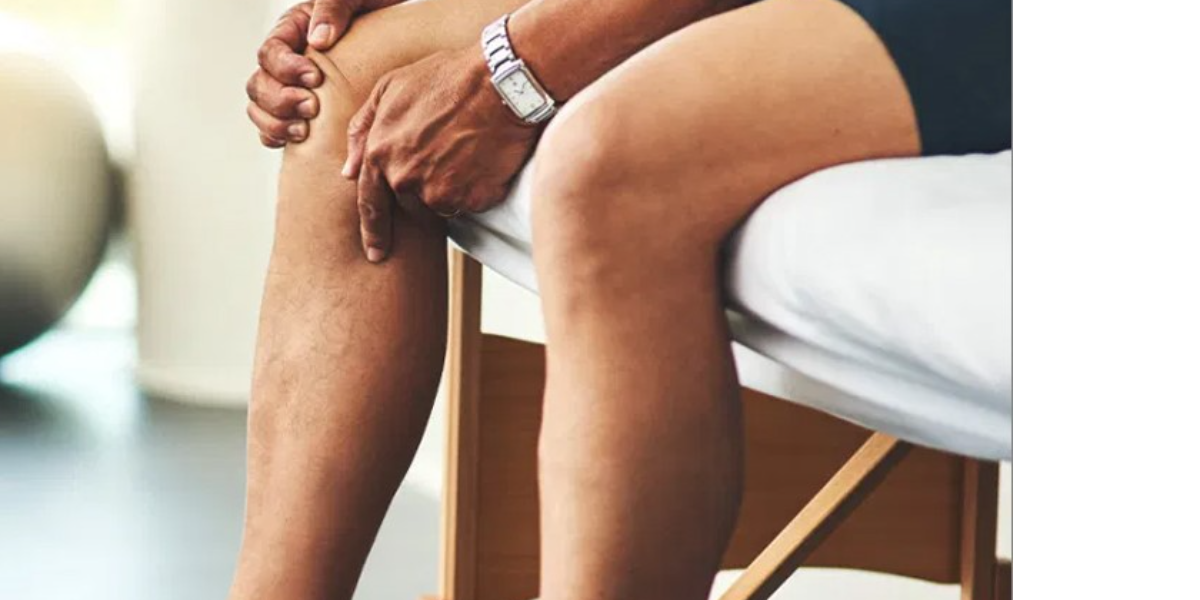
- 10 Aug 2021
- |
- By Admin
Why Joints Pain During Cold & Rainy Season? How To Reduce This Pain?
Remember grandma complaining about pain in the knees and legs during the rainy season and cold weather? Have you ever wondered why this happens? And more importantly, how to reduce and manage this pain?
In this blog, we will discuss this critical health issue, and provide a seamless solution as well.
Why Joints Pain During Monsoon?
There are several types of research and studies done on the aspect of joints, muscle, and ligament pain during monsoon, and there is strong evidence that suggests there is a strong relationship between joint pain and weather.
For instance, as per some studies, it has been found that changes in barometric pressure have a strong bearing on sudden joint pain during monsoon. Due to changes in the atmospheric pressure, the muscles, tendons, and scar tissues expand and contract, which results in joint pain, especially for arthritis patients.
Besides, low temperature and high humidity can make the fluids inside the joints thicker, which directly results in joint pain.
Another theory by researchers states that if the cartilages that cushion the bones within a joint are worn off, then the nerves in the exposed bones can be triggered during the rainy season, which can result in joint pain.
Moreover, during the rainy season, when it’s pouring outside, physical movements tend to reduce, thereby making the inactive joints stiff and thus, painful.
Hypothyroidism, a condition wherein the thyroid doesn’t create enough thyroid hormones to release into the bloodstream, has also an effect on joint pain, especially during monsoon. Common effects can be muscle stiffness, aches, tenderness, and stiffness, especially in the shoulders and hips.
Now, more research is being conducted to find the relation between Hypothyroidism and the rainy season, and more details are awaited.
How To Reduce Joint Pain During Rainy Season?
A quickfire solution can be Warmth. Keep your body, and especially your joints warm by taking a warm water bath or wearing warm clothes.
However, Exercises and enhanced physical activity is the primary, long term solution, and in this regard, Physiotherapy is the way forward.
Experienced and seasoned Physiotherapists from CureNow Wellness Physiotherapy can accurately diagnose such conditions of joint pain during the rainy season, and create an in-depth blueprint of physical exercises such as stretching and mobilization to manage and reduce seasonal joint pain.
CureNow Wellness Physiotherapy has UK-certified and trained Physiotherapists, having years of experience in optimally managing such joint pain during winter and rainy seasons. We have the capability and expertise to not only suggest the best, most result-oriented physical exercises for such joint pain, but also help the patients to do these exercises: first with the assistance of the Physiotherapists, and then gradually on their own.
We have witnessed massive transformation and impact due to the correct physiotherapy for the patients, having long-term benefits.
Consult with us at CureNow Wellness Pvt. Ltd. F-Residences, Shop # 25, First Floor, Wadgaon Sheri, Kalyani Nagar Annexe, Pune - 411014, Maharashtra.

- 28 Jul 2021
- |
- By Admin
Find Out How Orthopedic Physiotherapy Can Help You
In case a patient is recovering from a surgery, or any accident, illness and injury, then Physiotherapy can prove to be extremely beneficial.
With timely and focused Orthopedic Physiotherapy, patients can recover faster from any issues related with the musculoskeletal system, and carry on with their day to day activities with ease.
What’s Orthopedic Physiotherapy?
Orthopedic Physiotherapy is used to treat issues related with the musculoskeletal system, that includes: bones, ligaments, joints, muscles, tendons and connective tissue.
Our team at CureNow Wellness Physiotherapy have Physiotherapists specializing in Orthopedics, who can:
-Create an exhaustive and detailed treatment plan, based on the diagnostics and condition of the patient.
-Determine the proper and feasible movement diagnosis
-Plan optimal and scheduled therapeutic care
-Share information and details on how to avoid further injuries and discuss rehabilitation plan
Conditions Which Are Treated Under Orthopedic Physiotherapy
Some of the common musculoskeletal conditions which can be treated by physiotherapists are:
spinal stenosis
Lymphedema
lower back pain
Bursitis
plantar fasciitis
Arthritis
knee instability
Stroke
muscular dystrophy
joint pain
Cancer
limited range of motion
Lyme disease
frozen shoulder
Parkinson’s disease
Scoliosis
Besides, there are some specific patient cases, wherein specialist Physiotherapists are required. For example, sports physiotherapists, who specialize in sports related injuries, and have extensive experience in treating sportspersons and athletes.
Physiotherapists for older patients, and infants/kids are other such examples.
Effective Physiotherapy Treatments For Orthopedic Patients
Based on our extensive experience, we have observed that these treatments are the most effective, based on the specific case and conditions:
Exercise Therapy
Under exercise therapy, the Physiotherapist will create a detailed plan for exercises, revolving around mobility, strengthening, and/or balance-building.
With gradual practice, the patient will be able to perform these exercises on their own, after the therapist assists the patient initially. It’s important for the patient to let the physiotherapist know which exercises are doable, and which one are causing discomfort and pain.
Traction
In conditions such as lower back pain, neck pain and degenerative disc conditions in the spine, traction can be applied for efficient results.
Via traction, the pressure on the compressed and damaged joints are taken off either using special equipment like a traction machine, or manually by the therapist.
Electrotherapy
Based on research & observation, it has been found that by administering electrotherapy via electric stimulation, the patient’s pain can be reduced gradually. However, it’s specific to cases and conditions.
In electrotherapy, electric stimulation is provided via e-stem device such as TENS (Transcutaneous electrical nerve stimulation) and NMES (Neuromuscular Electrical Stimulation)
In TENS, low voltage electric pulse is passed on the body area where the patient is experiencing pain, while in NMES, electric pulse is passed on to the impacted nerves.
TheraGun
TheraGun is a handheld device that is used to stimulate muscles and empower them to perform day to day activities without any obstacles. This handheld device vibrates at a high recurrence, with very tiny amplitude of movement.
Just two-three minutes of using TheraGun on impacted areas such as arms, glutes, legs can provide instant relief to the patient.
Cupping Therapy
Cupping Therapy, also known as hijama cupping, vacuum cupping and horn treatment is one of the oldest and traditional methods to release toxins from the body. The therapist puts specially designed cups on the impacted area and applies pressure to release the toxins.
Wish to know more about how physiotherapy can be used to treat orthopedic conditions? Consult with CureNow Wellness, that provides state of the art physiotherapy with amazing results.
Our team of seasoned Physiotherapists are trained and certified from the UK, that gives them more exposure and experience for treating the patients.

- 14 Jul 2021
- |
- By Admin
Overview Of Post Covid Physiotherapy Advice & Exercises
Some patients recovering from Covid-19 have been reported to have experienced multiple organ dysfunction, due to the severe acute respiratory syndrome.
One of the major implications of this is dysfunction of the respiratory system, and this needs extensive care and precautions while recovering in the post-Covid stage.
US National Library of Medicine and National Institutes of Health have recommended several post Covid Physiotherapy Advice and Exercises, for helping the patients recovering from coronavirus to get well faster.
Three of such Physiotherapy advice & suggestions are:
Conventional Chest Physiotherapy
As per the research, some patients with productive cough can benefit with conventional chest physiotherapy, since it can induce and stimulate coughing. With physiotherapy exercises such as bronchial hygiene maneuvers, patients recovering from covid-19 can benefit and their respiratory system can respond positively to the treatment.
However, there is no evidence or research as of now, that shows that patients in acute stage of the disease, especially with hypoxemic respiratory failure and dry cough can benefit from such physiotherapy treatment. (Reference)
Such patients should be constantly monitored for pulmonary disease.
Exercise & Early Mobilization
Patients recovering from Covid-19 should be encouraged and assisted to perform some lightweight and light intensity exercises, since it will help them to maintain some sort of mobility and functional capacity.
The reason this Physiotherapy advice is suggested: Patients recovering from Covid-19 can experience fatigue, fever, myalgia and other symptoms that drastically reduces their mobility, movements, muscle strength and body functionality Some of the patients can be asked to be prolonged quarantine, that further deteriorates their normal body functions.
With light exercises and gentle movements, the condition of such recovering patients can improve.
Prone Position
Recovering coronavirus patients with Acute respiratory distress syndrome (ARDS) are recommended to be given prone ventilation for 12-16 hours a day. Although prone ventilation is recommended by experts, it should be administered and give only by knowledgeable and experienced medical staff.
As per US National Library of Medicine, a satisfactory response for prone position among patients can be gauged by the improvement in PaO2/FiO2 ratio: An increase of 10 mmHg in PaO2 or an increase of 20 mmHg in the PaO2/FiO2 ratio is considered to be satisfactory.
In case PaO2/FiO2 ratio is less than 150 mmHg for 6 hours or more in the supine position, then prone positioning should be repeated, till 20% of PaO2/FiO2 is reduced (within 2 hours)
More details about Physiotherapy care for Covid-19 recovering patients can be found here: https://www.ncbi.nlm.nih.gov/pmc/articles/PMC7297520/
If you need Physiotherapy care and advice for Post-Covid recovering patients, then we at CureNOw can help you. Our UK-trained and certified Physiotherapists can suggest and administer the most optimal post-Covid exercises and treatment, based on the specific case and condition.
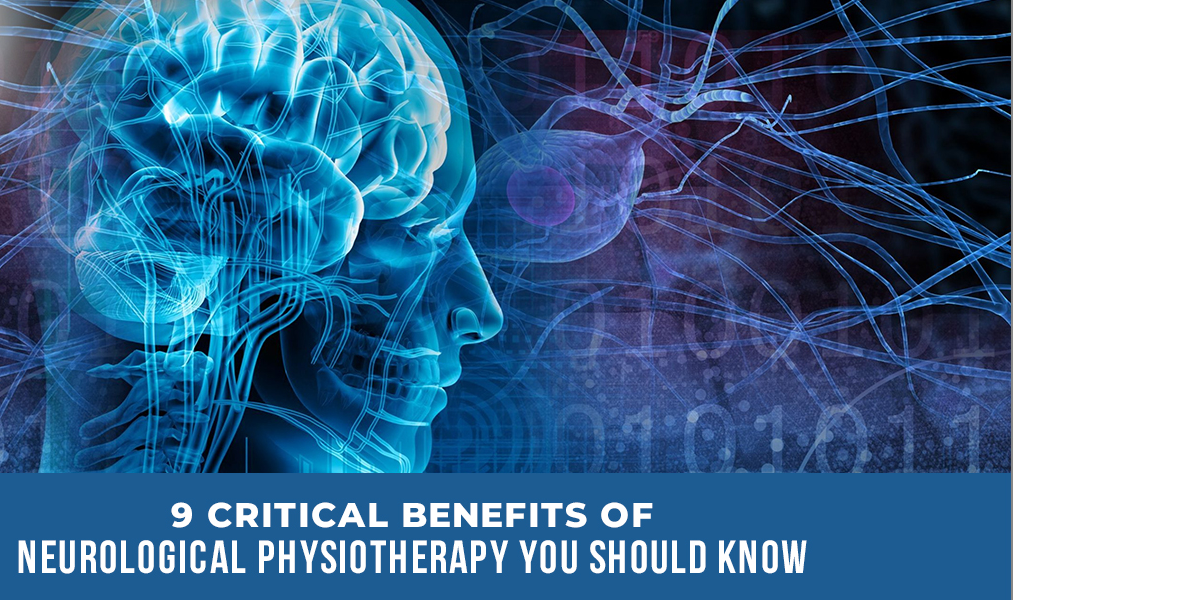
- 22 Apr 2021
- |
- By Admin
9 Critical Benefits Of Neurological Physiotherapy You Should Know
When a patient suffers from a problem related with the nervous system, then it’s known as neurological disorder, and it involves issues with the brain, peripheral nerves or spinal cord.
Physiotherapy can be used to minimize the pain, and initiate a healing process that may lead to full or partial recovery from the neurological condition.
Before we share the inherent advantages of physiotherapy when it comes to treating neurological conditions, let’s first have an overview of the symptoms related with neurological conditions, and some neurological conditions where physiotherapy is able to help.
Symptoms Of Neurological Conditions
Some of the common symptoms of neurological condition includes:
Paralysis
Poor coordination between body organs
Muscle weakness
Seizures
Loss of sensation in any body part
Altered levels of consciousness
Confusion
In some cases, memory loss
The exact neurological condition which has impacted the patient can be only determined via neurological examination, that is conducted in terms of behavior, cognition and/or memory.
Most Common Neurological Disorders
Some of the most commonly occurring neurological disorders are:
Alzheimer's Disease
Spinal cord injury
Bell’s Palsy
Brain tumors
Head injury
Severe headache
Lumbar Disk Disease (Herniated Disk)
Multiple Sclerosis
Brain stroke
Amyotrophic Lateral Sclerosis (ALS)
Epilepsy and Seizures
How Physiotherapy Can Help In Neurological Conditions?
When it comes to neurological conditions, then the patients find it difficult to coordinate normal body movements and actions. Mobility of the patient deteriorates, and it becomes tough to move from one point to another on their own.
Besides, muscle strength is weakened, depending on the severity of the neurological condition, and range of motions is restricted, and the balance of the entire body suffers.
Based on the symptoms and the condition of the neurological disorder, physiotherapy can be used to minimise the above mentioned challenges, and improve the quality of life of the patient.
A comprehensive rehabilitation process can be initiated, which will have a number of exercises and other physical therapies, which will ensure that further deterioration of the muscle strength and mobility slows down, and the patient is able to carry on with normal daily activities without any external help or assistance.
9 Critical Benefits Of Neurological Physiotherapy
Body movements of the patient is made easier, via goal-oriented physical therapies
Normal pattern of body motion can be restored, in a gradual manner
From zero mobility to aided-mobility to fully independent mobility can be achieved
Muscle strength can be increased gradually by ways of precise and goal oriented physical therapies
Entire range of movement can be gradually improved, and increased
In most of the cases, fine motor skills can be enhanced and improvised
Patient’s posture can be improved with physical exercises
Body balance can be optimized and improved
Both spasticity and contractures can be reduced and minimized
Besides these, some more direct benefits include:
Overall fitness level and endurance level of the patient is improved
Physiotherapy can also help to reduce chances of chest infections
Problems related to breathing can be reduced
Overall stress and anxiety of the patients is reduced
The patient is able to carry on day to day activities, independently
Overall, the neurological patient is able to achieve full potential
At CureNow Wellness Physiotherapy, we have UK-certified physiotherapists, who can diagnose the neurological condition of the patient, and accordingly suggest the best physiotherapy consultancy for the best results.

- 14 Apr 2021
- |
- By Admin
Back Pain? Find Out How Physiotherapy Can Help You To Heal With Proper Exercises
Due to a massive shift in our lifestyle and habits, back pain has emerged as one of the most common ailments among the urban population. As per a research done by Georgetown University, around 16 million American adults suffer from one or the other form of back pain, and the numbers are growing at an alarming scale.
In this article, we will share how physiotherapy can help in treating back pain. But before that, let’s understand the causes and symptoms of back pain.
Causes of Back Pain
Lower back pain is the most common type of back pain, and the main reasons are poor posture and lack of movement among the patients.
Since office and business work requires long hours in front of the computer or laptop, and almost everyone is hooked on to mobile phones these days, the cases of lower back pain are refusing to die down.
Fortunately, back pain caused by these factors can be treated successfully with regular and targeted physiotherapy, that we at CureNow Wellness Physiotherapy provides.
However, back pain can also be caused by some severe and extreme causes such as osteoporosis, arthritis, ankylosing spondylitis, disc prolapse and other reasons, for which a more detailed and advanced medical treatment is required.
Symptoms of Back pain
Some of the most common symptoms of back pain are:
Consistent pain in the buttocks, legs, feet, as if someone is pricking pins and needles
You can feel the pain moving down from your back to the legs and feet
Pain intensifies when you bend forward to pick any thing
Entire lower back region is always stiff and stubborn
When the back pain is extreme, then some symptoms are:
While walking or standing, you are unsteady
Passing or controlling bladder or/and bowel movement
Back pain leads to sudden weight loss or fever
How Physiotherapy Can Help In Back Pain?
Based on the correct diagnosis and observation of the symptoms, physiotherapy can be used to treat back pain conditions, and the results are very encouraging, especially in the case of lower back pain.
With proper and goal-oriented physiotherapy, the patient is able to improve body movements, range of motions and subsequently, back pain is gradually reduced. Moreover, physiotherapy leads to improvised and optimized joint and muscle movement, which is another important step towards treatment of back pain.
Four major physical therapies involved in the treatment of lower back pain includes:
Manual Therapy: This is a quick-fire and instant pain relief strategy, wherein the physiotherapist will provide manual (hands-on) physical therapy to reduce and remove stiffness, pain and improvise joint movement and muscles of the spine.
Movement Exercises: Strategies such as McKenzie method, neural tissue mobilization etc can be deployed to improve the range of motion of the patient, by movement exercises. The objective is to restore normal motion of the patient, and reduce radiating or referred pain in the lower back region.
Strengthening Exercises: This is the long-term strategy to reduce and remove lower back pain, by strengthening of the abdominal and spinal muscles. In this method, the deep muscles are re-trained to improve core stability and endurance of the patient, which leads to near-zero back pain in the longer run.
Electrotherapy: At CureNow Wellness, we also use electrotherapy for treating lower back pain issues, and this has given us some amazing results. In this, small currents are passed on to the electrodes, which send small electric pulses to the area where the patient is experiencing back pain.
For electrotherapy treatment for back pain, we are deploying Transcutaneous Electrical Nerve Stimulation (TENS) therapy and Interferential Therapy or (IFT), based on the severity of the problem. Besides, we are among the first to use Percussion Gun and Dry Cupping therapy, as part of electrotherapy treatment for lower back pain, and the results we are receiving is very encouraging.
In some cases, we also recommend ultrasound for the patient, wherein vibrations are used to send heat and energy to the impacted areas such as spinal muscles, ligaments, tendons and bones. This can also reduce pain, and kickstart healing with immediate results.
At CureNow Wellness Physiotherapy, we have UK-trained physiotherapists and consultants, who can suggest the best way forward to treat your back pain.

- 21 Mar 2021
- |
- By Admin
What Is The Role of Physiotherapy in Cardiopulmonary Conditions?
Overcome the physical and functional impairment, activity limitations, and participation
restrictions due to the impairments of structures and functions of the cardiovascular and pulmonary system.
Helpful in Asthma, chronic obstructive pulmonary diseases, coronary artery disease, heart failure.
Definition Of Cardiopulmonary Conditions
Cardiopulmonary conditions can be defined as a range of conditions that directly impact lungs and heart of a patient. Since both lungs and heart are closely interrelated, issues in one organ can spil over to the other. For example, if there are any issues with lungs, then the heart will need to work harder to extract the oxygen from the lungs, and take it to the blood.
Some of the most common cardiopulmonary diseases are:
Emphysema
Chronic bronchitis
Congestive heart failure
Chronic obstructive pulmonary disease (COPD)
Some symptoms associated with cardiopulmonary conditions are:
-Chest pain wich radiates to arms and jaws
-Shortness of breath
-Sudden sweating and wheezing
-Nausea and vomiting
-High blood pressure
Role of Physiotherapy In Cardiopulmonary Conditions
When it comes to treatment and rehabilitation of patients suffering from cardiopulmonary conditions, then physiotherapy has a very active role to play.
Cardiopulmonary Physiotherapy is an area of expertise, wherein physical therapies are deployed to not only prevent issues related with heart and lungs, but also rehabilitate and restore the patient’s health.
With physiotherapy, patients of cardiopulmonary conditions can:
-Overcome physical and functional impairment arising due to heart and lungs issues
-Overcome limitations pertaining to normal day to day activities
-Overcome restrictions arising due to impairment of cardiovascular and pulmonary system’s structures and functions
-Manage and recover from cardiopulmonary conditions such as asthma, heart failure, chronic obstructive pulmonary diseases, and other such conditions
-Reduce breathlessness
Physiotherapy Treatment For Cardiopulmonary Conditions
There are several exercises recommended for patients of cardiopulmonary conditions. Some of them are:
Breathing facilitation & deep breathing exercises
Deep breathing and breathing facilitation exercises along with the correct positioning assists the patient to get relief from dyspnea and breathlessness by a great extent. Exchange of gases also becomes possible, due to breathing exercises.
Diaphragmatic breathing along with pursed lips breathing are two of the most common breathing exercises under physical therapy.
Coughing exercises
Along with breathing exercises, coughing is also an effective physical therapy for cardiopulmonary conditions. The patients are taught and encouraged to cough in order to clear secretions. As a result of systematic coughing, the collapse of small airways can be minimized. Conditions such as bronchospasm and fatigue can also be minimized due to coughing.
Some other physical therapies include: Percussions and Vibrations, Mobility assistance.
Based on the specific condition of the patient, and the recovery schedule, cardiopulmonary physiotherapist will recommend the set of exercises which are suitable and beneficial.
Such physical therapy and exercises help the patient to enhance functional capacity of lungs and heart, and enable them to carry on with their normal activities without any external help. Besides, mental well being of the patient also drastically improves.
Get in touch with our expert Physiotherapists at CureNow to get more details about physical therapy for cardiopulmonary conditions.
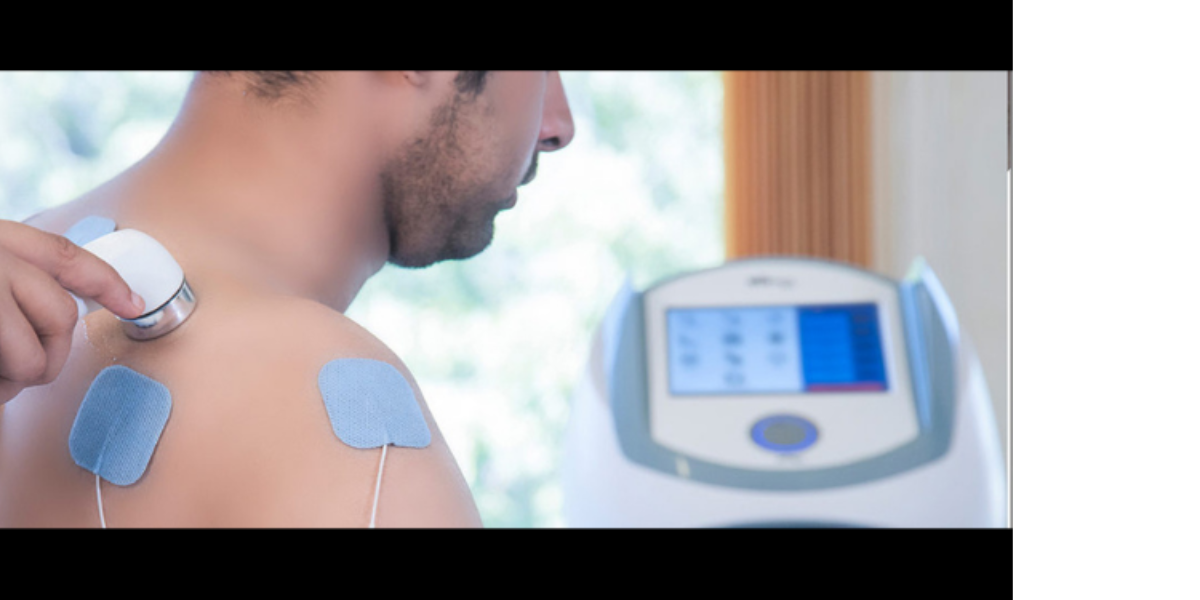
- 15 Mar 2021
- |
- By Admin
5 Benefits of Electrotherapy in Physiotherapy Treatments
The use of electric stimulation in medical treatment, also called electrotherapy, started somewhere around 1750 in Europe, which was soon adopted by doctors in North America. When it comes to physiotherapy, then electrotherapy has been found of great help to manage and give relief to a wide spectrum of pain issues, improve range of motions, and also in severe cases of musculoskeletal conditions in patients.
Electrotherapy in physiotherapy works by passing on a subtle amount of electric impulses or stimulations to the patient’s joints, nerves, tendons, and then measuring the results to find the optimal results.
One of the biggest advantages of electrotherapy is that there are zero side effects, and this is why this mode of treatment has become one of the most preferred ones by both physiotherapists and patients.
Here are the top 5 benefits of deploying electrotherapy in Physiotherapy treatments:
Treatment of Nerve Disorders, Nerve Pain
Nerve pain conditions such as muscle weakness, tingling, numbness, burning, etc can be effectively treated by using electrotherapy on the patients. For this specific purpose, special medical equipment called Transcutaneous Electrical Nerve Stimulation (TENS) is used, wherein the electric impulses are sent to stimulate the sensory nerves to get pain relief. Medically, such electrotherapy works by confusing the pain signal transmitted by the nerves to the brain, and thus, the patient doesn’t feel any pain.
Besides, electrotherapy has been found to be immensely effective in the treatment of facial palsy cases, such as Bell’s Palsy, where the facial muscles get damaged, and they are no longer able to send electrical impulses to the muscles. With electrotherapy, the muscles can receive external electrical stimulation which the facial nerves are not able to provide.
Instant Healing From Musculoskeletal Conditions
In cases of musculoskeletal conditions like tennis elbow, Plantar fasciitis, Jumpers knee, Carpal tunnel syndrome, or general Shoulder pain and injuries, electrotherapy has been found to be of great efficiency in getting instant relief from the pain. Shockwave therapy is used in such cases, wherein the blood flow is increased to the impacted area, which triggers natural healing automatically, and gives relief from pain. In fact, for common sports injuries such as sprains and strains, electrotherapy works like a charm.
Non-Addictive, Drug-Free Treatment
In cases of chronic pain, often the patients are given painkillers which become addictive for the patients, and this has several side-effects. This can be avoided by using electrotherapy for the treatment. Since only electric stimulation is provided, there is no drug usage and no addiction for the patient. This is called non-invasive medical care for providing relief from pain, and for repairing tissues, tendons, and muscles for triggering overall healing. Often, we have seen that usage of electrotherapy prevents invasive medical treatment such as surgeries as well, and this is one of the biggest achievements of electrotherapy.
Prevent Muscle Atrophy
When a muscle is not in use due to any injury or pain or nerve damage, the patient suffers from muscle atrophy, which is the wastage of that muscle. If not treated on time, then muscle atrophy can permanently damage that muscle, and even after the injury is healed, or pain is relieved, the patient won’t be able to use that muscle. Using electrical muscle stimulation (EMS) mode of treatment under electrotherapy, muscle atrophy can be avoided and treated. In EMS, electric stimulation is passed on to the muscle which is not in use, and this way, it contracts and thus, resumes activity.
Increase Blood Flow, Triggering Instant Healing
For wound repair, electrotherapy is one of the best medical treatments. As a result of passing electric stimulation to the wounded part of the body, oxygenated blood is passed on to the cells which bring nutrients and trigger a quick healing process. By enhancing blood flow, not only healing starts but also it removes toxins from the body and helps the tissues to repair faster.
Contact with CureNow Physiotherapy Clinic to find more benefits of electrotherapy for patients, and discover how it can help in physiotherapy treatment.
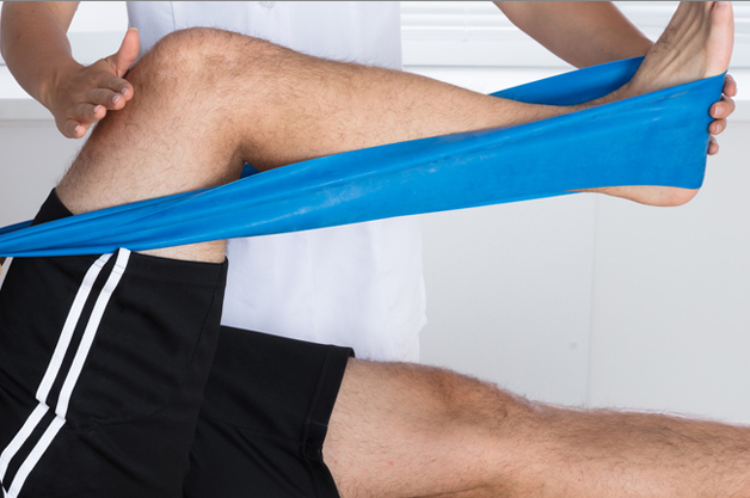
- 10 Mar 2021
- |
- By Admin
An Overview Of Physiotherapy for Orthopedic Treatments
What’s Orthopedic Physical Therapy?
Orthopedic physical therapy can be described as a set of physical therapies for the entire musculoskeletal system of the patient. A physiotherapist who is an expert in orthopedics will be able to recommend the best exercises for treating issues related to bones, muscles, ligaments, joints, and connective tissues.
The patient’s movement diagnosis will be determined in orthopedic physical therapy, along with formulation of a treatment plan, providing therapeutic care, and educating the patient about managing injuries and/or prevalent conditions to lead a normal life.
What Conditions Does An Orthopedic Physical Therapist Treat?
Some of the most common orthopedic conditions that physiotherapy can treat are:
-muscular dystrophy
-arthritis
-cancer
-frozen shoulder
-spinal stenosis
-joint pain
-lower back pain
-knee instability
-limited range of motion
-lymphedema
-plantar fasciitis
-Scoliosis
-Bursitis
Besides these conditions, an orthopedic physical therapist can also help the patient to rehabilitate after surgery or injury. By following the instructions and exercises as recommended by an orthopedic physical therapist, the patient will be able to not only reduce pain but also normalize regular body movements like walking, improvising range of motions, buildup strength, and mobility.
Patients of knee replacement, hip replacement, knee arthroscopy, rotator cuff repair, and even heart and cancer-related surgeries can consult with physiotherapists expert in orthopedic conditions, and start the rehabilitation process.
Physiotherapy For Orthopedic Treatments
Some of the most effective and efficient physiotherapies for orthopedic treatments include (but not limited to)
Exercise Therapy
The most popular and widely used method for treating orthopedic conditions is exercise therapy. This has three main activities: balance-building exercises, mobility and strengthening.
Based on the patient’s existing orthopedic conditions, and the co-morbidities, the physiotherapist will devise a comprehensive and detailed plan for initiating exercise therapy. Initially, the patient can be asked to visit the clinic or hospital to practice the exercises as mentioned in the plan, but as recovery starts, the patient can do the same at their homes.
Traction
Traction is another quite effective physical therapy for patients of neck pain, lower back pain and spine conditions such as degenerative disc and more. With traction, the therapist is able to take the pressure off from the joints which are either compressed or damaged. Once the pressure is removed, the process of healing starts, leading to full recovery.
Usually, there are specialized medical equipment that can be used for traction, while some physiotherapists prefer to use their hands for the same, depending on the severity of the case.
Depending on the requirement, some other alternative physical therapies are used for treating orthopedic conditions including soft tissue manipulation (for muscles, ligaments, and fascia), dry-needling, laser or light therapy, joint mobilization and more.
If you are searching for result-oriented, focused and dedicated physical therapy for orthopedic conditions, then we at CureNow Wellness Physiotherapy can provide you professional consultancy and therapies right away.
We have seasoned Physiotherapists who are certified and trained from the UK, having decades of experience in providing advanced Physiotherapy services.
To start diagnosis and treatment, book an appointment with CureNow Wellness Physiotherapy, today.
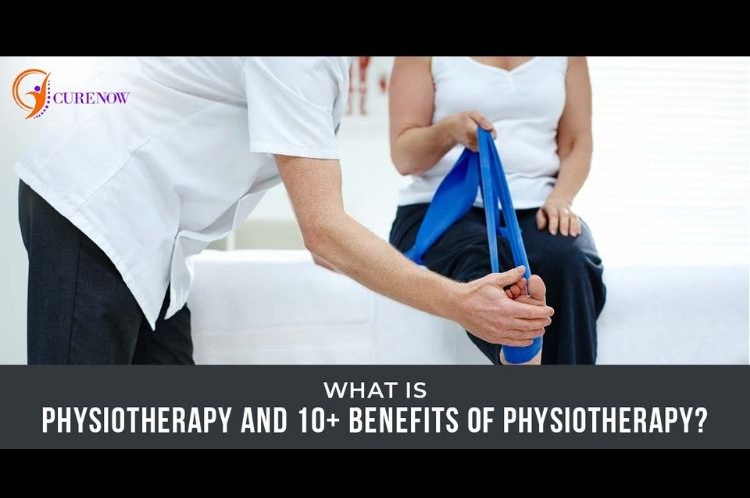
- 24 Feb 2021
- |
- By Admin
What Is Physiotherapy And 10 Benefits Of Physiotherapy?
Physiotherapy, also called Physical Therapy is a healthcare profession and is provided by Physiotherapists, also known as Physical Therapists.
We will share the 10 benefits of physiotherapy, which will showcase why it has now become one of the leading healthcare professions all across the globe.
But first, let’s understand its definition.
What Is Physiotherapy?
Physiotherapy assists and enables patients impacted by illness, injury, or disability to regain their strength, movement, and daily routine via exercises, movements, and education.
Physiotherapy has emerged as the leading healthcare science which helps patients to manage their pain and prevent diseases as well. Physiotherapy also assists patients to recover from trauma, injury and empower them to stay independent and mobile.
10 Benefits Of Physiotherapy
Surgery Can Be Completely Avoided
Often it has been observed that physiotherapy at the right time can help the patient to prevent surgery. This can happen if that pain is eradicated or an injury is healed with proper exercises. In case the surgery is inevitable, then pre-surgery physiotherapy can help the patient to recover faster.
Pain Management
Physiotherapy techniques such as joint, soft tissue mobilization, ultrasound, electric stimulation, etc can be very effective in reducing and minimizing pain for patients. After the due course of physical therapy, such pain is completely eradicated, giving the patient a new lease of life.
Stroke Recovery
Physiotherapy has been found to be an effective strategy to help stroke patients recover and regain their movement and strength. Physiotherapy can help stroke patients not only strengthen their weakened body parts but also improve balance and gait.
Healing Sports Injuries
When it comes to healing and preventing sports injuries, then physiotherapy is considered the best option. Infact, physiotherapists are always a regular inclusion in most of the sporting teams for cricket, football, hockey and more. Timely exercises can also prevent sports injuries from happening in the first place.
Enhances Mobility
Physiotherapy exercises such as strengthening, stretching can help patients to improve their mobility and enable them to move, stand and walk without any trouble.
Managing Diabetes, Vascular Conditions
Proper physical exercises as suggested by Physiotherapists can help manage blood sugar levels in the body, and not only manage diabetes but also help the patient recover from it.
Lungs & Heart Diseases
In the case of a patient recovering from cardiac arrest, physiotherapy can help them to manage their day to day activities and be independent. In case of a lung issue, physiotherapy exercises such as breathing exercises, conditioning, etc can help to clear the fluid in the lungs.
Improve Balance & Gait
Physiotherapy is the best strategy to help someone who has a problem maintaining balance while walking or standing. For improving vestibular functioning, there are physical exercises for the best results.
Age-Related Issues
Age-related issues such as arthritis, joint/hip replacement, osteoporosis, etc can be handled optimally with proper physiotherapy counseling and exercises. While recovering from joint or knee or hip replacement surgeries, physiotherapy is the best option.
Women’s Health
Physiotherapy is recommended for women-specific issues such as pregnancy and post-partum care, wherein physical exercises can help women to handle pain and change in a better way.
If you are looking for the best Physiotherapy consultation and diagnosis, then connect with us at CureNow Wellness Physiotherapy. Our UK-trained Physiotherapists can help you with the right strategy and exercises, for the best results.

- 18 Feb 2021
- |
- By Admin
What Is Facial And Bell’s Palsy And Role Of Physiotherapy In Treating Facial And Bell’s Palsy
Facial nerve paralysis or Facial Palsy is a condition wherein facial muscles are weakened due to permanent or temporary damage to any facial nerve.
Bell’s Palsy is one of the types of facial palsy, in which the patient is unable to control the facial muscles on the side of the face which is impacted due to the paralysis.
Reason For Facial Palsy And Bell’s Palsy
The exact cause of Bell’s Palsy is still unknown. However, in most facial palsy cases, it has been observed that when any facial nerve fails to function or is missing, then the muscles in the face fail to receive the signals for proper functioning, and it results in the paralysis of that side of the face.
For Bell’s Palsy condition, risk factors are diabetes, pregnancy, and/or upper respiratory tract infection which happened recently.
Symptoms Of Bell’s Palsy
Here are some of the symptoms of Bell’s Palsy condition:
●The patient is not able to close the eye on the side of the face which is impacted
●Uncontrolled drooling from the impacted side of the mouth
●The patient’s eyes will feel dryness and teariness
●Pain in the ears, of the side where it's impacted
●Extreme sensitivity to sound
●Drooping of the impacted side of the face
●Sense of taste is somewhat lost
●The patient will find it difficult to speak since this condition will make the muscles around the mouth weak
How Can Physiotherapy Help In Bell's Palsy Treatment
These three stages of exercises, which Physiotherapists recommend for treating Ball’s Palsy and triggering improvements rapidly:
Stage 1: Initiation Exercises
In this stage, the Physiotherapist will ask the patient to do some exercises which will cause the muscles around the face to move, thereby enabling facial movement. Via an assisted range of motions, the patient will be taught how to position their face for easy movement. These initiation exercises set the foundation for the next stage.
Stage 2: Facilitation Exercises
Once the facial movements start happening, and the patient is aware of how to trigger facial muscles to do what they want them to do, then comes the stage for Facilitation exercises.
In this stage, the patient is taught exercises to strengthen facial muscles, increase their activities and use the facial muscles for a longer duration of time. Movement control exercises are generally employed here, which will help the patient to refine their facial movements for specific activities such as speaking, or closing eyes.
Any abnormal patterns of facial movement can also be rectified via facilitation exercises.
Stage 3: ElectroGalvanic or Faradic Stimulation
This is the most important in treating Facial or Bells palsy.
In this treatment method the doctor passes a stimulation current of faradic or galvanic current through a pen electrode to the points on the paralysed face muscles so as to reactivate it.
It has almost 70% positive outcome in most cases.
At CureNow clinic we have the most Advanced Stimulation device having Intermittent Galvanic & Surged Faradic mode.
Stage 4: Relaxation Exercises
During the 1st two stages, the patients can experience facial spasms or twitches, which is quite normal in the recovering patients of Bell’s Palsy. In order to control this, the Physiotherapist will teach the patient how to differentiate between relaxation mode and active mode.
The patient will be taught how to forcefully contract facial muscles, and then willfully stop, for better control over them. Gradually, spasms and twitches will go away, improving the recovery from this condition.
At CureNow Wellness Physiotherapy, our UK-trained and certified Physiotherapists will be able to diagnose Bell's Palsy and provide you with the right physical therapy for fast healing.
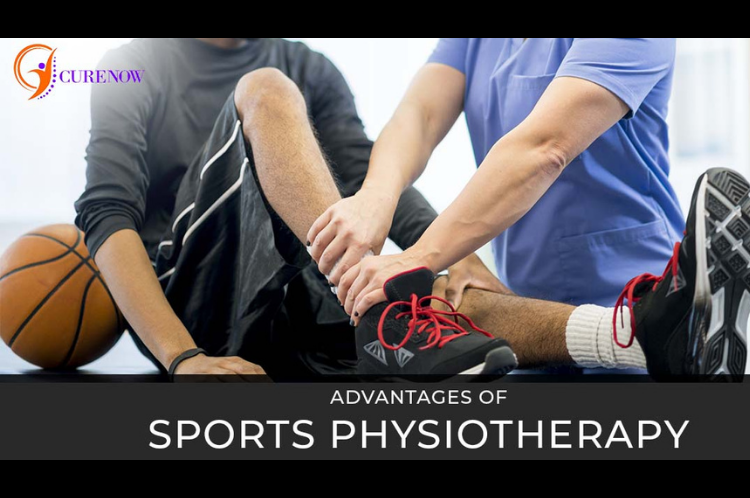
- 11 Feb 2021
- |
- By Admin
Advantages of Sports Physiotherapy
What Is Sports Physiotherapy?
Sports Physiotherapy is a niche specialization within the Physiotherapy world, which specifically focuses on treating sports-related injuries, and offers preventive care and strategies which can avoid sports injuries in the future.
Before we share how the advantages of Sports Physiotherapy, let’s first understand what exactly are sports injuries.
Any kind of injury occurring while engaging in sporting or outdoor activities is referred commonly to as a sports injury, and it’s quite different from normal day-to-day injuries one encounters.
Although a sports injury can hit any part of the body, any injury happening to the musculoskeletal system of the human body is referred to as sports injury in medical terms.
Some of the common sports injuries include (but not limited to) are:
●Sprains, wherein ligaments that join bones are injured. Commonly impacted body parts are wrists, knees, and ankles
●Strains, wherein the muscles and/or tendons are pulled or teared
●Shin Splints, or pain in the outer front of legs which happens most commonly to runners
●Achilles tendonitis, wherein the tissues connecting the calf muscles to the heel are injured
●Fractures of bones
●Joints getting dislocated
Physiotherapy is strongly recommended for treating sports injuries, as it has some inherent advantages over other mediums of treatment.
Besides, proactive sports physiotherapy has several advantages in preventing sports injuries.
Here are the top advantages of Sports Physiotherapy:
Prevent Injury
Prevention is always better than cure, and this fact is more evident while handling sports injuries. Physiotherapists can quickly observe early symptoms such as inflammation or weak muscle, and suggest the best exercises which can prevent injuries in the future. If a person active in sports and outdoor activities wish to prevent sports injuries, then Physiotherapy is the best way forward.
Improving Strength
One of the biggest side-effects of any sports-related injury is the weakening of muscles, joints, and ligaments, which directly impacts the bone structure and the performance of the sportsperson on the field. With regular physiotherapy and the right exercises, the patient can build up the strength of ligaments, joints, bones, and muscles, and enhance their performance.
Improved Flexibility
Physiotherapy strategies such as stretching greatly enhance the overall flexibility of the patient, who is recovering from a sports injury. Flexibility training can be devised for those, who are feeling a certain tightness around their joints, and the overall range of motions can be vastly improved, thanks to physiotherapy.
Enhance Cardio Fitness, Improved Endurance
With sports injuries, the endurance level of the patients is reduced, which can be enhanced and improved with the right physiotherapy exercises. Besides, with cardiopulmonary training, the cardio fitness of the patients also improves. With better endurance, cardio fitness, and breathing, the sportsperson is able to perform better in their respective sports.
Helps In Relaxation
After the adrenaline rush, while running or engaging in a sporting activity, it’s important to relax and calm down. In this endeavor, sports physiotherapy has the best solutions. There are specific exercises for relaxing muscular tension, which helps the sportsperson to calm down and relax. Besides, there exist several breathing exercises that relax the mind and body of the sportsperson and help them destress in a short time.
If you are looking for a sports physiotherapist, then look no further. CureNow Wellness Physiotherapy provides world-class sports physiotherapy for sportspersons and those who engage in sporting activities. Our UK trained sports physiotherapists are certified and experienced to provide the best physical therapy consultation for you.

- 19 Jan 2021
- |
- By Admin
What Is Frozen Shoulder? How Can Physiotherapy Give You Relief From Frozen Shoulder?
Frozen Shoulder: Definition
Medically termed as Adhesive Capsulitis, a frozen shoulder is a painful condition wherein the movement of the shoulder becomes restricted and limited. When the patient attempts to do any activity which requires shoulder movement, moderate to severe pain is experienced.
The state of the frozen shoulder usually happens when the connective tissues around the shoulder joint become stiff, inflamed, and thick. Some experts also claim that a frozen shoulder can happen due to autoimmune reactions, due to several reasons.
Reasons Behind Frozen Shoulder
Some of the possible reasons include:
-Immobilized arm for a long period of time. For example, the patient had a fracture, and the arm was in a sling for an elongated period.
-The patient is already suffering from another cause, such as arthritis, or bursitis, or even a rotator cuff tear, tendonitis, etc. The pain from such conditions can trigger a frozen shoulder.
-A reaction to the shoulder from an injury or accident
How To Diagnose Frozen Shoulder?
In most of the cases, it has been observed that the diagnosis of frozen shoulder happens very late, usually after 3-4 months since the patient encountered the 1st symptoms.
This is because the patient assumes that the pain will go away and he/she continues with daily activities while tolerating the pain.
In order to properly diagnose the condition of frozen shoulders, the Physiotherapists will look out for the capsular pattern, which is a decreased range of motions due to the pain associated with frozen shoulders.
Proper health history is investigated, and the therapists look for some general conditions which are usually associated with frozen shoulder patients such as diabetes, autoimmune disorders, and/or thyroid disorders.
How Can Physiotherapy Give Relief From Frozen Shoulder?
Effective and timely physiotherapy can help patients with frozen shoulder to restore their normal activities and body movements, without pain.
The main goal of physiotherapy in the cases of frozen shoulder is to restore the movements, via targeted exercises and physical therapy.
There are 4 stages of treatment involved here:
Stages 1 and 2
Using a combination of a range of motion exercises and manual therapy, the physiotherapist will attempt shoulder movement, with minimum pain. The patient is advised not to resort to aggresive exercises, else the pain may become worse.
Besides, home-based treatment will be also suggested, based on the severity of the pain.
Some medications can also be prescribed, to manage the pain.
Stage 3
While Stages 1 and 2 are focused on maintaining shoulder movements with the minimum, bearable pain, Stage 3 is designed for return of motion.
Physiotherapists recommend stretching exercises, strengthening exercises, and manual therapy so that the muscles and tissues loosen up and there is more flexibility and more movements.
Stage 4
While the steps of Stage 3 are repeated in this phase, the focus here is to return to the normal. During Stage 4 therapy, the patient is encouraged to return to his/her normal range of motions, conduct normal day to day activities in a painless environment.
If you are seeking expert guidance and therapy to get relief from shoulder pain, then we at CureNow Wellness Physiotherapy are there to help you. Our UK trained and certified physiotherapists are experienced and seasoned, with deep knowledge and expertise of treating frozen shoulder condition.

- 16 Dec 2020
- |
- By Admin
Definition & Scope Of Orthopedic Physiotherapy For Injury And Trauma
Orthopedics is the branch of medicine, which studies muscular and skeletal systems in the human body. In case there are any injuries, deformities, or disorders related to our joints, muscles and bones, then it comes under orthopedics.
In this blog, we will understand more about orthopedic physiotherapy, and the scope of orthopedic physiotherapy for injuries and trauma.
To start with, what exactly is orthopedic physiotherapy?
Definition Of Orthopedic Physiotherapy
When physical therapy is conducted for the musculoskeletal system in our body, then it’s called Orthopedic Physiotherapy.
Musculoskeletal system provides stability, movement, and form to the human body, and consists of:
-Bones
-Muscles
-Tendons
-Ligaments
-Joints
-Cartilage
-Other connective tissue
-Synovium
-Bursae
-Fascia
Hence, physiotherapy applied for treatment and improvement of the functions of these components under the Musculoskeletal system is Orthopedic Physiotherapy.
When Orthopedic Physiotherapy Is Applied?
In case of injury or trauma to the musculoskeletal system in our body, orthopedic physiotherapy is applied to improve the condition and to enable the patient to recover his/her original posture, movement and stability.
Orthopedic Physiotherapy can be applied in cases of:
-Sprains
-Post fracture treatment
-Post-surgery treatment
-Repetitive injuries
-Strains
-Sports injuries
In some extreme cases, the patient’s neck and back can also be included under Orthopedic Physiotherapy.
Who Is An Orthopedic Physiotherapist?
Orthopedic Physiotherapist is an expert who can diagnose, manage and treat orthopedic conditions in those patients whose musculoskeletal system is impacted by injuries and disorders.
An orthopedic physiotherapist also conducts various rehabilitation programs for patients who have undergone orthopedic surgeries.
Some of the orthopedic cases where an orthopedic physiotherapist can provide his/her expertise:
-Post-operative joints
-Acute sports injuries
-Arthritis
-Cartilage damage
-Amputations
-Work injuries
-Lyme disease
-Rehabilitation Management
-ACL Tear
-Knee Instability
-Meniscus tear
-Patella pain
-Hip bursitis
-Hip pain
-Achilles tendon injuries
-Plantar fasciitis
-Tennis elbow
-Wrist pain
-Golfer’s elbow
-Clavicle fracture
-Frozen fracture
-Rotator cuff tear
-Degenerative disc disease
-Scoliosis
-Spinal stenosis
-And more
How Can Orthopedic Physiotherapy Help You?
The orthopedic physiotherapist will diagnose the patient, and depending on the prevailing condition, the appropriate physical therapies and treatments are designed.
Mainly, there are 5 types of therapies involved here:
Therapeutic modalities
In this, the physiotherapist may use ultrasound, ice, water, heat, electrical stimulation, ry needling, or laser to improve blood flow, reduce swelling, enhance relaxation and reduce pain.
Assistive devices
Depending on the severity of the orthopedic condition, the physiotherapist may recommend the usage of assistive devices such as braces, walkers, canes, crutches, slings during or after the therapy session.
Assessment and evaluation
This is an ongoing process, which starts from day 1. The therapist will closely observe you, and your movements and how it impacts your life. This starts before the physician therapies are designed, and then during the exercises, and after the exercises end.
The objective is to take note of the patient’s balance, posture, range of motion, strength and pain, which directly influences the orthopedic exercises.
Mobilization and massage
Both mobilization and massage are used to get the muscles and joints moving, and to improve blood flow. The patient can be administered hands-on manual therapy, wherein the joints and bones are manually moved by the therapist.
Exercises
These 4 above mentioned tools and strategies are mainly for improving the movement. However, the most important aspect is exercising, which is done by the patient and helps them recover faster.
The exercises are suggested and recommended by the Orthopedic Physiotherapist only, which will help the patient to improve and increase endurance, range of motion, flexibility, balance, mobility, and strength.
Consult with our expert Orthopedic Physiotherapists at CureNow to find out how we can help the patients recover from orthopedic conditions.
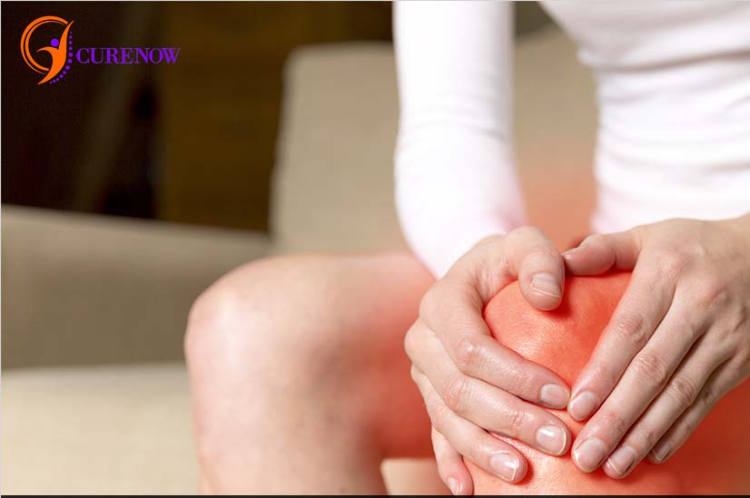
- 08 Dec 2020
- |
- By Admin
What Is Knee Pain? What Are The Symptoms & Causes Of Knee Pain?
Did you know that knee is the largest joint in the human body, and being a simple hinge joint, it allows only flexion and extension?
But these are two of the most important movements for a human, and this is the reason that knee is vulnerable to more injuries than any other joint.
Knee constitutes of bones, cartilage, ligaments, and tendons, all arranged in a complex mixture which leads to issues such as tears, fractures, sprains, strains, and degeneration.
In this article, we discuss knee pain, and the general symptoms and causes of knee pain. And in the end, we will share the solution for the same.
What Is Knee Pain?
There is no age factor when it comes to knee pain. Being an important joint, knees are prone to injuries and tears, which leads to knee pain. And this can happen anytime, with anyone.
Injuries are one of the most common reasons for knee pain, which can lead to a ruptured ligament or damaged cartilage, resulting in knee pain.
There can be medical conditions for knee pain as well, such as arthritis, gout, and infections.
While minor knee pain gets healed themselves, or by self-care measures, severe knee pain requires physical therapy, and in some cases, knee braces.
Complex knee conditions and injuries may require surgical repair as well.
Symptoms Of Knee Pain
The most common 5 symptoms of knee pain are:
●Abnormal swelling of the knees, along with stiffness. A clear sign of knee pain.
●The skin around the knee can get red, and feel warm while touching
●Sudden weakness and/or instability while walking or standing
●While the knee is moved, a popping or crushing sound is heard
●Knee cannot be strengthened fully, as the patient experiences difficulty in doing so
If the patient experiences any of these symptoms, then it can be a case of knee pain.
Causes Of Knee Pain
●Injuries
Injuries are the most common type of causes, which leads to knee pain.
An injury can happen to: ligaments, tendons or the fuel-filled sacs that surround the knee, which can lead to mild or severe knee pain. Besides, injury can also happen to the bones, cartilages, and ligaments which form the knee joint, leading to knee pain.
Some examples of injuries that can lead to knee pain are ACL or anterior cruciate ligament injury; fractures; torn meniscus, knee bursitis, Patellar tendinitis and more.
●Existing Medical Conditions
In case of any existing medical condition, knee pain can suddenly or gradually erupt, which should need proper attention. For example, degeneration of bones or cartilage. In such a situation, a piece of bone or cartilage can break off and float in the joint space. If this disrupts the normal knee movement, then it can lead to knee pain.
Oter examples being Iliotibial band syndrome, Dislocated kneecap, hip pain, or arthritis.
Types Of Arthritis Which Leads To Knee Pain
Although there are hundreds of different forms of arthritis, some among them can lead to knee pain, becoming a cause and reason.
Some of these types of arthritis include:
●Osteoarthritis (when cartilage deteriorates with age and use)
●Rheumatoid arthritis (chronic disease)
●Gout
●Pseudogout
●Septic arthritis
Don’t ignore your knee pain, as it can lead to more severe cases. Consult with expert Physiotherapists at CureNow, and start your treatment right away.
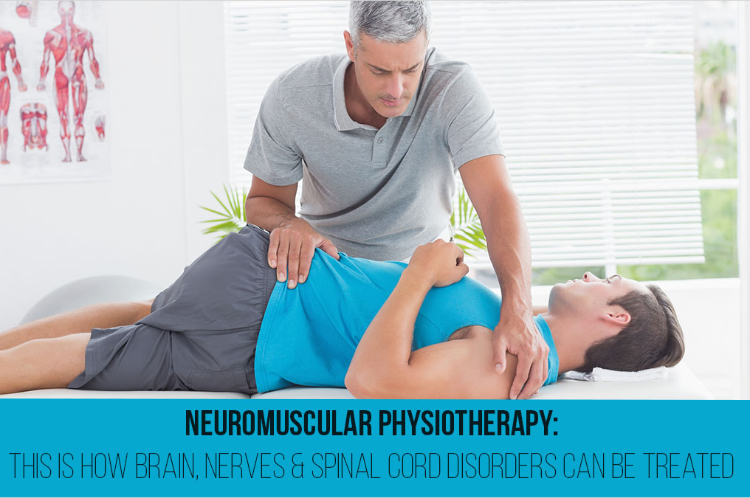
- 19 Oct 2020
- |
- By Admin
Neuromuscular Physiotherapy: This Is How Brain, Nerves & Spinal Cord Disorders Can Be Treated
Neuromuscular disorder is a broad term, which encompasses ailments and diseases related to impaired functioning of muscles and nerves.
Either it can happen directly, wherein the concerned muscles is impacted, or indirectly, wherein the concerned nerve is impacted, thereby disrupting the functioning of the neuromuscular junction (a chemical synapse between a motor neuron and a muscle fiber) Neuromuscular Physiotherapy is suggested and applied in cases of disorders related to neuromuscular, which concerns brain, nerves and spinal cord.
What Are The Common Conditions in Neuromuscular Disorders?
Some of the most common conditions associated with neuromuscular disorders are:
- Brain injury
- Stroke
- Parkinson's Disease
- Guillain-Barré Syndrome
- Muscular Dystrophy
- Limb girdle muscular dystrophies (LGMD)
- Multiple Sclerosis
- Neuropathy
- Congenital myopathies
- Neurogenic arthrogryposis and other neurogenic conditions
- Mitochrondial, inflammatory, or storage disorders
How Physiotherapy Can Help In Treating Neuromuscular Disorders?
Broadly speaking, Neuromuscular Disorders directly impact movements of the patient - They find it difficult to move their muscles, hence find it tough to accomplish normal body functions such as walking, running, jumping, since their muscles lose strength.
In the case of children, these conditions stops their normal growth and both mental and physical growth is impacted.
And this is where Neuromuscular Physiotherapy can help the patients.
A Neuromuscular Physiotherapist will start the treatment with 4 main objectives:
- Maximize function of the muscles
- Maintain independence
- Increase mobility and strength
- Prevent pain and encourage normal body movements
In case of brain and spine injuries, there can arise some secondary complications as well, such as contractures and curvature of the spine (scoliosis). Via Neuromuscular Physiotherapy, such secondary complications can be handled and minimized to a greater extent by observing and monitoring the changes which can erupt.
In some cases of neuromuscular disorders, the patient has difficulty breathing. Physiotherapists can also provide respiratory exercises to improve this condition and enable the patient to breathe without any difficulty.
Via respiratory physiotherapy, lungs can be cleared of secretions, and the effort for breathing can be reduced.
What Is Involved In Neuromuscular Physiotherapy?
The exact physiotherapy exercises and procedures are determined only after an in-depth and thorough assessment of the patient, and understanding the inherent problems associated with the brain, spine and nerves.
Some of the most common rehabilitation techniques which we employ for patients of neuromuscular disorders are:
- Stretching exercises
- Strength training
- Mobility training
- Gait training
- Neuromuscular retraining
- Functional training
- Pain management
The goal and objectives of Neuromuscular Physiotherapy is obtaining an equilibrium in the body movements, especially in those areas which are severely impacted due to muscle and nerve disorders.
Via exercises, the patient is taught and trained how to acquire postural control in situations which resemble daily, normal day to day functioning, and then gradually, more demanding activities. The patient can gradually improve range of movement and flexibility, with regular and professional physiotherapy treatment.
In order to initiate Neuromuscular Physiotherapy, please consult with our physiotherapists, and find out how physiotherapy can help the Brain, Nerves & Spinal Cord Disorders.

- 14 Oct 2020
- |
- By Admin
Spinal Cord Injury: 3 Spine Physiotherapy Treatments Recommended By Experts
Spinal cord injury or SCI happens when a part of the spinal column is damaged which leads to
permanent or temporary changes to sensations, strength and body functions below the location
of the injury.
SCI has some long term socio-economic impact on individuals, and it’s estimated that between
250,000 to 500,000 people are dealing with this type of injury today, across the world.
In India, upto 15,000 new cases of spinal cord injury is reported every year.
Thankfully, due to advances in medical technologies, there are various options available under
physiotherapy to treat SCI, and bring down its impact which enables the patients to carry on
their day-to-day activities and heal faster.
Note here, that the treatments prescribed under spine physiotherapy will depend on the level of
injury, the damage done on the spinal cord, and the objectives and goals of the treatment.
For example, a cervical spinal cord injury is considered as more severe and complicated,
compared to a lumbar spinal cord injury.
Here are three spine physiotherapy treatments, recommended by experts for spinal cord
injuries.
- Conventional Physiotherapy
The primary goal of conventional physiotherapy is to help the patient manage pain arising from
SJI in a better way by improving blood circulation, and prevent/reduce further muscle atrophy,
and contractures via hands-on therapy.
This is done via extensive hands-on exercise therapy, and stretching maneuvers, depending on
the intensity of the injury, and the site of the injury.
Three main types of Conventional physiotherapy are muscle stretching, joint manipulation and
neurodynamic exercises. Other types of exercises under this can be massage therapy and
acupuncture.
- Activity-Based Therapy
Activity-based therapy, also known as activity-based restorative therapy (ABRT) is an emerging
therapeutic based treatment for spinal cord injuries, as well as neurological conditions and
disorders, including traumatic injuries.
The objective of activity-based therapy is to encourage and enable neuroplasticity via strength
training and gait training. Normally, this type of physiotherapy includes a lot of repetitive muscle
movements, as prescribed by the physiotherapist based on the level of injury, and the goals of
the treatment.
Unlike other forms of treatment, activity-based therapy allows the patient to be in a standing
position, rather than sitting in a wheelchair or lying down.
Activity-based therapy can help the patients of spinal cord injury to avoid health issues such as
Bowel function issues, Urinary tract infections, skin ulcers, muscle spasms, respiratory issues,
Osteoporosis, and more.
- Functional Electrical Stimulation Therapy
Functional Electrical Stimulation or FES is another emerging therapy under spine physiotherapy
for SCI patients.
In this, brief electrical pulses are applied va electrodes, to the paralyzed or weakened muscles.
This helps the patient to improve and restore the function of that muscle.
Via FES, patients have been observed to improve their lungs and heart function by a larger
degree, and also boost bladder and bowel functions by increasing the overall mobility and
strength of the muscles.
Often, physiotherapists create a combined treatment which includes Functional Electrical
Stimulation and physical exercises, which helps the patient to heal and recover faster.
For more information on Spinal Physiotherapy, consult with our expert Physiotherapists right
here.

- 06 Oct 2020
- |
- By Admin
What Is Cardiovascular Physiotherapy? What Are The Benefits Of Physiotherapy In Cardiac Rehab?
When it comes to cardiac rehabilitation (CR), then physiotherapy can be an effective way to help patients recover faster and better. Physiotherapy helps reduce mortality rates, reduce hospital time for the patient, and lead them towards a healthy and improved way of living.
Before we share the inherent advantages of Physiotherapy in cardiac rehabilitation, let’s first try to understand the primary cause of heart diseases, and why physical exercises and therapy holds the key to a faster recovery.
Reason Behind Most Of The Heart Diseases
Cardiovascular disease (CVD), which in layman term refers to heart diseases, is a leading cause of death and disability globally.
In 2016, approximately 30% of global deaths happened due to heart diseases.
Diseases that strike the cardiovascular system, such as heart, arteries, and blood vessels, are caused when coronary arteries get blocked for various reasons. Accumulation of fatty substances is one of the primary reasons for the narrowing of arteries, and this causes heart attack, angina, stroke, pulmonary heart disease, heart failure and
atrial fibrillation.
The rehabilitation of such patients who are suffering from Cardiovascular disease is a long-term, multi-stage process.
It’s here that Physiotherapy can make a world of difference to the rehabilitation process and enable the patient to recover faster. In fact, the timely intervention of physiotherapy can prevent heart diseases in the first place.
And the primary reason why this happens is an emphasis on Physical Activities and Exercises.
Why Cardiovascular Physiotherapy?
As per various studies, it has been found that physical inactivity is one of the main reasons behind the development and progression of cardiovascular diseases.
Cardiovascular Physiotherapy is a set of physical activities and exercises, which have been designed and conceptualized by Physiotherapists for those who are recovering from heart diseases and those who are vulnerable to such diseases in the future.
This way, structured and focused physiotherapy helps in triggering full-fledged recovery and helps in the prevention of heart diseases.
Two very important factors: Weight loss, and low blood pressure, can be achieved by Cardiovascular Physiotherapy, which can be lifesaver for CVD patients.
Benefits of Cardiovascular Physiotherapy
Reduced Mortality Rate
The biggest and most visible benefit is reducing mortality rates among CVD patients, by a huge margin.
As per research findings shared by the UK based The Association of Chartered Physiotherapists in Cardiac Rehabilitation (ACPICR), it was found that every one metabolic equivalent (MET) increase in aerobic fitness leads to upto 17% less mortality rate. (Source)
Improved Fitness, Overall Health
Structured and dedicated Cardiovascular Physiotherapy leads to improved fitness and weight loss, which directly impacts the heart’s condition, leading to a speedy recovery.
Weight loss leads to low blood pressure, leading to the patient's overall health and fitness.
Speedy Recovery From Hospital
With improved fitness comes a massive boost in the patient's morale, as they feel and act more confident, which means speedy recovery from the hospital.
Once the exercise schedule is set and followed, the patient is slowly and gradually able to conduct their day to day activities and defeat cardio diseases.
If you are looking for expert and experienced Physiotherapists for issues related to cardiac rehabilitation or prevention of cardiac diseases, then CureNow can help you right away.
Consult with our certified Physiotherapists having years of experience in Cardiovascular Physiotherapy, and start the recovery process right away.

- 01 Oct 2020
- |
- By Admin
What Is Musculoskeletal Physiotherapy?
The human musculoskeletal system, also known as the locomotor system is an organ system, which enables human beings to move, using their muscular and skeleton systems.
It provides form, support, stability, and movement to the body.
Musculoskeletal Physiotherapy is advised and applied when the patient is not able to move, or there is pain due to the movement and the balance between joints and muscles is disturbed and they are not in sync with each other.
In layman terms, Musculoskeletal Physiotherapy involves the treatment of Musculoskeletal Pain, which impacts muscles, ligaments and tendons, and bones as it causes difficulty in movement.
The focus areas for Musculoskeletal Physiotherapy can be your arms, legs, feet, ankles, shoulders, back or neck.
Symptoms Of Musculoskeletal Pain
Some of the common symptoms associated with Musculoskeletal Pain are:
- Pain during moving arms/legs/neck/shoulder
- Weakness
- Stiffness in joints and muscles
- Decreased range of motion
- Joint noises
- Swelling/inflammation
- Tenderness
- Impaired function
- Fatigue
- Sleeplessness
Causes Of Musculoskeletal Pain
- Damage of muscle tissue due to wear and tear of daily activities
- Trauma caused to a specific body part, due reasons such as jerking movement, accidents, fractures, fall, sprains, dislocation etc
- Postural strain
- Repetitive movement
- Prolonged immobilization
- Spinal Alignment Problem
- Muscle Shortening
Often the pain is concentrated in one area such as neck or arms or wrists. However, in conditions like fibromyalgia, the pain is spread all across the body.
When the Musculoskeletal Pain originates and ends within a short span of time, it’s known as acute pain, and can last for few days to maybe couple of weeks.
But if the pain continues for more than 3-6 months, then its chronic pain, and focus should be on treatment, as soon as possible.
Some of the common disorders associated with Musculoskeletal Pain are: arthritis, osteoporosis, fractures and dislocations, arcopenia or muscle loss, scoliosis and more.
Treatment Of Musculoskeletal Pain
Musculoskeletal Physiotherapy is considered one of the best treatments for Musculoskeletal Pain. Depending on the location of the pain, and the severity, various exercises can be applied which improves range of motion, strengthening of the joints and improve overall movement and mobility.
Here are some of the physiotherapy exercises and activities recommended are:
- Manual therapy techniques such as joint mobilizations, manipulations
- Soft tissue techniques such as myofascial release, PNF, stretches, trigger point technique, massage
- Muscle strengthening and stretching exercises
- Electrotherapy options
- Posture assessment and exercises
- Ultrasound
Besides these, some other therapies and treatment for Musculoskeletal Pain are:
- Physical Occupational Therapy
- Acupuncture and Acupressure
- Relaxation and Biofeedback therapy
- Osteopathic manipulation
- Therapeutic massage
- Chiropractic care
- Topical analgesic such as creams, ointments, gels, lotions
Besides, some doctors also suggest Non-steroidal anti-inflammatory drugs, or NSAIDs which should be only taken based on medical prescription and the advice of the doctor. These are primarily pain-killers and not a permanent solution to the problem.
Consult with our expert Physiotherapists at XYZ Clinic, and find out the best possible way to treat and minimize Musculoskeletal Pain and discover how Musculoskeletal Physiotherapy can help you with it.

- 24 Sep 2020
- |
- By Admin
The Role Of Physiotherapy In Sports Injuries: Treatment, Prevention, Rehabilitation
Definition Of Sports Injury
Sports injuries happen when a body part is made to experience a force that is greater than its capacity to structurally withstand. As the name suggests, sports and activities are the reason for this type of injury, and is fairly common, across the world.
It can happen due to lack of activity from the patient before undergoing a sports activity, overtraining, lack of conditioning, improved technique of conducting a sporting activity, or simply an accident while indulging in sports.
Some very common types of sports injuries are sprains, tears, fractured bones, bruises and strain. Soft tissues such as muscles, ligaments, tendons, fascia, and bursae are the most vulnerable to sports injuries.
There are mainly two types of sports injuries: Acute and Chronic.
Suddenly an awkward landing can lead to a sprained ankle, and this is acute sports injury.
Whereas repeated overuse of muscles or muscle groups or joints can lead to chronic sports injury, such playing tennis with a wrong technique for years, can lead to tennis elbow, a chronic sports injury.
Physiotherapy For Treating Sports Injury
Experts recommend 5 types of physiotherapy exercises for treating sports injuries:
- Range Of Motion (ROM): During Range Of Motion exercises, physiotherapists are able to reduce stiffness of muscles, and joints arising from sports injuries. Depending on the type of injury, ROM can be active (when patient does the exercises by own) or passive (when the physiotherapist conducts the exercises)
- Strengthening: Using a range of exercises, a physiotherapist is able to strengthen the weak muscles and joints. There are two types of strengthening exercises: Static and Dynamic. In static, pressure is applied on the muscles without any movement of the joints such as squat position or push-up position. Walking, running and lifting weights are examples of active strengthening exercises that keeps the muscles in movement.
- Low Level Laser: In case of musculoskeletal sports injuries, low level laser can be applied, wherein the power of light is used to reduce inflammation and muscle pain.
- Ice Pack: This can be the first treatment for any sports injury. Applying a pack of ice in the impacted area can reduce excessive swelling.
- Hot Pack: In case of chronic sports injury, which has been lasting for more than 3 months, hot packs can be applied to provide relief from stiffness and pain.
Physiotherapy For Preventing Sports Injury & Rehabilitation
Besides treating sports injuries, physiotherapy plays a very crucial role in preventing sports injuries in a methodological way, and rehabilitation of the patients gradually and with confidence.
In 1992, Van Mechelen proposed a 4-step sports injury prevention model, which is widely used by physiotherapists worldwide:
- Find out the extent of sports injury in a set of the population via surveillance
- Identifying the risk factors for injury in a population
- Development and validation of strategies for preventing injuries
- Measuring the impact of the strategies to prevent injuries via surveillance methods
Likewise, physiotherapy is deployed for the rehabilitation of the patients who have recovered from sports injuries. Depending on the extent of the injury, physiotherapists can create a strategy for rehabilitation of the patient, in stages.
The process can include mobilization, strengthening exercises, kinetic chain exercises (open/closed), sports specific drills, functional recovery exercises, muscle conditioning and more.
For more information on sports injury treats, prevention and rehabilitation, consult with our expert physiotherapists right here.
© Copyright CURENOW . All Rights Reserved. Presented By
RISIAR Step In Business Hub Pvt Ltd